July 30, 2017
Sirens and Scheherazade: Prom 18
For his largest and longest work to date, Sirens, Swedish composer Anders Hillborg has turned to Homer’s account of Odysseus being bound to his ship’s mast so that he might hear the eponymous enchanters’ song but resist its lure - and thus avoid the fate of the shipwrecked sailors who have been enticed to their doom on the rocky coast of the sirens’ island. Commissioned by the Los Angeles Philharmonic and first performed in 2011, Sirens was receiving its UK première in this Prom the theme of which was heroics on the high seas.
Homer does not name his sirens but he does give their number as two, and Hillborg’s work is scored for two solo sopranos, mixed chorus and large orchestra. The roles of the mantic temptresses, who with increasing desperation attempt to mesmerise Odysseus with their song, were taken by Swedish sopranos Hannah Holgersson and Ida Falk Winland, who recorded Sirens with the Royal Stockholm Philharmonic Orchestra, Swedish Radio Choir and Eric Ericson Chamber Choir, conducted by Esa-Pekka Salonen, on the BIS label in 2015. Here, the sopranos were joined by the BBC Symphony Orchestra and Chorus under the American conductor James Gaffigan, who was making his Proms debut.
It’s always tempting to identify what is described as a ‘Nordic’ sound - what we imagine as a musical embodiment of the cool stillness and spaciousness of the landscape - and Hillborg’s spectral whispers, chord clusters, sustained harmonies and minimalist gestures might encourage one to use this label. We hear weeping winds; strain after the highest-lying violins; feel dark, unearthly tremors.
Hillborg has stated that the challenge was to create music that was simultaneously irresistibly beautiful and unnervingly menacing. Certainly, both the sensuous and the uneasiness deepened with the entry of the chorus whose floating cries and whistles reverberated around the hall. Time and movement seemed suspended, as if we were falling into a void. Textures would accumulate, as the sound mass seemed almost to tremble; then an individual instrumental voice would pierce through, a ghostly presence. A high ringing ‘whine’ was produced by the percussionists’ fingers, sliding along the edge of two glasses.
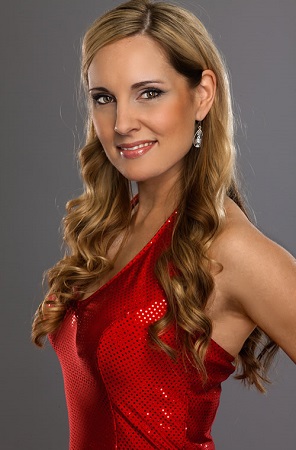 Hannah Holgersson. Photo credit: Mats Oscarsson.
Hannah Holgersson. Photo credit: Mats Oscarsson.
Winland took the higher of the two solo parts, her soprano rising above the massed sound with crystalline purity and sheen, but Holgersson’s lower lying melodies communicated with equal impact and strength, and the two singers’ voices blended persuasively.
There is no doubt that Sirens is intoxicating. I felt like Odysseus himself, hypnotised and compelled to submit to the sonic beauty of Hillborg’s score. The dreamlike ambience is dangerously destabilising: are the voices Odysseus hears real or imagined?
What was less satisfying was the absence of any definition in the delivery of the text - essentially this was wordless vocalise - with the result that the work had no clear narrative character, though Gaffigan did convey the musical structure’s sense of accumulating danger. Moreover, the text is a combination of Homer, translated into English, and Hillborg, but the latter’s anachronistic contributions sit uncomfortably against Homer’s poetry: ‘Breathe them, hear them, plunge into them. Drown in their sweetness, We’d love to turn you on.’
At the end of Homer’s episode, the sirens declare, ‘No life on earth can be hid from our dreaming … We will take you to the crack between the worlds’. Sirens drifts ambiguously into silence: has Odysseus sailed on, and the defeated sirens perished, or has he succumbed?
The concert opened with the swashbuckling swagger of the overture of Erich Korngold’s score for the 1940s classic film The Sea Hawk in which Errol Flynn played ‘Geoffrey Thorpe’, the fictional Elizabethan privateer who commanded marauding raids against the Spanish fleets to fill the coffers of the English treasury. (At the time, commentators noted parallels between the film and the contemporary political situation: with Hitler-like condescension, King Philip of Spain declares that he will only cease his conquests when the entire world is under his dominion, while the Elizabethan courts policy of appeasement raised similarities with Chamberlain.)
The BBCSO brass provided lots of bite and brilliance but Gaffigan balanced the punchy derring-do with nostalgic warmth in the more lyrical episodes, the solo flute singing sweetly above expressive cello support, and guest leader Sarah Christian providing an eloquent violin solo.
The sea stories after the interval came courtesy of Rimsky-Korsakov’s Scheherazade in which Gaffigan drew stylish, disciplined playing from the BBCSO. But while the rhythmic lilt was persuasive, and the colours clearly defined, I expected the oriental rhetoric to be delivered with rather more flamboyance, as the music swept through Sinbad’s exploits on the open seas and the swirling Festival of Baghdad. The brassy climax was fittingly rousing, though, after which the solo violin brought the evening’s story-telling to a close and the ship returned home to calm waters.
Claire Seymour
Korngold: The Sea Hawk - overture; Anders Hillborg: Sirens; Rimsky-Korsakov: Scheherazade - symphonic suite (Op.35)
Hannah Holgersson (soprano), Ida Falk Winland (soprano), James Gaffigan (conductor), BBC Symphony Chorus, BBC Symphony Orchestra.
Royal Albert Hall, London; Friday 28th July 2017.
image=http://www.operatoday.com/Ida%20Falk%20Winland%201%20-%20foto%20Tilo%20Stengel.jpg image_description=Sirens and Scheherazade, Prom 18 product=yes product_title=Sirens and Scheherazade, Prom 18 product_by=A review by Claire Seymour product_id= Ida Falk WinlandPhoto credit: Tilo Stengel
July 29, 2017
Discovering Gounod’s Cinq Mars: Another Rarity Success for Oper Leipzig
After Leipzig’s sensational production last year of Wagner’s early work Die Feen, the only current staging in opera, I returned to this optimistic German city for Gounod’s Cinq Mars, or here renamed Der Rebell des Königs. While Gounod’s music packs less thrills than his Faust or even Roméo et Juliette, the vocal and dramatic chemistry in this production certainly did not disappoint and made the trip more than worthwhile.
Gounod based his 1877 Cinq Mars on Alfred de Vigny’s historical novel about Marquis Henri de Cinq Mars’s failed attempt at rebellion against Richelieu, the manipulative Catholic Cardinal advising King Louis XIII. The libretto was written by Paul Poirson and Louis Gallet, who also wrote Massenet’s Thaïs, and some lesser known works by Bizet and Saint-Saëns.
Anthony Pilavachi created a traditional tableaux vivants, faithful to most of the directions in the libretto. Markus Meyer’s costume design from that time and painting frame set, a frame within a frame, worked well. The pictures added to the inauthentic portrayal of ourselves as we tread into the social spheres, in this case the King’s court. All the world is still a stage.
To turn this into a true grand opera, Gounod added an impossible romance between Henri and a princess and included a delightful ball scene in the second act, humorously choreographed by Julia Grunwald. The Leipzig Ballet put on an entertaining, pastoral dance scene that offered some levity and witty moments provoking laughter amongst the audience.
As Henri de Cinq Mars and Princess Marie de Gonzague, who for political reasons must wed the Polish King, the stars of the evening Mathias Vidal and Fabienne Conrad led with passionately romantic chemistry an excellent cast. At the end of Act I and Act III, their duets received boisterous applause. In the final act, Vidal, right before Cinq Mars’s death, channelled the glamorous dramatics of Jonas Kaufmann: his singing produced deeply moving emotions to which the audience responded with the loudest bravi.
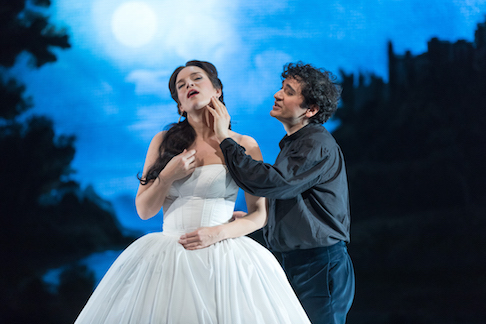 Vidal and Conrad in an impossible romance
Vidal and Conrad in an impossible romance
As head of Richelieu’s network of spies, Mark Schnaible created Father Joseph with the necessary religious villainy. He conveyed enough sickening contempt to remind me of a corrupted satanic Catholic. Toxic in the worst of ways. At the curtain call, for one moment he almost seem to rouse some boos, Schnaible was that successful at his antagonism.
The supporting roles were all well cast. As the pistol whip Marion Delorme, coloratura Danae Kontora stole each scene. Delorme hosts the party during which the ballet occurred. Not only did she carry her scenes with charm and wit, her voice commanded the stage and almost eclipsed Ms Conrad. Together with Delorme’s mischievous counterpart Ninon de Lenclos (an entertaining Sandra Maxheimer), the two devious ladies dazzled and brought out overtop flamboyance in their coquette scenes in the second act.
Amongst the supporting men, Jonathan Michie as Conseiller de Thou impressed the most. Always caring and forewarning towards his best friend Henri. In Act I, he particularly charmed in his bromance, although some of their funny French shenanigans were lost in translation. Later Michie demonstrated his vulnerability in his protection over Cinq Mars, before his friend’s tragic ending. Jeffery Krueger and Sébastien Soules, also contributed remarkably as de Montmort and de Fontrailles.
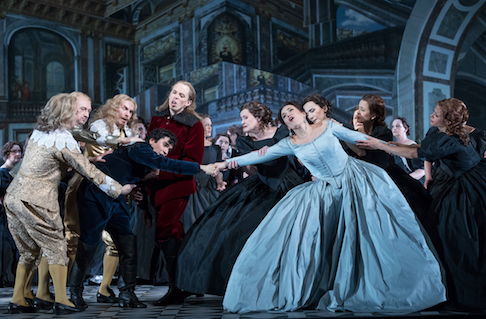 The cast and choir in Cinq Mars
The cast and choir in Cinq Mars
Alessandro Zuppardo prepped the Choir of the Oper Leipzig who provided indispensable energy. They offered great momentum in the beginning as they drew the audience into the story. They also engaged in lovely theatrics on stage in the frivolity at the ball in the Act II. Above all, the German choir authentically conveyed French patriotism in rousing moments.
David Reiland (from Opéra Théâtre de Saint-Étienne) conducted the Gewandhaus with much verve, never overshadowing the soloists. His pace created a continuous momentum which he led through each act. I was never bored with this composition by Gounod.
While Cinq Mars didn’t reach the epic grandeur of Leipzig’s early Wagner Die Feen, this production should be seen by any opera aficionado who wants to be treated to Gounod’s excellently executed, unrecognised work. It will be performed several more times in early 2018.
David Pinedo
Cast and production information:
Prinzessin Marie de Gonzague: Fabienne Conrad; Marion Delorme: Danae Kontora; Ninon de L'Enclos/ Ein Schäfer: Sandra Maxheimer; Marquis de Cinq-Mars: Mathias Vidal; De Montmort/ Der polnische Botschafter: Jeffery Krueger; Conseiller de Thou: Jonathan Michie; Vicomte de Fontrailles: Sébastien Soules; Pater Joseph: Mark Schnaible; Der König von Frankreich: Randall Jakobsh; Eustache: Jean-Baptiste Mouret; De Montrésor: Joshua Morris; De Brienne: Artur Mateusz Garba; Gewandhaus Orchestra, Conductor: David Reiland; Director: Anthony Pilavachi; Set and Costumes: Markus Meyer; Choreographer Julia Grunwald; Chorus master; Alessandro Zuppardo; Dramaturge: Elisabeth Kühne, at Oper Leipzig, May 27, 2017
image=http://www.operatoday.com/Der_Rebell_des_Konigs_Cinq_Mars_Ensemble_Premiere_20517Tom_Schulze.jpg
product=yes
product_title=Gounod's Cinq Mars at Oper Leipzig
product_by=A review by David Pinedo
product_id=Above: A traditional staging in Leipzig [All photos by Tom Schulze]
July 28, 2017
Detlev Glanert : Requiem for Hieronymus Bosch
It helps that the paintings are so much part of popular culture that everyone recognizes his images of extreme excess. Bosch’s people wear medieval dress, but their actions depict the subconscious, the ‘Id’ and existential guilt in operation, centuries before the concepts of psychology found expression in formal language.
Like Carnina Burana, Glanert’s Requiem is highly dramatic music theatre, adapting the cataclysmic dreamscapes of Bosch’s paintings into music of extremes as lurid as Bosch’s images. Glanert’s Requiem unfolds in 18 episodes, rather like panels in a medieval triptych. This gives the piece structure, making it easy to follow. The teeming, sprawling panoramas Bosch depicts could plausibly be depicted in sound, but that would probably be asking too much of most audiences. Like Bosch, though, Glanert’s piece replicates extremes. Literally heaven and hell, for the premise is the judgement Bosch faces after death. Thus the standard elements of a Requiem Mass are interleaved with the Seven Deadly Sins, the acrid flames of hellfire whipping against the smoke of incense.
A harsh Voice (David Wilson-Johnson, narrating) calls from above “Hieronymus Bosch!” Immediately we spring to attention. Bells ring,. Throbbing, rushing figures in the choral line, suggesting the doomed hordes we see in Bosch’s paintings. The orchestral lines veer wildly, lit by screaming brass, the chorus screaming to crescendo. Suddenly the forces fragment and, from the silence, a slow, low penitential intonation. An abstract ‘Requiem Aeternam’, the choral line flowing ambiguously, in almost microtonal haze. like smoke. In ‘Gluttony’ the bass (the aptly named Christof Fischesser) sings of food, his lines circular and rotund. The text may be in Latin, but the meaning is clear. The choir responds with the long, thin lines of an ‘Absolve Domine’, reinforced by ‘Wrath’ with tenor (Gerhard Siegel) and a ‘Dies Irae’ which ends with a vivid orchestral flourish. Another demon, ‘Envy’, fights back. Soprano Aga Mikolaj’s fluid, curving lines mimic the lines in the “heavenly” chorus— imitation is a sign of envy!
But the serene ‘Juste judex’ prevails. But where are we? The organ solo (Leo van Doeselaar) lets rip with a frenzy that suggests a cathedral organ hijacked by ‘Satan’. Despite the extremes of volume and tempi, the lines between heaven and hell are, tellingly, blurred. In ‘Sloth’, the soprano sings langorously, joined in sensuous duet by the mezzo (Ursula Hesse von den Steinen). ‘Pride’, ‘Lust’ and ‘Avarice’ appear, but the balance shifts towards the big guns : Full choir, offstage choir, and orchestra in increasingly full throttle : listen for the jazzy culmination of the ‘Domine Jesu Christe’. and the funky trumpet that heralds the ‘Agnus Dei’.
With the ‘Libera Me’ and ‘Peccatum’, we are in Carmina Burana territory, bursting forth in a blaze, the earthly chorus in raucuous flow, augmented by brass and percussion and the offstage chorus singing of ‘lux perpetua’. Big forces. But is might right? Glanert’s Requiem ends ‘In Paradisium’, here the ‘Voice from Above’ recites lines from the Book of Revelation. Apocalyptic visions, marking the end of the world and of time. Now, when the Voice screams “Hieronymus!”, he doesn’t add a demonic epithet. With an unearthly low hum, the choir sings of the chorus angelorum that brings eternal rest.
Glanert’s Requiem for Hieronymus Bosch was commissioned to celebrate Bosch’s 500th anniversary, and premiered in Sint Janskathedraal, ‘s-Hertogenbosch, in April 2016. So it’s a public piece rather than a work of inward inspiration. It must be great fun to perform, without being particularly demanding, technically or interpretively. It could, in theory, be performed elsewhere, much as Carmina Burana is, these days. It is admirably performed on this world premiere recording made in November 2016 with the top-notch Royal Concertgebouw Orchestra Amsterdam, conducted by Markus Stenz.
Glanert was one of Hans Werner Henze’s few disciples. Henze’s political beliefs influenced his music, though he never sacrificed high artistic and intellectual standards. Glanert is a man of the theatre, too, with a more earthy sense of humour than Henze had, though that quirkiness isn’t too obvious. When the ENO did Glanert’s opera Caligula, London audiences just couldn’t get it. (Please read HERE what I wrote about Caligula, which I first heard in Frankfurt). In this Bosch Requiem, Glanert again mixes grotesque with irony. Just as the vastness of Carmina Burana appealed to Nazi taste, the vastness of this Requiem veers on parody. Will it be loved for its vulgarity or its irony? Just as the paintings of Hieronymus Bosch reveal the viewer, Glanert’s Requiem reveals the listener.
Anne Ozorio
image=http://www.operatoday.com/rco_glanert_requiembosch.png image_description=RCO 17005 product=yes product_title=Detlev Glanert : Requiem for Hieronymus Bosch. Markus Stenz, Royal Concertgebouw Amsterdam. product_by= A review by Anne Ozorio product_id=RCO 17005 [CD] price=€ 12.99 product_url=https://www.jpc.de/jpcng/classic/detail/-/art/detlev-glanert-requiem-fuer-hieronymus-bosch/hnum/7384097
A new La clemenza di Tito at Glyndebourne
Guth’s and designer Christian Schmidt’s concept is more sentimental than Imperial, but not without relevance and effect. During the overture - brisk and airy under Robert Ticciati’s guidance - we enter a world of whimsy, as a digital projection unfolds the adventures of two young boys playing amid the woods and beside the lake in a rural idyll with more than a hint of resemblance to Glyndebourne’s own grounds. The faux chivalry of sword-fights with sticks takes a more sinister turn when the boys stalk wildlife, one with catapult a-ready. A shot is slung, and a bloodied magpie is the result - a betrayal of trust and of nature.
Unfortunately, first-night flickers and blackouts made the visuals even more distracting from the musical prelude than might have been the case; and, it’s not immediately clear that these two lads are the adolescent Tito and Sesto, whose friendship will be so tensely tested in the ensuing operatic narrative. This is not just a matter of realism - Richard Croft’s Tito looking at least one generation ahead of Anna Stéphany’s Sesto - but also because there is no clear link between the on-screen Elysian fields and the post-eruption ashes of the land of Vesuvian shadows which form half of the set. It is only in Act 2, when the conflicted Tito must decide the traitorous Sesto’s fate, that the parallels crystallise: the two young boys escape from the digital celluloid and clamber through the rough reed beds, ghostly representatives of disloyalty and division, who haunt their subsequent selves with disturbing memories.
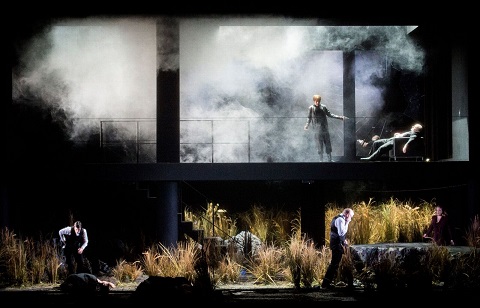 Photo credit: Monika Rittershaus.
Photo credit: Monika Rittershaus.
There is nothing Imperial about Schmidt’s split set: ravaged undergrowth - presumably the foothills of the recently erupted Vesuvius, as lava rocks and odds bits of furniture lay strewn - is juxtaposed with a grim, grey modern corporate milieu which lies hidden above until the black projection screen is lifted. There’s a lot of up and down, and upstairs/downstairs, but Olaf Winter’s gloomy lighting is atmospheric and apposite, emphasising the dullness and inertia of Tito’s political relationships and his own disaffection with a power dependent on fear.
Guth’s Personenregie is not always credible. Vitellia cries ‘Come here and embrace me,’ as she wanders off in the opposite direction from the infatuated Sesto; ‘Come near me!’ Tito demands, as he and Sesto walk backwards towards each other (tentatively, across an obstacle-strewn set - which ironically almost wrong-footed some the production team during the curtain calls), bump into each other and then lurch apart. When Sesto refuses to divulge the reasons for his treason, Tito threatens his beloved friend with a sickle, then uses it to scythe clumps of reeds which he clutches to his chest. There is much synchronised choral semaphoring from the ‘men in grey suits’ (both the gents and ladies of the Glyndebourne Chorus being thus attired).
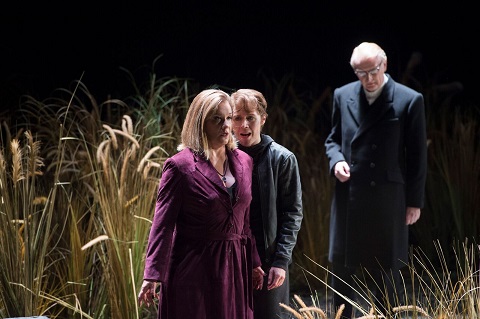 Vitellia (Alice Coote), Sesto (Anna Stéphany) and Publio (Clive Bayley). Photo credit: Monika Rittershaus.
Vitellia (Alice Coote), Sesto (Anna Stéphany) and Publio (Clive Bayley). Photo credit: Monika Rittershaus.
Fortunately, there is some excellent singing to distract us from the irritating visuals. The withdrawal of the pregnant Kate Lindsay led Anglo-French mezzo-soprano Anna Stéphany - originally intended for the role of Annio - to step into Sesto’s shoes and her performance was simply stunning. I missed Stéphany’s much-lauded Marschallin at the ROH (where I saw a performance by the first cast), but I did admire her capricious Serse in the Early Opera Company’s performance of Handel’s opera at St John’s Smith Square last November. And, once again it was a true delight to enjoy her exquisitely styled phrasing and expressive coloratura. The challenges of ‘Parto, parto, ma tu, ben mio’ were met with ease, and the coloratura was sweet-toned, as if overflowing with Sesto’s love for both Vitellia and Tito - a love which was reflected in the beautifully played basset clarinet obbligato. ‘Deh, per questo istante solo’, in which Sesto declares himself deserving of death, vowing to take all the guilt upon himself, was equally moving. Impressively, Stéphany made the role dramatically credible too, plausibly treading the fine line between idealistic self-sacrifice and all-consuming passion - a task made more difficult in a production where it was not evident why anyone would fall so unreservedly under the erotic spell of Vitellia.
The vengeful daughter of a deposed emperor who abuses Sesto’s love to gain power and become Empress, Alice Coote’s Vitellia is clear ‘a baddie’ - a gun-toting chain-smoker, she even has a purple coat. Less femme fatale than a woman on the verge of a nervous breakdown, this vituperative Vitellia seems to slide into hysteria, even psychosis, when she holds a pistol to Sesto’s head to convince him to murder Tito. No one could accuse Coote of lack of commitment and this was a heroic effort, but she was vocally taxed by a role which frequently lies too high for her mezzo. In ‘Deh, se piacer mi vuoi’ she pushed her voice hard, as Vitellia dreams of being Empress, but the result was sometimes squally. In the revelatory ‘Non più di fiore’, however, we finally enjoyed Coote’s lovely full, burnished lower register, as Vitellia is enlightened, recognising the error of her ways. We, too, were ‘enlightened’, as the aria was sung with the house lights on - another technical hitch, or designed to suggest spiritual illumination in contrast to the prevailing moral darkness?
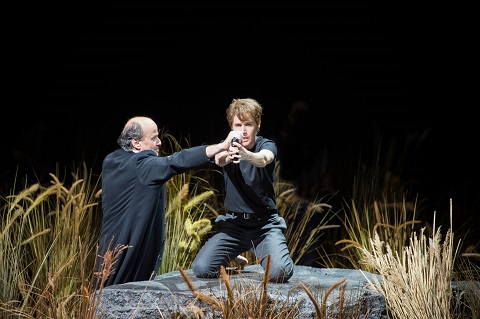 Tito (Richard Croft) and Sesto (Anna Stéphany). Photo credit: Monika Rittershaus.
Tito (Richard Croft) and Sesto (Anna Stéphany). Photo credit: Monika Rittershaus.
American tenor Richard Croft, following the withdrawal of Steve Davislim, was a benevolent patriarch, singing with soft-grained lyricism and fluency, although he wasn’t entirely comfortable at the top and had a tendency to be ponderous in the recitatives. This Tito was deeply tormented by the dilemmas he faced, as his innate compassion clashed with the magisterial demands of office, but he lacked a certain aristocracy - an imperial nobility which is essential if the qualms caused by his high-mindedness are to ring true. Tito is magnanimous, but he is not meek. Moreover, by placing Tito’s quasi-infatuation with Sesto centre-stage, the production neglected the political context for the drama: it was not clear why Tito must banish Berenice - we see her depart bearing two suitcases - whom he loves but whom his nation will not accept as Empress, nor why having initially chosen Servilia as her replacement, she too is rejected in favour of Vitellia.
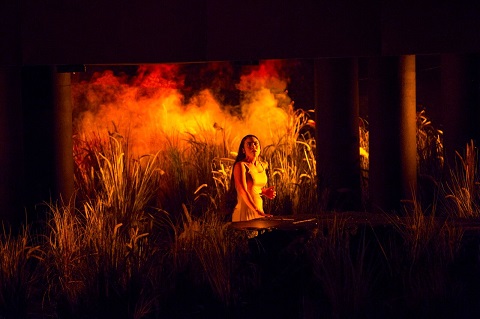 Servilia (Joélle Harvey). Photo credit: Monika Rittershaus.
Servilia (Joélle Harvey). Photo credit: Monika Rittershaus.
Joélle Harvey, who made a strong impression here in La finta giardiniera three year ago, sang with stylishness and delicacy as Servilia, giving depth to the slight role and pleading for Sesto’s life with heart-moving earnestness in her final aria. Annio, the role originally intended for Stéphany, was beautifully sung by Canadian mezzo-soprano Michèle Losier who captured all of Annio’s loyalty and honesty.
The playing of the Orchestra of the Age of Enlightenment was tender and spacious, though the ceremonial numbers might have had a little more regality. Ticciati sensitively gave his singers the time they needed, but there was occasional loss of momentum in the recitatives with too many longueurs and silences. Ashok Gupta (fortepiano) and Luise Buchberger (cello), raised in the pit, were not once unsettled by the hiatuses, however.
Some have seen La clemenza di Tito as a homage to Leopold II, whose coronation as King of Bohemia the opera was commissioned to celebrate; others, as a warning to pre-Revolutionary European rulers of the dangers of the abuse of power. Certainly, contemporary political tensions remind us of the need for leaders who will ensure the safety and security of nations, as emphasised perhaps in the closing moments of this production when Clive Bayley’s dark-voiced Publio - the unsettling, manipulative commander of the Praetorian Guard - came out of the shadows to assume the reins of power.
Another self-conscious directorial gesture, perhaps; but the superb cast ensured that the sincerity which is at the heart of this opera was preserved.
Claire Seymour
Mozart: La clemenza di Tito
Vitellia - Alice Coote, Sesto - Anna Stéphany, Annio - Michèle Losier, Publio - Clive Bayley, Tito - Richard Croft, Servilia - Joélle Harvey, Children - Rupert Wade and Logan Bradley; director - Claus Guth, conductor - Robin Ticciati, designer - Christian Schmidt, lighting designer - Olaf Winter, video designer - Arian Andiel, dramaturg - Ronny Dietrich, movement director - Ramses Sigl, Orchestra of the Age of Enlightenment, Glyndebourne Chorus (chorus master, Jeremy Bines).
Glyndebourne Festival Opera; Wednesday 26th July 2017.
image=http://www.operatoday.com/Chorus%20and%20Tito.jpg image_description=La clemenza di Tito, Glyndebourne Festival Opera product=yes product_title=La clemenza di Tito, Glyndebourne Festival Opera product_by=A review by Claire Seymour product_id= Tito (Richard Croft) and the Glyndebourne ChorusPhoto credit: Monika Rittershaus
July 23, 2017
Prom 9: Fidelio lives by its Florestan
Given that the opera celebrates both individual freedom and the spirit of collectivism - ‘A brother has come to seek his brothers, to help them, if he can, with all his heart,’ sings Don Fernando, as he delivers his gracious king’s order to ‘dispel the evil cloud of darkness’ which has enveloped the populace and the prisoners - it must have seemed an apt choice of work, exemplifying the very principles upon which the Arab-Israeli project was founded.
Indeed, Fidelio can seem more an expression of ideas and ideals than a drama about the lives of credible, three-dimensional individuals. As such, it might lend itself more readily to concert performance than to theatrical staging, and it was the former that we were offered at the Royal Albert Hall in a performance by a cast of international soloists, the BBC Philharmonic and the singers of Orfeón Donostiarra, under the baton of Juanjo Mena.
Fidelio - which falls between several stools: opéra comique, ‘rescue opera’ (or, in German, Befreieungsgeschichte) and Singspiel - is often described as a ‘problem opera’ and one of its sticking points is how to treat the spoken dialogue. On this occasion, the spoken German was amplified, which created a disjuncture between the various sections which form the whole and served to confirm that only one of the cast had the vocal power required to reach the furthest corners of the RAH. The dramatic veracity of the opera was also weakened by the failure of the soloists, by and large, to interact with each other - despite the fact that they were all (with the understandable exception of James Creswell, deputising for the indisposed Brindley Sherratt) singing from memory.
These minor misgivings, however, were unequivocally redeemed by the performance of Stuart Skelton as Florestan, once again contributing in utterly compelling fashion to the Proms’ Beethoven offerings following his memorable performance in Missa Solemnis last year. There can be few operas where the catalyst of the dramatic action is silenced for the entire first half of the work; but, this means that by the time Act 2 commences, with Leonore/Fidelio fervently embarked on her rescue mission, we are in a state of high expectation when we finally encounter the shackled Florestan, languishing alone in the prison’s furthest, darkest, dankest cell.
The BBC Philharmonic’s Act 2 orchestral prelude was cleanly and expressively executed, the instability of the rhythmic fragmentations and violent outbursts coalescing in the timpani’s disturbing tritone; but, nothing could fully prepare for the almost existential anguish of Skelton’s opening utterance, ‘Gott, welch Dunkel heir!’ (Oh, God! How dark it is!), the first word swelling with searing courage and defiance, and then depleting, an emblem of Florestan’s fading strength and hope. The declaration that ‘Doch gerecht ist Gottes Wille!’ (God’s will is just!) was assertive; the acceptance, ‘Das Mass der Leiden steht bei dir’ (He has decreed the measure of my suffering) was, despite the vehement melismatic twist, even and resigned.
Florestan’s liberator - his wife Leonore, disguised as ‘Fidelio’ - was Ricarda Merbeth, who delivered a vocal performance which was secure and disciplined, but who seemed reluctant to dare to complement her careful vocal delivery with dramatic commitment. Leonore has a lot of persuading to do. She must first don a male disguise with sufficient credibility to divert the affections of Marzelline from her light-hearted lover, Jaquino; then, she must insinuate her way into her husband’s prison by winning her ‘prospective father-in-law’s’ trust, and convince prison guard Rocco to allow her to accompany him to the cells. Surely, Fidelio would at least need to look at those whom she seeks to dupe? But, time and time again - despite the efforts of Louise Alder’s open-hearted, responsive Marzelline to engage with her new beloved - Merbeth stared straight ahead, as if oblivious and immune to such attempts. This was most frustrating in the Act 2 ‘Melodram’ in which Fidelio descends to Florestan’s cavern and must convince Rocco to employ ‘him’ as his assistant in the arduous task of digging the long-confined Florestan’s grave.
That said, Merbeth’s vocal performance was solid, the tone rich and rounded, if sometimes filled out with what I felt to be an overly wide vibrato, and the role’s wide range caused no problems. In Leonore’s Act 1 aria, ‘Abscheulicher!’ (Monster!) the ungainly angularity of the vocal line and the rapid runs and arpeggios - essentially instrumental in nature - were used to create urgency and to convey the heroine’s struggle.
Creswell’s Rocco might have displayed more ‘oafishness’ but all credit to the bass for this show-saving performance: Rocco’s ‘gold aria’ was a model of bourgeois proselyting, and Creswell’s phrasing was eloquent throughout. Detlef Roth’s Pizarro was a bit underwhelming; he needed darker vocal hues to convey the prison governor’s malice and bluster, and to justify the heckling of this reprehensible on-stage character - oh when will UK audience’s cease this undignified practice? - which greeted Roth at his ‘curtain call’. (Mena stepped forward and whispered in Roth’s ear - presumably to explain that the hoots were not a sign of audience disapproval of his singing but rather a relic of pantomime heckling.)
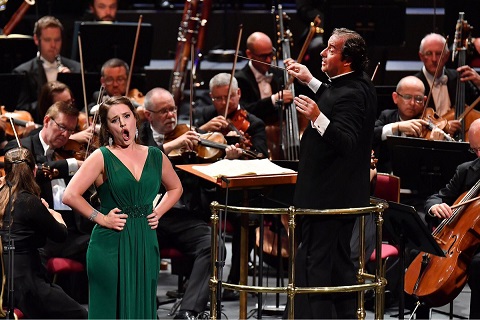 Louise Alder (Marzelline). Photo credit: Chris Christodoulou.
Louise Alder (Marzelline). Photo credit: Chris Christodoulou.
The younger soloists didn’t always have the heft for the venue but gave intelligent, vocally assured performances. Louise Alder seems to have limitless stamina and a musical memory as cavernous as Florestan’s cell: following recent performances in the Cardiff Singer of the World Final, and as Sophie in WNO’s Der Rosenkavalier, at the RAH she brought Marzellina to life, and the contrast between her crystalline soprano and Merbeth’s plumper, darker voice was effective. (The following evening, Alder stepped in at the last moment to replace the indisposed Andrei Bondarenko at the Wigmore Hall, where she’d performed earlier in the month in a recital entitled ‘Schubert and Women’s Voices’.)
As Jaquino, Benjamin Hulett was a vocally attractive partner for Alder and he imbued the spoken text with sensitivity and dignity. His opening duet with Alder, ‘Jetzt Schätzchen’ (Yes, sweetheart), made for an effectively sunny contrast to the Hadean depths of Florestan’s underworld to come.
As Don Fernando, David Soar was alone in being able to (almost) match Skelton’s projection, but he was more than a mere mouthpiece for royal authority and his addresses to the people conveyed genuine benevolence and fellow-feeling. As always, Soar gave an intelligent, considered performance.
The men of Orfeón Donostiarra were solicitous rather than revolutionary in tone in ‘O welche Lust’, and this helped Mena achieve textual clarity through the Act 1 finale. Similarly, the voices of the individual prisoners - Andrew Masterson (First Prisoner) and Timothy Bagle (Second Prisoner) - were given space to emerge from the mass. For the final chorus, the men, in evening dress, were joined by the women, in white, and we seemed to step even further into the realms of oratorio.
Wilhelm Furtwängler’s notes for his 1950 Salzburg production of the opera declared, ‘Fidelio is a Mass, not an opera - its emotions touch the borders of religion. […] After all we have experienced and suffered in recent times, this religious faith has never seemed so essential as it does today. … This is what constitutes the unique power and grandeur of Fidelio. […] What Beethoven was trying to express in Fidelio cannot be encompassed by any form of historical classification but extends beyond the narrow limits of a musical composition - it touches the heart of every human being and will always appeal directly to the conscience of Europe.’ Furtwängler’s words carried the momentous burden of the losses and atrocities of WW2, but the shadows cast by crimes against humanity are no less lowering today. Mena refrained from hammering home heavy-handed didacticism; but I did feel that, however ‘noble’, this performance lacked dramatic intensity.
Claire Seymour
Beethoven: Fidelio
Juanjo Mena (conductor), BBC Philharmonic, Orfeón Donostiarra.
Florestan - Stuart Skelton, Leonore - Ricarda Merbeth, Rocco - James Creswell,Marzelline - Louise Alder, Jaquino - Benjamin Hulett, Don Pizarro - Detlef Roth, Don Fernando - David Soar.
Royal Albert Hall, London; Friday 21st July 2017.
image=http://www.operatoday.com/Prom-9-CR_BBC-Chris-Christodoulou_7.jpg image_description=Fidelio, Prom 9 product=yes product_title=Fidelio, Prom 9 product_by=A review by Claire Seymour product_id=Photo credit: Chris Christodoulou
July 21, 2017
The Merchant of Venice: WNO at Covent Garden
Polish pianist and composer André Tchaikowsky, born in November 1935, had experienced the ghettos of Warsaw as a child; he was also a homosexual. One imagines that the discriminatory divisions and brutal biases of The Merchant of Venice struck a personal chord; that, paradoxically, he empathised with both the experience of the despised Jewish moneylender, Shylock, and with the latter’s nemesis, the refined Venetian, Antonio, whose melancholy has oft been accredited to his frustrated homosexual love for Bassanio - a love which other Venetians in the play mock: ‘You look not well, signor Antonio’, smirks the garrulous Gratiano.
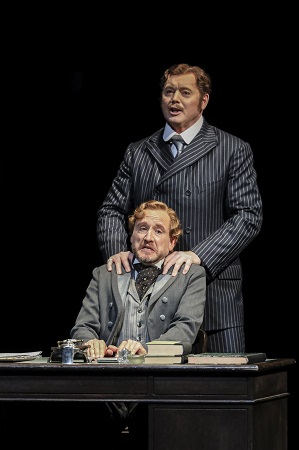 Martin Wölfel (Antonio) and Mark Le Brocq (Bassiano). Photo credit: Johan Persson.
Martin Wölfel (Antonio) and Mark Le Brocq (Bassiano). Photo credit: Johan Persson.
Tchaikowsky’s opera was completed in 1978. He offered it to ENO, when the company was under Lord Harewood’s directorship and David Pountney was artistic director, but in 1982 it was rejected and Tchaikowsky, seriously ill with cancer, died shortly afterwards at the age of 46. It remained unperformed until Pountney, by then artistic director of the Bregenz Festival in Austria, commissioned performances, directed by Keith Warner, for the 2013 festival. WNO’s performances of this production in Cardiff in September last year brought the opera to the UK for the first time.
In Shakespeare’s day, Venice was considered an eclectic model of democratic republicanism, international trade, maritime prowess, Renaissance art and, as in Ben Jonson’s Volpone, corruption and vice. But, Shakespeare largely ignores these stereotypes and focuses on the city’s cultural divisions and conflicts (a pattern repeated in Othello). The ‘City of Love’, he suggests, is intoxicated by hatred.
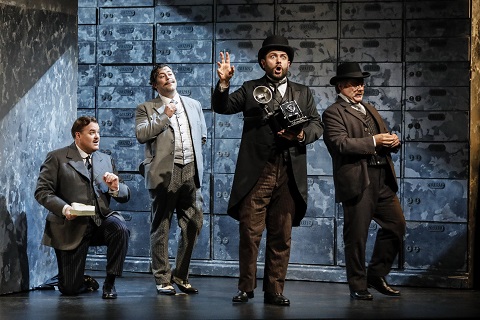 WNO cast. Photo credit: Johan Persson.
WNO cast. Photo credit: Johan Persson.
Keith Warner’s production emphasises not just the prevailing persecution and prejudice but also the motives which fuel them: in this case, mercantile ruthlessness and envy. Ashley Martin-Davis’ handsome designs take us to the underbelly of Venice’s leisured glamour: its bank vaults. There are none of the magnificent ‘argosies with portly sail’ - emblems of the trading wealth that paid for the city’s opulent piazzas, buildings and art - that dominate the conversation at the start of Shakespeare’s play. Venice’s commerce depended upon the finance made available by Jewish usurers, and so the Jews were ‘tolerated’ not out of humanitarianism but because of mercantile necessity.
Warner and Martin-Davis take us directly into the city’s counting houses: sturdy strong-boxes form the very fabric of Shylock’s house. The set’s mobile walls rotate slickly, spinning us through a world of ceaseless commercial transaction. The action is updated to the Edwardian era - a period during which the cosmopolitan Jewish elite, from the highest echelons of the likes of the Rothschilds to the middle-class financiers, seemed largely integrated into London society, until the start of WW1 released previously repressed hostility. Warner and Martin-Davis thus ignore the gondoliers and visual riches of the Rialto, just as Shakespeare’s The Merchant of Venice ignores the local colour and opulence, to focus on the Venetians’ self-justifying persecution of the stereotyped ‘alien’.
John O’Brien’s libretto largely follows Shakespeare’s plot and imports much text - too much? - verbatim. There are some unexpected omissions, though. The absence of Bassanio’s description of Portia - ‘a lady richly left;/ And she is fair, and, fairer than that word,/ Of wondrous virtues: sometimes from her eyes/ I did receive fair speechless messages’ - with its alliterative dreaminess, deprives the spendthrift’s request for a loan of its romantic validation: after all, he is asking his homosexual admirer for money that the latter does not have so that he can pursue his female beloved. Then, when Shylock commands Jessica to lock the doors of his house in his absence, the usurer’s detestation of music - of the ‘vile squealing pf the wry-necked fife’, the ‘shallow foppery’ that shall not enter his ‘sober house’ - is excised; it seems strange to omit an opportunity to exploit the text for characterisation, given the operatic context - after all, Shakespeare’s villains are never lovers of music. But, then, I suppose something has to go.
Tchaikowsky employs a lyrical vocal idiom which often has much grace - as in Portia’s ‘quality of mercy’ monologue - and rhetorical impact, as in Shylock’s vociferous self-vindication, ‘I am a Jew. Hath not a Jew eyes?’, which is moved, with dramatic effectiveness, from the Act 3 street scene in which Shylock spits his exculpation at Solanio and Salarino to the court-room denouement, where his audience is the Venetian state itself. But, the arioso lines often drift and overall the opera feels too wordy. One wishes that O’Brien had been more adventurous, re-ordering and revising in order to create ‘anew’, in the manner of a Boito, as there is a danger that the music becomes simply illustration - an enabling medium for the presentation of the play, rather than a work in its own right. Even Britten’s A Midsummer Night’s Dream - which was similarly faithful to the original, adding just one line of ‘explanatory’ text (‘compelling thee to marry with Demetrius’) and in which the lovers’ music can suffer from the same plaint - has the unsettling eeriness of Oberon’s countertenor magic, the elevation of ‘Bottom’s Dream’ and, not least, the wonders of Britten’s score to suggest new meanings.
Musically, here, there is a predominant debt to Berg and, while not particularly memorable, the score serves the tenser dramatic moments adequately. However, the languorous lyricism of Belmont evades Tchaikowsky. Both Lorenzo’s final-act eulogy to music and the entire second Act - which feels like an extended scherzo, in which the divertissements are supplemented by an on-stage (here, side-box) Renaissance consort of two recorders, oboe d’amore, oboe da caccia, two bassoons, lute, tabor and harpsichord - lack the requisite ‘poetry’.
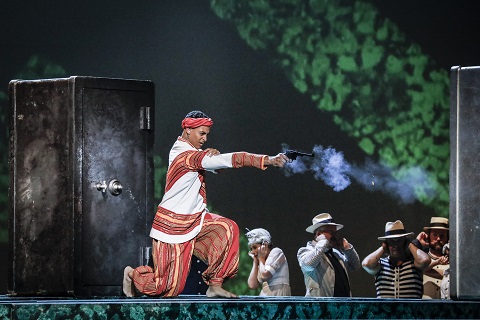 Wade Lewin (Prince of Morocco). Photo credit: Johan Persson.
Wade Lewin (Prince of Morocco). Photo credit: Johan Persson.
Warner offers a contrast to the dark Venetian drama of the opening act and stages the Act 2 Belmont scenes within a box-hedge maze, a bird’s-eye view of which is artfully relayed on a video back-drop. The easy luxury, sense of sexual freedom (at one point Portia pins Nerissa down in what seems a lesbian embrace), frequent interpolation of musical allusion and set-piece (‘Tell Me Where Is Fancy Bred?’ is delivered by a Dietrich-style diva in white top hat and tails) and the maze itself, put me in mind of Kenneth Branagh’s 1993 film of Much Ado About Nothing. But, the flippancy feels excessive: the caskets are held in three cumbersome safes, reminding us of the ugly, mercenary motivation behind the suitors’ quests, but the riddle scenes are hyperbolic - the gun-toting Moroccan prince leaps acrobatically and resorts to an outsize detonator to gain entry into the gold casket - and disproportionate, disrupting the dramatic flow.
Lionel Friend conducts with attentiveness to the details of the score - the orchestra is large - and does a good job at keeping stage and pit in balance and coordination. The instrumental interlude following the court-room scene was beautifully played, a poignant representation of Shylock’s defeat and, Warner suggests, death: for Shylock seems to succumb fatally to his shame and humiliation, his ghost rising during the moonlit meeting of Lorenzo and Jessica, to haunt his daughter’s betrothment and betrayal.
African American baritone Lester Lynch is cast as Shylock, his race adding to the alienation signalled by his gabardine and skull-cap amid the prevailing Edwardian urbanity. Lynch’s voice glows with pride and hatred, while the contortions of the tuba, bass clarinet and counter-bassoon convey his self-destructive bitterness. There seems little to redeem him: in the trial scene, he pulls on his rubber gloves like an amateur surgeon, eager for his ‘pound of flesh’, deaf to the warnings of the Duke of Venice - nobly sung by Miklós Sebestyén - that ‘victory’ will bring Shylock only vilification.
Lauren Michelle’s Jessica may toss her father’s treasure chests through the casements with overly enthusiastic gusto into the sheets held below by Lorenzo’s Christian friends, but she must fight her own battles to overcome prejudice. Michelle coped well with the high melismatic lines which, crystalline, rose above the scornful reception she meets at Belmont and deepened our sympathy still further.
Sarah Castle was superb as Portia. Her strong diction allowed Portia’s words to penetrate to the back of the stalls, giving the feisty proto-feminist further stature, while her phrasing was stylish. Its elegance was equalled by Mark Le Brocq whose high-lying lines conveyed all of Bassanio’s levity and heedlessness. Verena Gunz’s animated Nerissa and David Stout’s tactless Gratiano made a well-matched pair. Only Martin Wölffel disappointed: Tchaikowsky’s decision to cast Antonio as a counter-tenor (presumably to emphasise his homosexuality - Antonio surprises Bassanio with an impetuous kiss when the latter embarks for Belmont to woo Portia) may be questionable, but by any measure Wölffel lacked power and definition, and the English text was indistinguishable.
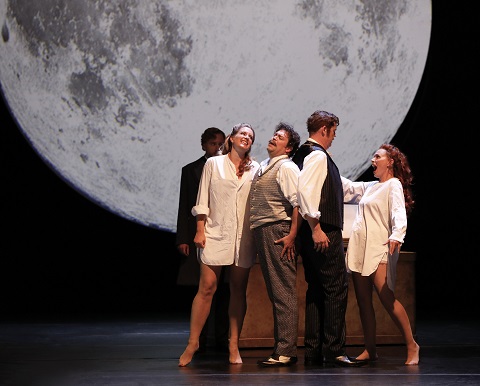 Verena Gunz (Nerissa), David Stout (Gratiano), Bruce Sledge (Lorenzo) and Sarah Castle (Portia). Photo credit: Johan Persson.
Verena Gunz (Nerissa), David Stout (Gratiano), Bruce Sledge (Lorenzo) and Sarah Castle (Portia). Photo credit: Johan Persson.
Warner’s production opens and closes with an image of Antonio on the psychiatrist’s couch. The final gesture - Antonio hurls an object at Shylock’s ghost, silhouetted against the moon - is presumably designed to suggest that the therapy isn’t working, unable to overcome the depth and perpetuation of hatred, but if so it seems redundant. More importantly, it subverts or at least alters the balance of the ending of Shakespeare’s romantic comedy, in which love and loyalty defeat malice and cruelty. That said, Warner does consistently emphasise the darker aspects of Shakespeare’s tale and at the close of this production the scales of justice are still crookedly weighted with intolerance and bigotry.
Claire Seymour
André Tchaikowsky:
The Merchant of Venice
Co-production of the Bregenzer Festspiele, Austria, the Adam Mickiewicz
Institute as part of the Polska Music programme & Teatr Wielki, Warsaw/
Shylock - Lester Lynch, Antonio - Martin Wölfel, Lorenzo - Bruce Sledge, The Duke of Venice - Miklós Sebestyén, Bassanio - Mark Le Brocq, Solanio - Gary Griffiths, Salerio - Simon Thorpe, Gratiano - David Stout, Jessica - Lauren Michelle, Portia - Sarah Castle, Nerissa - Verena Gunz, Prince of Aragon/Freud - Juliusz Kubiak, Prince of Morocco - Wade Lewin, A Boy - Fiona Harrison-Wolfe, Woman one - Amanda Baldwin, Woman two - Helen Jarmany; Director - Keith Warner, Conductor - Lionel Friend, Designer - Ashley Martin-Davis, Original Lighting Designer - Davy Cunningham (realised by Ian Jones), Movement Director - Michael Barry, Associate Director - Amy Lane, WNO Orchestra and Chorus (Chorus Master - Robert Pagett).
Royal Opera House, Covent Garden, London; Wednesday 19th July 2017.
image=http://www.operatoday.com/Martin%20Wolfel%20%28Antonio%29%20and%20Lester%20Lynch%20%28Shylock%29-%20WNO%27s%20the%20Merchant%20of%20Venice-%20photo%20credit%20Johan%20Persson-%202708.jpg image_description=The Merchant of Venice, WNO at the Royal Opera House product=yes product_title=The Merchant of Venice, WNO at the Royal Opera House product_by=A review by Claire Seymour product_id=Above: Martin Wölfel (Antonio) and Lester Lynch (Shylock)Photo credit: Johan Persson
July 20, 2017
Leoncavallo's Zazà at Investec Opera Holland Park
And, fittingly so. For, in 1900, eight years after Leoncavallo had drawn back the curtain on the tawdrier side of theatre life in Pagliacci , and at the time when audiences were lapping up the self-sacrifice of Tosca - a well-known singer, adored by her public, redeemed by the beauty of her voice from a life of poverty or religious devotion - Zazà confirms the contemporary fascination (on-going?) with back-stage lives which combined luxury and glamour with lurid domestic soap-opera.
Indeed, the parade of performers with which Lambert opens the opera - stage-hands, Pierrots, cloaked magicians, drag artists, tutu-ed ballerinas, cabaret divas, acrobats, aerial artistes, a theatre troupe decked in full Renaissance garb - have their verismo roots in the itinerant comedians of Pagliacci, the traveling performers of Mascagni'sIris, and the professional actors in Cilèa’s Adriana Lecouvreur.
Lambert makes clear that this is an all-singing/all-dancing, show-must-go-on world, whose glitzy frontage is stained by a grittier reality. Ironically, it was a world with which Leoncavallo himself would later become familiar as, to supplement the royalties from Pagliacci, in his later years the composer toured Europe and North America, conducting condensed versions of his own opera. When he arrived in London in September 1911, a music-hall arrangement Pagliacci at the Hippodrome was announced as ‘The Sensation of the Century’: ‘Signor Leoncavallo’s appearance in person to conduct his own condensed version of his own Pagliacci, and bringing his own company with him, is an event of a unique character in the history of variety theatres.’ A media circus, indeed.
Reviewing Opera Rara’s superb concert performance of Zazà at the Barbican in 2015, I remarked that, ‘Perhaps a fully staged production is necessary to do justice to Zazà’s melodramatic excesses’. (My review contained a stage history and synopsis, to which readers might be directed.)
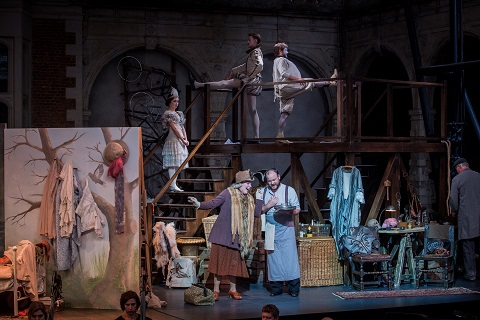 Louise Winter as Anaide and Michael Bradley as Augusto. Photo credit: Robert Workman.
Louise Winter as Anaide and Michael Bradley as Augusto. Photo credit: Robert Workman.
Lambert certainly holds nothing back scenographically in the first Act, making use of the whole span of the OHP stage to offer us a revue performance (-within the performance), a stage-crew at their labours, a working-class café-chantant, Zazà’s dressing-room-cum-bedroom, and an external staircase and platform where thespians and dancers gather to practise their art.
If that sounds a lot to take in, it is. I appreciate that it’s a milieu that we are intended to absorb, not a landscape whose every detail we should laboriously note; but, it seems a pity when dancers are practising at the barre, or show-girls are fanning bubbles, or Long John Silver is strutting his stuff, to ignore these details. Particularly so when central and peripheral events intertwine: when the protagonists’ music provides the rhythm and form for those performing in the stage’s marginal arenas; or where Zazà’s seductive flirtations are mirrored by erotic couplings at the fringe. But, without mimicking a Centre Court audience watching a thrilling rally swing back and forth, it’s impossible to take in and link up everything, and ultimately the hyperactivity - all wonderfully detailed and authentic - distracts from the central focus.
Act 2 puts the spotlight on Zazà’s dressing-room itself, all powder puffs, pillows and strewn underwear, while Act 3 transports us to the caddish Dufresne’s Parisian dwelling, which the family are preparing to leave. Trunks and cases are piled high, making the apartment appropriately spiritless but also making a nonsense of some of the text: as when Dufresne complains that his little desk, like his heart, is covered with clutter, when there isn’t a bureau in sight as all the furniture is swathed in white sheets. But, the bareness effectively complements the tightening of the dramatic intensity and focus in this Act.
Anne Sophie Duprels excels in the title role, demonstrating a dramatic range that matches her vocal commitment. Geraldine Farrar, the Met’s biggest star in 1920, and for whom the company staged Zazà, said that the role depended ‘altogether on the true, convincing interpretation of the heroine by the singer ... The singer who can make her audience feel that the emotions she is portraying are real, can make the figure live in voice and action, must always carry the part to success.’ (cited in Frederick H. Martens, The Art of the Prima Donna and Concert Singer). And, Duprels certainly lived up to this high threshold.
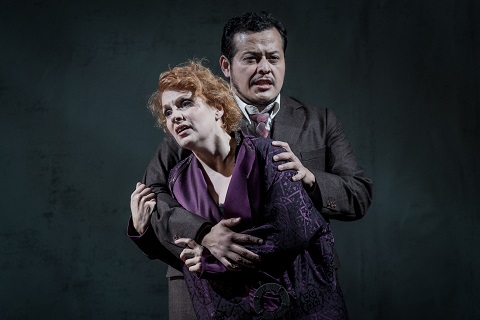 Anne Sophie Duprels as Zazà and Joel Montero as Milio. Photo credit: Robert Workman.
Anne Sophie Duprels as Zazà and Joel Montero as Milio. Photo credit: Robert Workman.
The ‘heroine’ does not have formal arias as such, rather long musical monologues that hit peaks of passion and pique though which Duprels swelled gloriously. She has warmth in the middle range, and if occasionally her soprano becomes a little harsh as the voice climbs, the singer makes Leoncavallo’s somewhat indistinctive melodies speak. They take on a declamatory quality in the sense of an on-going conversation: Zazà’s voice will be heard - indeed, it is only quietened by the ‘angelic’ calm of Defresne’s daughter Totò, charmingly played by Aida Ippolito, whose spoken words alternate with Zazà’s plaintive sung reflections on the injustice of life and recognition that she must give up hopes of a future with Dufresne.
Duprels captured all of Zazà’s precariousness - her brassiness, her wit, her volatility, her vulnerability - and did not allow the drama to lapse into melodramatic sentimentality. In fact, she seemed at times to emphasise Zazà’s self-preserving flintiness. She smeared on red lipstick as she dismissively reminded her inebriate mother - whose idiosyncrasies were richly mined by Louise Winter - that living by the matriarch’s rules led to ruinous poverty, an accusation rendered sharper by Anaide’s obvious concern for her daughter, as she picked up her stockings from the floor and laid them carefully on the bed.
There was humour too, though, as Zazà donned Brünnhilde’s helmet to ‘rescue’ the furious peg-legged pirate she’d left stranded on stage, when missing her cue as Dufresne swept her off her feet. Duprels also conveyed a strong relationship with her long-suffering dresser, Natalya, a role sung with sensitivity and acted with nuance by Ellie Edmonds. Edmonds conveyed Natalya’s genuine love for her mistress, just as Duprels’ dependence on her employee-friend was plain to see.
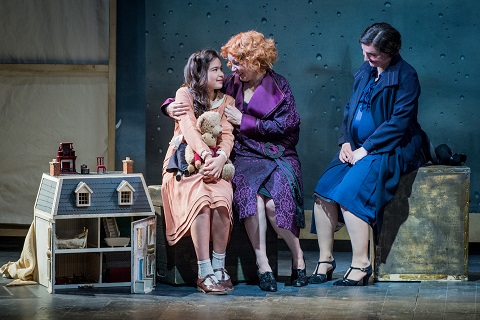 Aida Ippolito as Totò, Anne Sophie Duprels as Zazà, and Ellie Edmonds as Natalia. Photo credit: Robert Workman.
Aida Ippolito as Totò, Anne Sophie Duprels as Zazà, and Ellie Edmonds as Natalia. Photo credit: Robert Workman.
Some of the best singing of the night came from Richard Burkhard’s Cascart; ‘Zaza, piccola zingara’ was tender, firm of tone and carefully phrased. If only Zazà had heard the loyalty and affection in her former lover’s voice then she might have heeded his warnings and spared herself suffering …
The minor roles - the starry revue artiste, Floriana (Johane Ansell), James Cleverton’s Bussy, a writer, impresario Courtois (Charne Rochford), stage manager Duclou (Eddie Wade), and Michael Bradley’s Augusto, a waiter - were persuasively sung and though their contributions were often quite brief, the direction was detailed and lively.
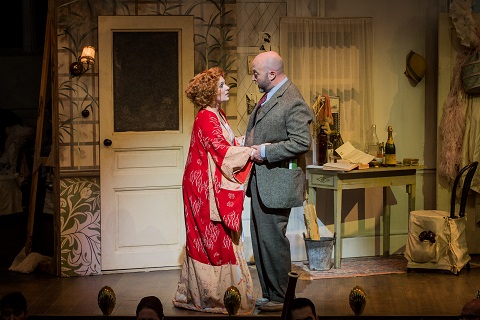 Richard Burkhard as Cascart and Anne Sophie Duprels as Zazà. Photo credit: Robert Workman.
Richard Burkhard as Cascart and Anne Sophie Duprels as Zazà. Photo credit: Robert Workman.
As Zazà’s weak-willed, selfish deceiver, Milio Dufresne, Joel Montero seemed out of sorts. Though he produced a stirring tone at times, there were a lot of rough edges and the intonation was hit-and-miss and wavering.
Peter Robinson and the City of London Sinfonia made much of the brash colours and popular-song rhythms of Act 1, and brought out the more nuanced instrumental detail of the latter acts. This was disciplined, stylish playing.
When Farrar - who had a large following of idolising young women, nicknamed ‘Gerry-flappers’ - bid farewell to the stage in the title role of Leoncavallo’s opera, she was festooned with balloons and flowers, hailed with banners, ‘Hurrah, Farrar! Farrar Hurrah!’, eulogised in speeches of devotion, and paraded up Broadway in an open top car (as reported in Music Journal, October 1965).
Dream and reality, art and life: Zazà struggles to recognise the distinction between a world that can be created on a theatre stage and a life that must be lived. Perhaps it is ever thus. But, as Tosca learned that integrity is more than important than life, by the close Zazà has learned that integrity is more important than love.
Claire Seymour
Leoncavallo: Zazà
Zazà - Anne Sophie Duprels, Milio - Joel Montero, Anaide - Louise Winter, Cascart - Richard Burkhard, Bussy - James Cleverton, Floriana - Johane Ansell, Natalia - Ellie Edmonds, Courtois - Charne Rochford, Duclou - Eddie Wade, La Signora Dufresne - Joanna Marie Skillett, Marco - Oliver Brignall, Augusto - Michael Bradley, Totò Dufresne - Aida Ippolito, Claretta - Alexandra Stenson, Simona - Charlotte Hewett; Director - Marie Lambert, Conductor - Peter Robinson, Designer - Alyson Cummins, Costume Designer - Camille Assaf, Lighting Director - Mark Jonathan, Choreographer - Danilo Rubeca, City of London Sinfonia, Opera Holland Park Chorus.
Investec Opera Holland Park; Tuesday 18th July 2017.
image=http://www.operatoday.com/Johane%20Ansell%20as%20Floriana%2C%20Anne%20Sophie%20Duprels%20as%20Zaz%C3%A0%2C%20James%20Cleverton%20as%20Bussy%20.jpg image_description=Zazà at Investec Opera Holland Park product=yes product_title=Zazà at Investec Opera Holland Park product_by=A review by Claire Seymour product_id=Above: Johane Ansell as Floriana, Anne Sophie Duprels as Zazà, James Cleverton as Bussy and the Opera Holland Park ChorusPhoto credit: Robert Workman
July 19, 2017
McVicar’s Enchanting but Caliginous Rigoletto in Castle Olavinlinna at Savonlinna Opera Festival
With his traditional staging and dress, McVicar brings to life the grotesqueries of a Renaissance libertine court. Due to the censors of the time, Verdi had to relocate Rigoletto in Italian Mantua, but he based his opera on Victor Hugo’s “The King's Amusement” that recounts the life of libertine King Francois I. The lighting and ambience of McVicar's adaptation was hauntingly eerie, even though some of the singers couldn’t master the Castle’s acoustics. Mostly, though, the Finnish soloists offered the greatest quality in singing.
Manolov proved a sensational Rigoletto spanning a wide spectrum emotion. As a giant hunchback on crutches and covered in black leather, he appeared more a monstrosity than a court jester. Manolov sang full-blooded about his despair in his desire for his daughter’s safety, or of his anger towards the Duke and his court (unleashing a fury for kidnapping his daughter in “Cortigiani, vil razza dannata”). Before he is cursed by him, Manolov delivered biting wit in his rant against Monterone.
Juha Pikkarainen performed Manterone with deep, rounded sonority, especially in his grand entrance through one of Olavinlinna’s side portals. In the beginning, Pikkarainen easily overshadowed Lahaj’s Duke of Mantua.
In the beginning, Rame Lahaj’s Duke of Mantua worried me. As McVicar’s display of libertine syphilitic licentiousness (with young men howling like rabid dogs and coïtus coerced on Monterone’s daughter) took over the stage during the overture, the orchestra in full force led by Philippe Auguin, overpowered Lahaj’s voice. His “Questo o quella” lacked body and was almost inaudible; he failed to hold his own amongst the terrific choir (in scattered sexual acrobatics on stage). I was worried I was in for some poor singing tonight.
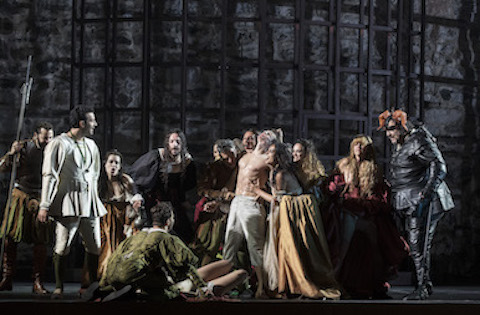 Lahaj and Manolov as Mantua and Rigoletto amused by the court's licentiousness
Lahaj and Manolov as Mantua and Rigoletto amused by the court's licentiousness
But I was wrong, Lahaj seemed to be saving his voice for his solos later and for his duets with Gilda. During his “La donna è mobile” in the Final Act, with Auguin toning down the orchestra's volume, he sang decently, yet it still not was the Verdi showstopper I was hoping for. On the other hand, in his vocals with Gilda he managed sensitive dramatic chemistry during the quieter orchestral passages.
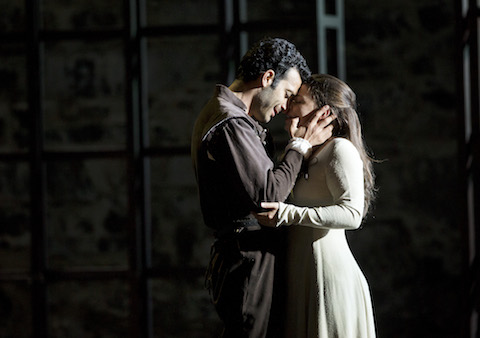 Lahaj and Takala in sensitive romantic chemistry
Lahaj and Takala in sensitive romantic chemistry
Gilda's “Caro Nome” put Tuuli Takala’s lyrical coloratura up to full display. Her high notes were so pure and radiated innocence. Even when the speedboats jetted over the lake outside and disrupted her singing, Takala would amp her vibrato not letting anything interfere in her declarations of love to her father or the Duke. As Giovanna, Merja Mäkäla offered beautifully grounded contrasts to Takala’s transparent vocals.
Manolov and Takala made an excellent pairing as Rigoletto and Gilda, in their father and daughter relationship. Their duets made believable and deeply moving. In their chemistry, two singing actors created great drama.
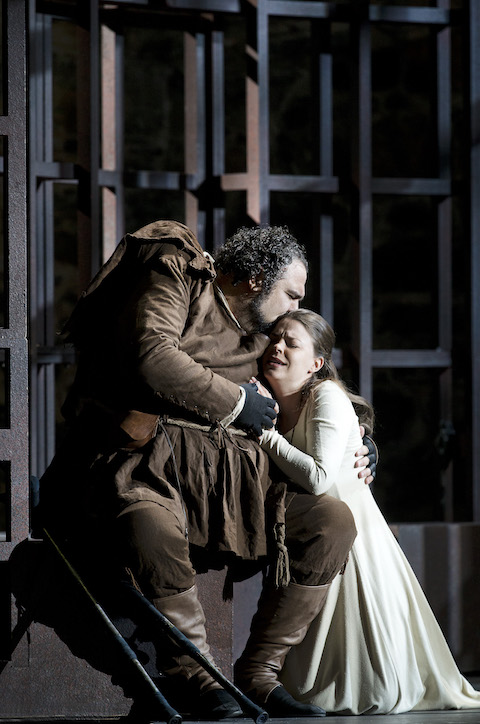 Manolov and Takala as father and daughter
Manolov and Takala as father and daughter
In supporting roles, Mika Kares contributed cunning intelligence to the assassin Sparafucile’s character. He performed wickedly together with a devilish Katarina Giotas as the conniving Maddalena, the sister Sparafucile emphatically pimps out in McVicar’s direction. Juha Riihimäki as Borsa and Jussi Merikanto as Marullo both sang decently. Though similarly to Lahaj, they also had some issues with the choir and orchestra’s force in Verdi’s music.
A magical moment occurred, during the storm in Act III. As lightning flashed brightly over the stage, a cold draft flowed through Castle Olavinlinna. As it passed the nape of my neck, right before the orchestra burst into a roaring tempest, it raised the hair on my arms and covered my back in goosebumps. A palpable tension hung in the air. Such moments make the castle such a thrilling locations for the right production.
After Manolov bowed over his dying Gilda at the end, and acknowledged Monterone with: “The Curse!”, the audience exploded in cheers. Yes the Finnish talent of this production received the applause (and loud stamping) it deserved. McVicar’s production proved a perfect fit for the Castle Olavinlinna.
David Pinedo
Cast and production information:
Duke of Mantua: Rame Lahaj; Gilda: Tuuli Takala; Rigoletto: Kiril Manolov; Giovanna: Merja Mäkelä; Sparafucile: Mika Kares; Maddalena: Katerina Giotas; Monterone: Juha Pikkarainen; Ceprano: Mikko Järviluoto; Countess Ceprano: My Johansson; Marullo: Jussi Merikanto; Borsa: Juha Riihimäki; Court usher: Roman Chervinko; Savonlinna Opera Festival Orchestra and Choir; Conductor: Philippe Auguin; Stage director: David McVicar; Stage design and costumes: Tanya McCallin; Lighting designer: David Finn; Movement director: Jo Meredith; Chorus master: Matti Hyökki; Olavinlinna Castle, Savonlinna Opera Festival, July 10, 2017.
image=http://www.operatoday.com/_I2I7222.jpg
product=yes
product_title=Verdi's Rigoletto at Savonlinna
product_by=A review by David Pinedo
product_id=Above: Rigoletto at the Court in Olavinlinna [All photos by Soila Puurtinen, Itä-Savo]
July 18, 2017
Jette Parker Young Artists Summer Performance at Covent Garden
There are plenty of ‘on-a-budget’ opera companies who regularly show that a lot can be made of not very much, so the scanty set and properties in the first-half sequence - a few chairs and tables, a dozen champagne glasses, a bucket of cherries - were not in themselves a problem. Matthew Mulberry’s lighting design was economical and effective. The Byronic gloom of Jacopo Foscari’s prison cell was effectively conjured by a single hanging lamp; Prince Charmant’s palace bathed in a pink glow, while a cooler blue illumed Arabella’s fraught exchange with Mandrynka.
The direction, however, was minimal and too often the singers seemed to be ‘hanging about’ wondering where to move next, singing straight to the house, or into the wings or back-cloth, rather than at or to each other, even though each of the first-half items presents an intimate, charged exchange. The diction was also, generally, poor with almost no discernible distinction between Italian and French.
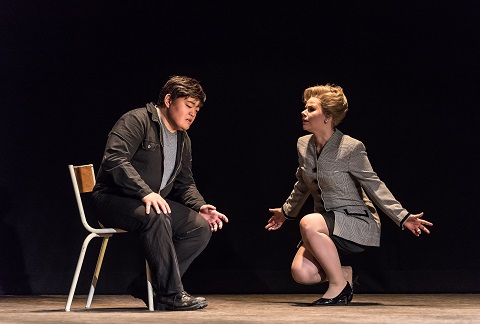 David Junghoon Kim and Vlada Borovko. Photo credit: Clive Barda.
David Junghoon Kim and Vlada Borovko. Photo credit: Clive Barda.
Fortunately, there were several names that have become well-known over the last year or two from their performances in minor roles in the House, and engagements elsewhere, and their appearances in more substantial fare were eagerly anticipated. Opening the programme with the Act II duet from Verdi’s I due Foscari, Vlada Borovko confirmed my previous impression (not least in last year’s JPYA performance and most recently in the ROH’s L'elisir d'amore ) that she is a soprano of dramatic power and commanding presence, well equipped to master Verdi’s surging vocal lines. She was a stirring Lucrezia, comforting David Junghoon Kim’s Foscari when he learns of his exile and conveying the full fierceness of Lucrezia’s love for her husband and fiery scorn for the scheming clique, the Council of Ten. Later, when the ensemble came together for the end of Act 2 of Don Giovanni, Borovko displayed similar concentration and intensity in Donna Anna’s ‘Non mi dir’.
Junghoon Kim’s acting has improved markedly during his time as a JPYA - as his recent engagement with Grange Park Opera confirmed - and here he was convincing as the tortured Foscari who is being tormented by delirious visions of the ghost of the decapitated mercenary, Carmagnola. He sang with clean, appealing tone, though he might have employed a wider dynamic range.
The tenor hasn’t yet quite got the refinement that Rossini’s music calls for and he seemed less comfortable decked up in habit and wimple as ‘Sister Colette’ - the disguised Count Ory who falls into the trap set for him by his page, Isolier, and finds himself in a darkened bedroom making advances to the latter rather than the object of his unwelcome affections, Countess Adèle. Comic timing is not Junghoon Kim’s forte, and it didn’t help that the staging of this trio - which Berlioz described as the composer’s ‘absolute masterpiece’ - lacked a certain jeu d’esprit, the only (mild) chuckles coming from the somewhat clichéd wriggling under the duvet and climbing under the bed.
The trio of singers didn’t ‘play off’ one another with sufficient zip, and conductor James Hendry let the tempo lag, failing to show how the orchestral rhythms point up the dramatic charm and wit. The enunciation of the French text was weak, but there was some attractive singing from Angela Simkin whom I admired in the title role of Oreste at Wilton’s Music Hall in 2016, and who displayed a firm technique and vocal gleam as Isolier. This followed her stylish appearance as Prince Charmant in Massenet’s love-at-first-sight duet, ‘Toi qui m’es apparue’, alongside Kate Howden’s Cendrillon. Howden, standing in at short notice for the indisposed Emily Edmonds, did well to shape Massenet’s lines with simple elegance. She coped well at the top and her fresh sound blended pleasingly with Simkin’s slightly fuller mezzo.
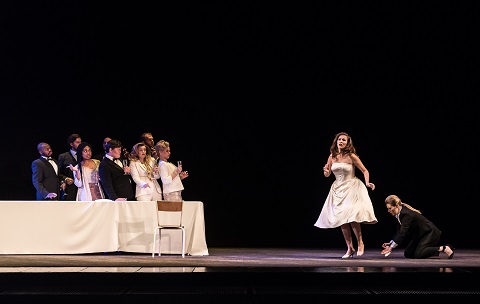 Cendrillon. Photo credit: Clive Barda.
Cendrillon. Photo credit: Clive Barda.
Soprano Francesca Chiejina was the third of Rossini’s comic threesome but she needed rather more vocal presence to communicate Adèle’s impish sense of fun. Chiejina had appeared a little tentative in her earlier guise as Suzel in the ‘Cherry Duet’ from L’amico Fritz - another comic gem which fell rather flat, missing the sparkle which imbues Mascagni’s trifling operetta - and her intonation strayed a little at the start. She has a sweet tone but doesn’t always project with enough dramatic vigour. As Fritz, Thomas Atkins did impress, however. Atkins studied at the Guildhall School of Music and Drama, and when I heard him sing Florindo in the 2015 production of Wolf-Ferrari’s Le donne curiose I remarked his ‘incipient Italianate gleam’, a quality which has now bloomed nicely. His ‘Il mio tesoro’ in the post-interval Don Giovanni episode was the highlight of the evening, revealing a well-supported lyric tenor and an ability to imbue a character who can seem weak-willed and ineffectual with convincing strength and integrity.
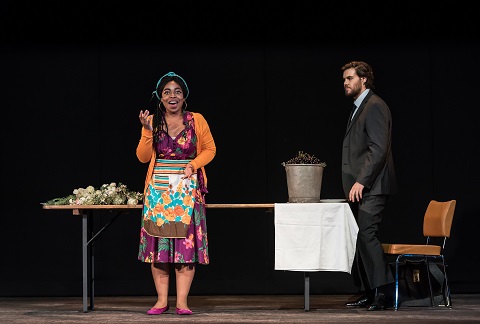 Francesca Chiejina and Thomas Atkins. Photo credit: Clive Barda.
Francesca Chiejina and Thomas Atkins. Photo credit: Clive Barda.
The other first-half item was the final duet from Strauss’s Arabella. As ever with Strauss, the writing lies quite high and Jennifer Davis, as the eponymous aristocrat, scaled the peaks but could not colour them with the requisite silvery tone, and this deprived this exquisite reconciliation scene of its transcendence. A similar heft, and tonal hardness, was apparent in Elvira’s ‘Mi Tradì’.
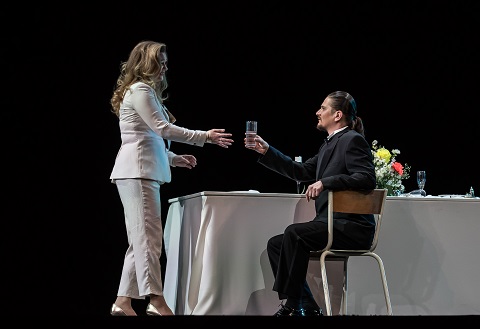 Jennifer Davis and Gyula Nagy. Photo credit: Clive Barda.
Jennifer Davis and Gyula Nagy. Photo credit: Clive Barda.
Perhaps it’s hard to invest the foolish Mandryka with any real credibility but Hungarian baritone Gyula Nagy needed a bit more focus to supplement the warmth of his sound in order to capture the dignity of the close. The absence of a staircase down which Arabella famously glides to her lover - to make the formalised gesture of offering the glass of water that signals her willingness to be her betrothed’s wife - was understandable and forgivable; what was less acceptable, however, was the lack of any convincing engagement between the reunited lovers.
Director Gerard Jones had put more thought and effort into the staging of the final scenes of Don Giovanni, and it paid off, as the simple set - a white-walled chapel where the Commendatore’s ebony coffin served as an unavoidable reminder of the Don’s dastardly deeds and impending doom - brought the singers together with more dramatic involvement and integration. Haegee Lee, who joins the JPYA scheme next season, took the role of Zerlina - intended for Edmonds and acted by Alicia Frost - singing from the side and revealing a good sense of Mozartian style which bodes well for her appearance as Papagena in the ROH’s new staging of Die Zauberflöte, directed by David McVicar, in the autumn. Simon Shibambu was a stentorian Commendatore but softened his tone effectively when doubling up as Masetto. Gyula Nagy was a fittingly disreputable Giovanni, and interacted well with David Shipley’s rich-hued Leporello.
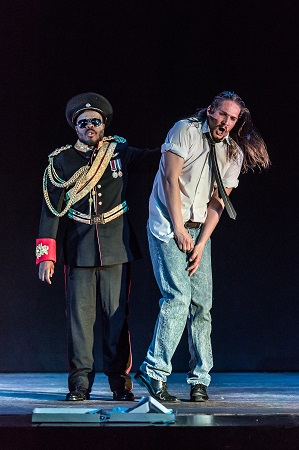 Simon Shibambu and Gyula Nagy. Photo credit: Clive Barda.
Simon Shibambu and Gyula Nagy. Photo credit: Clive Barda.
This staging gave Don Giovanni the last laugh. After the moralising finale and departure of the ‘victors’, the coffin in which Giovanni had been entombed raised its lid, and the chancer seized his opportunity, scampering off with a look which hinted, ‘I’ll be back’. So, too, will many of these young singers in the forthcoming ROH season, alongside six new Young Artists: Haegee Lee and fellow soprano Jacquelyn Stucker, mezzo-soprano Aigul Akhmetshina, tenor Konu Kim, baritone Dominic Sedgwick and stage director Noa Naamat.
Further details of the ROH autumn season can be found at http://www.roh.org.uk/seasons/2017-18/autumn .
Claire Seymour
Verdi: I due Foscari, Act II (duet)
Conductor - David Syrus; Lucrezia Contarini - Vlada Borovko, Jacopo Foscari
- David Junghoon Kim,
Massenet: Cendrillon, Act II (duet - ‘Toi qui m’es apparue’)
Conductor - Matthew Scott Rogers, Cendrillon - Kate Howden, Prince - Angela
Simkin
Mascagni: L’amico Fritz, Act I (duet)
Conductor: David Syrus, Suzel - Francesca Chiejina, Fritz - Thomas Atkins
Strauss: Arabella, Act III (final duet)
Conductor - David Syrus, Arabella - Jennifer Davis, Mandryka - Gyula Nagy
Rossini: Le Comte Ory, Act II (‘A la faveur de cette nuit
obscure’)
Conductor - James Hendry, Countess Adèle de Formoutiers - Francesca
Chiejina, Isolier - Angela Simkin, Count Ory - David Junghoon Kim
Mozart: Don Giovanni, Act II
Conductor - David Syrus, Fortepiano continuo - Nick Fletcher, Donna Anna -
Vlada Borovko, Donna Elvira - Jennifer Davis, Zerlina - Haegee Lee, Don
Ottavio - Thomas Atkins,Don Giovanni - Gyula Nagy, Leporello - David
Shipley, Masetto/Commendatore - Simon Shibambu, Ensemble - Francesca
Chiejina, Angela Simkin, David Junghoon Kim.
Director - Gerard Jones, Lighting designer - Matthew Mulberry, Movement - Anjali Mehra.
Royal Opera House, Covent Garden, London; Sunday 16th July 2017.
image=http://www.operatoday.com/ANGELA%20SIMKIN%2C%20DAVID%20JUNGHOON%20KIM%2C%20FRANCESCA%20CHIEJINA%20%28C%29%20ROH.%20PHOTO%20BY%20CLIVE%20BARDA.jpg image_description=JPYA Summer Performance, Royal Opera House product=yes product_title=JPYA Summer Performance, Royal Opera House product_by=A review by Claire Seymour product_id=Above: David Junghoon Kim, Francesca Chiejina and Angela Simkin in a scene from Comte OryPhoto credit: Clive Barda
July 17, 2017
A Falstaff Opera in Shakespeare’s Words: Sir John in Love
The three operas bear distinctive titles: Die lustigen Weiber von Windsor, by Otto Nicolai; Verdi’s Falstaff; and Ralph Vaughan Williams’s Sir John in Love. Of these, only Vaughan Williams’s was composed to an English text. Thus it has the special merit of allowing singers and listeners to relish Shakespeare’s actual words.
The British firm Lyrita has recently released a studio recording made in 1956 by the cast that, I assume, was currently performing the work at Sadler’s Wells. (Sadler’s Wells Opera, in London, would later be renamed the English National Opera.) Three of the singers had performed these same roles at Sadler’s Wells during the work’s first run of performances there (1946). One of them—Roderick Jones, the Falstaff—had sung in the opening night of the 1946 production and thus, as one says, had “created” the role.
The opera’s actual first, tryout staging had taken place seventeen years earlier at the Royal College of Music. During the years between that student production and the Sadler’s Wells premiere, Vaughan Williams added several notable passages to the score that enrich it greatly.
The CD recording under review was made in the BBC studios in 1956 and broadcast at the time, apparently with narrative explanations between the scenes. (Only one of those spoken links is included in this release, just enough to give a bit of period flavor.) Fortunately, many important BBC broadcasts of important works and performances were recorded by a devoted listener, Richard Itter, at his home on high-quality equipment . Sir John in Love is one of a number of these that are now being released for the first time—with permission from the BBC and the musicians’ union.
The recording is the third commercial release of Sir John in Love to reach the market, though it was the first of them to have been recorded. The other two are likewise studio recordings, but in stereo. One, on EMI (1975), is conducted by Meredith Davies, with Raimund Herincx as Falstaff; the other, on Chandos (2001), is conducted by Richard Hickox, with Donald Maxwell as Falstaff. April Milazzo, in American Record Guide, praised the Chandos recording (November/December 2001 issue), but she regretted that Maxwell showed little heft or personality in the title role. (Click here to get a sense of Maxwell’s rather placid take on the role.) I have listened to excerpts from that recording and find it often entrancing, mainly because one can hear so much more detail in the orchestra than on the 1956 recording reviewed here. The 1975 EMI recording also has many merits. (Click here for the final scene of the opera as heard in the 1975 EMI recording featuring Herincx. The scene begins with a prelude that Vaughan Williams would later expand and publish as a separate orchestral piece: the Fantasia on “Greensleeves.”)
But the belatedly released historic radio-broadcast recording from 1956 may well be the best point of entry for anyone who is unfamiliar with the opera, for it vividly conveys the interplay between the characters and between characters and chorus.
Opera lovers familiar with Verdi’s Falstaff will find that this work takes a refreshingly different tack. Vaughan Williams prepared the libretto himself, and skillfully. We get to experience many lively interchanges involving secondary characters who are absent from, or greatly downsized in, Boito’s libretto for Verdi, including Shallow, Slender, Peter Simple, and Dr. Caius.
Vaughan Williams also made the libretto more music-friendly by having various of the characters, or sometimes the chorus, sing folk-like numbers using poems and song texts from Shakespeare’s time—e.g., by Ben Jonson and Philip Sidney. He also sometimes integrated entire tunes from the time. The various “song” numbers are extraordinarily well integrated: for example, Mistress Page sings an extended snatch of the folksong “Greensleeves” while awaiting a visit from Falstaff, who then announces his arrival with his usual self-importance by continuing her song. There are, at several points in the opera, witty references in the orchestra to the well-known and, for this opera, aptly worded folk song “John, Come Kiss Me Now.” The chorus often participates actively, sometimes aligning itself with one or another character.
On those occasions when a situation in Sir John in Love is closely parallel to one in Verdi’s Falstaff, Vaughan Williams handles it no less expertly, though differently: for example, Mistress Page and Mistress Ford have fun reading Falstaff’s letters to each of them in canon, something Verdi did not choose to do.
The monophonic sound is extremely well engineered, as one would expect from a BBC radio broadcast. One hardly needs to look at the libretto to follow the main thrust of what people are singing. The singers generally show healthy vocal production and clear enunciation. Standouts include a young Owen Brannigan in the small role of the Host of the Garter Inn (a role he had sung in the 1946 season) and a consistently lovely and intelligent-sounding April Cantelo as Ann Page—one understands why several men in the play are attracted to her!
James Johnston had played Fenton during the opera’s first season at Sadler’s Wells, and he sings it here with clarity and power, clearly enjoying a tenor role that is more substantial than the idealized teenager that Verdi created as his Fenton. This eager lover is an appropriate match for Vaughan Williams’s Ann Page, who is herself more substantial than Verdi’s lighter-than-air Nanetta.
I found myself looking forward to the occasions when contralto Pamela Bowden, as Mistress Quickly, would next enter the scene and take command of the proceedings. John Cameron invests Ford with a splendid, Germont-quality baritone and eloquent acting skills that help one sympathize with this, in some ways, unsavory character. As for Roderick Jones, I kept forgetting that I was hearing a singer at all: each utterance seemed so true to character. How lucky for us that Jones’s reading of the title role got broadcast and “captured”!
( Click here for numerous excerpts from the 1956 recording. )
(And click here for the entire scene in Act 2, in that same recording, in which Master Ford, husband of Alice Ford but pretending to be a certain “Master Brook,” comes to make an offer to John Falstaff. The offer is that Falstaff, in exchange for some money from “Master Brook,” will seduce Mistress Ford “between ten and eleven” that same morning in order to cuckold Master Ford—i.e., the very man who, disguised to Falstaff, is making the offer. The whole plan is of course a trap for Sir John, set by Ford, his wife, and others. The dramatic effect in this recorded scene is so specifically conveyed by John Cameron, Roderick Jones, and the orchestra under Stanford Robinson that one can imagine the whole scene in one’s inner eye.)
Anybody who is seriously interested in Vaughan Williams, or in the challenges of setting a play to music, will be fascinated to listen to this recording and will take continuous pleasure in it.
Conductor Martin Yates has put together an orchestral suite from Sir John in Love (apparently based on a two-piano version by the composer). Of course the suite leaves out lots of wondrous stuff. A mid-way solution would be to listen to the cantata that Vaughan Williams himself drew from the opera in 1931: In Windsor Forest , which can be heard in recordings conducted by Norman Del Mar and (in an arrangement for women’s chorus) by David Willcocks.
There is also a broadcast recording of a stage performance of the opera on YouTube, featuring Owen Brannigan as a superb Falstaff, and with everyone articulating the words beautifully. Brian Priestman conducts with brisk authority. Alas, the voices are haloed by an ear-tiring echo.
Perhaps, in time, Sir John in Love will find its way into repertory status and thus become, finally, the first Shakespeare opera in English to command a wide audience. (The closest contender for that at the moment is Britten’s A Midsummer Night’s Dream—based on another comedy.) Why is this wonderful opera not more frequently performed?
Ralph P. Locke
The above review is a lightly revised version of one that first appeared in American Record Guide and appears here by kind permission.
Ralph P. Locke is emeritus professor of musicology at the University of Rochester’s Eastman School of Music. His most recent two books are Musical Exoticism: Images and Reflections and Music and the Exotic from the Renaissance to Mozart (both Cambridge University Press). Six of his articles have won the ASCAP-Deems Taylor Award for excellence in writing about music. He edits Eastman Studies in Music, a book series published by University of Rochester Press.
image=http://www.operatoday.com/Sir_John_in_Love.png image_description=Lyrita REAM2122 product=yes product_title=Ralph Vaughan Williams: Sir John in Love product_by=April Cantelo (Anne Page), Pamela Bowden (Mrs. Quickly), James Johnston (Fenton), John Cameron (Ford), Roderick Jones (Falstaff); Heddle Nash (Shallow), Parry Jones (Sir Hugh Evans), Gerald Davies (Slender), Andrew Gold (Peter Simple), Denis Dowling (Page), John Kentish (Bardolph), Denis Catlin (Num), Forbes Robinson (Pistol), Laelia Finneberg (Mrs. Page), Marion Lowe (Mrs. Ford), Francis Loring (Dr. Caius), Ronald Lewis (Rugby), Owen Brannigan (Host of the “Garter Inn”). Sadler’s Wells Chorus and Philharmonia Orchestra, cond. Stanford Robinson. product_id=Lyrita REAM2122 [2CDs] price=$18.99 product_url=http://www.arkivmusic.com/classical/album.jsp?album_id=2175436
Sallinen’s Kullervo is Brutal and Spectacular Finnish Opera at Savonlinna Opera Festival
Hate breeds hate. What happens to a person when his family is killed, he is turned into a slave, manipulated and forced to suffer in isolation? You become a vengeful madman. Not so different from disenfranchised young men and women in our modern world.
Part of the 19th Century epic poem “Kalevala”, assembled from Finnish mythology and folklore, the legend of Kullervo recounts the life of this young man, whose uncle Unto kills his father and his family. Kullervo survives, is sold as a slave to a herd’s man. Discovers his family survived somehow, but realizes now he slept with his sister. Greek tragedy, Finnish style.
Due to delay of construction of the new Helsinki Opera House, this Finnish commission premiered instead in L.A. It opened a year later in Finland. Heiskanen's barebones production doesn’t constrict the opera to any time or place and gives it a sense of immediate relevance. His stage direction emphasised the dramatic action between the performers.
He used the choir’s presence to full effect: from the moment the opera opens with the choir, blasting at the audience, in a narrating function similar to the ones in Greek Tragedies. It reminded me of the dramatic resonance of Pierre Audi’s abstract productions in Amsterdam. Though, Sallinen throws in several twists and turns that totally threw me off.
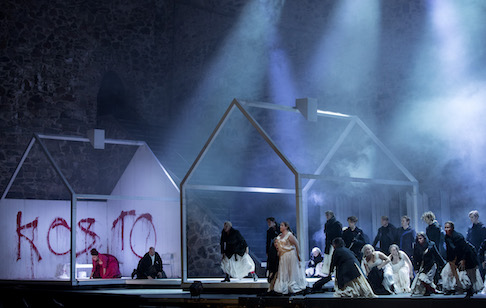 The Choir as Unto's tribe during Kullervo's slaughtering spree
The Choir as Unto's tribe during Kullervo's slaughtering spree
Antti Mattila’s simple set design with four houses, three merely frames, and one black cabin inside golden, where Kullervo's dramatic family moments took place. A captivating energy flowed between the actors across the stage generating a thrilling momentum. The staccato rhythm of the Finnish language added to the violence of the drama. Completely unfamiliar with Kullervo, I read the libretto, so when I got caught up in the engrossing drama, I would forget to read the surtitles!
Ville Susanan carried the role of Kullervo with a glamorous star quality and gritty vocals. Full of brutal impatience, his voice filled with a fatalistic despair, yet with a concealed receding sensitivity beating underneath his outer shell.
Daniel Karlström provided the voice hope. With his boyish innocence, he compensated the violence and hatred in the air between other characters. As Kimmo the slave boy, who cares only for Kullervo’s happiness, he provided a sense of humanity to the goings-on. His failure to protect Kullervo results in his own madness. In the epilogue, right before Kullervo jumps into a fire (in Heiskanen's staging a doorway opens, possibly to the underworld), Karlström gives an eerie goodbye as Kimmo.
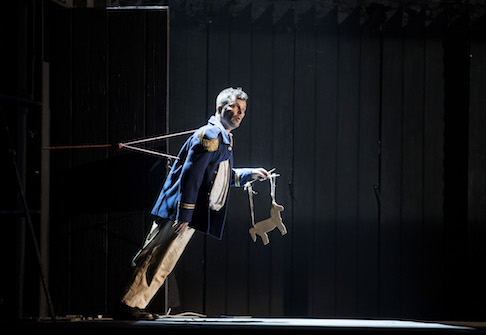 Karlström as the voice of hope in the end gone mad
Karlström as the voice of hope in the end gone mad
The libretto filled with sexual tension to Sallinen’s feverish music during Kullervo’s scene with the herd man’s young wife. Nina Keitel brought seductive tones in her manipulative role. She seduces and ultimately betrays Kullervo: “the moon shined down, round and beaming/and full of warm anticipation/But now the moon is lean, like a sickle/Yes you are coming, coming alone”.
Then Kullervo sings of her betrayal. She has baked a loaf of bread with a stone inside. Kullervo blasts her action: “Look! Look what you’ve ruined. Look at my/father’s knife/it’s been broken in pieces/It has been castrated by a single stone.”
All this led up to one of the many climaxes. First, an unplanned moment occurred when one of the gulls that swarmed outside the castle, had positioned itself in a portal high above the stage. Right before Kullervo kills the wife, and Keitel sings with the mightiest vibrato blasting through the castle, the bird flew down over her across the audience, as if even this loudly squawking creature could not endure Sallinen's musical violence.
The rest of the Finnish supporting cast also proved indispensable. Sallinen has a dark sense of humor. The role of the foolish hunter was conveyed annoyingly well by Petri Bäcktröm. Niklas Spångberg and Tiina Penttinen as Unto and his wife, fuelled by alcohol, made for an angry and embittered couple.
Sallinen’s surprise came at the beginning of the second act, during Kullervo’s dream sequence reveals he slept with his sister and had a child. Sallinen just threw me off. Did this really happy? And...Jazz? Birthe Wingren athletic singing and dancing as the Blind Singer revealed her impressive stamina through Sallinen’s bewildering and grotesque Cabaret sequence. Yet after the dream, or rather nightmare, Sallinen’s opera returned as if nothing has happened, seamlessly continuing the earlier musical suspense of Kullervo’s narrative.
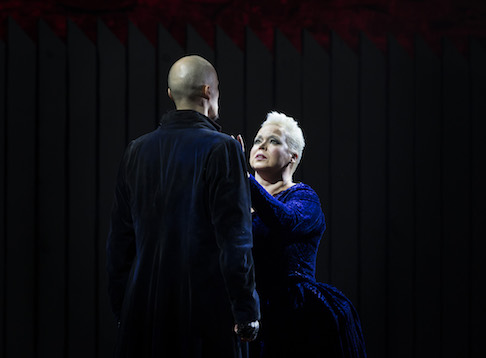 Powerhouse Rusanen-Kartiano sings of mourning her son Kullervo
Powerhouse Rusanen-Kartiano sings of mourning her son Kullervo
The showstopper of the evening belonged to Johanna Rusanen-Kartiano. She already had delivered some exquisite vocals earlier entwined with Kullervo’s sister together with the grand sound of Sanna Matinniemi's voice. After he confesses of sleeping with his sister and his father banishes him, it was her uncompromising love that resonanted. This made for the poetic passage in the libretto. When Kullervo ask his mother if she will mourn his death:
I will weep the whole verdant Spring.
If I cannot keep on weeping
in the presence of other people,
In the sauna I will hide,
weeping till salt tears shall flood it,
and my tears have washed its floor.
Myself and the audience was crushed by the unconditional maternal love delivered by Rusanen-Kartiano as Kullervo’s Aiti. The applause for her was explosive.
It’s not strange that Heiskanen’s staging still resonates twenty five years later. It withstands the test of time. As somebody in Savonlinna told me, this legend is in the DNA of every Fin, and so is the opera. I can see why. When it's staged again, I will be there to see it for sure!
David Pinedo
Cast and production information:
Kullervo: Ville Rusanen; Kimmo: Dan Karlström; Mother: Johanna Rusanen-Kartano; Kalervo: Hannu Forsberg; Sister: Sanna Matinniemi; Smith´s young wife: Niina Keitel, Hunter: Petri Bäckström; Unto: Niklas Spångberg; Unto’s wife: Tiina Penttinen, Blind Singer: Birthe Wingren; Tiera: Johann Tilli; 1st man: Lasse Penttinen; 2nd man: Markus Suihkonen; Savonlinna Opera Festival Orchestra; Conductor: Hannu Lintu; Stage director: Kari Heiskanen; Stage designer: Antti Mattila; Costume designer: Riitta Anttonen-Palo; Lighting designer: Ilkka Paloniemi; Chorus master: Matti Hyökki; Olavonlinna, Savonlinna Opera Festival, July 8, 2017
image=http://www.operatoday.com/AN6I6834.jpg
product=yes
product_title=Aullis Sallinen's Kullervo in Savonlinna
product_by=A review by David Pinedo
product_id=Above Ville Susanan as Kullervo [All photos by Soila Puurtinen, Itä-Savo]
Kát’a Kabanová at Investec Opera Holland Park
Streaking shards of blue - the surging waters of the Volga that will engulf Kát’a, or perhaps the electric flashes of the storm which propels her fateful confession - shoot across the wide stage at Holland Park, as piercing as the timpani’s thumping fate motif.
A boardwalk weaves around a steel ‘cage’ housing some Edwardian furniture and a samovar - hinting that the oppressive hounding of the individual by communal conformity was just as prevalent in the early-twentieth-century West as it was in the nineteenth-century Russian village where Alexander Ostrovsky sets his realist play, The Storm, which is the source for the composer’s libretto. Fuchs’ ‘gentrification’ of the milieu might also be justified by Ostrovsky’s own setting of Kát’a hopeless plight as an indication of the power of the ruling merchant ‘autocracy’.
The wide span of the Holland Park theatre does not really lend itself to intense psychological drama but Fuchs’ direction is as economical as Janáček’s score, clearly and precisely charting the opera’s rapid progression from turbulence to tragedy. Just as the unbending bars of the cage on the left of the stage emphasise the ever-present binding grip of community and tradition, so the reed beds far right suggest the irresistible dream of escape which provides a dramatic counter-force.
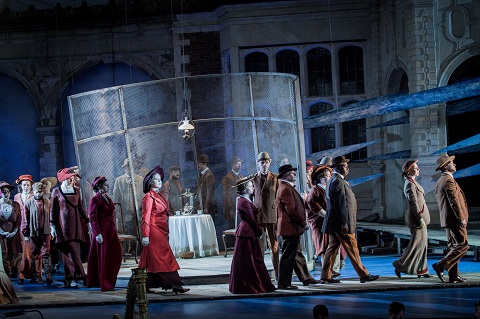 Members of the OHP Chorus. Photo credit: Robert Workman.
Members of the OHP Chorus. Photo credit: Robert Workman.
The chorus don’t have much to do, for Janáček - who was not really interested in presenting a social critique of the Russia of sixty years before - reverses Ostrovsky’s focus from the town onto Kát’a herself. Fuchs and movement director Clare Whistler effectively use stylised movement to suggest both the facelessness and the monotony of repression.
In the title role, Swedish soprano Julie Sporsén was perhaps more effective at conveying Kát’a’s later rhapsodic intoxication on dreams of passion and freedom, than she was at capturing her fragility and meekness in Act 1 in the face of Kabanicha’s cruel domination. I felt that a softer edge to the sound was required to evoke the young girl’s docility - after all, initially the tension is not between Kát’a and the community, for she shares the ‘values’ which Kabanicha and Dikój impose; and a singer needs to capture both Kát’a’s compliance and her self-scrutinising fear of transgression.
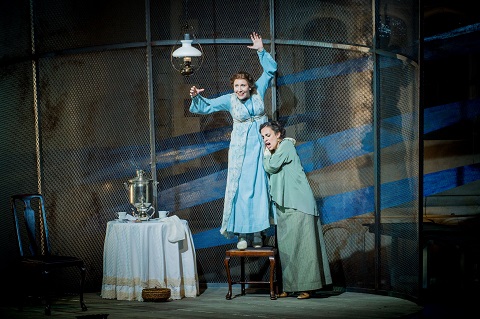 Julia Sporsén as Káťa and Clare Presland as Varvara Photo credit: Robert Workman.
Julia Sporsén as Káťa and Clare Presland as Varvara Photo credit: Robert Workman.
But, in Kát’a’s monologue with Varvara, Sporsén convincingly suggested the nascent hysteria within Kát’a’ as she realises that her only hope is to prevent Tichon’s departure. And, in the double love scene in Act 2, her melodic lines swelled with limitless emotion, as if simply by singing without cease her revelation and love could be made to last forever. ‘Now observation that time is passing, as the night-watchman marks the hour.
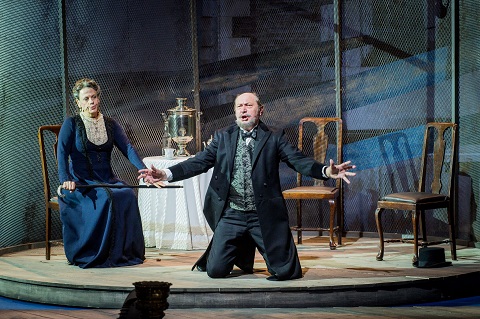 Anne Mason as Kabanicha and Mikhail Svetlov as Dikój. Photo credit: Robert Workman.
Anne Mason as Kabanicha and Mikhail Svetlov as Dikój. Photo credit: Robert Workman.
Anne Mason was superb as Kabanicha. Her mezzo was burnished and powerful, leaving no doubt of Kabanicha’s nastiness without descending into caricature. Her disparaging sneer, ‘Is he a lover you’re saying goodbye to’, at the end of Act 1 revealed her utter lack of compassion. Mason was a disturbing combination of frightening hostility and almost farcical hypocrisy - and Fuchs’ hint that Kabanicha and Dikój, sung with stentorian stature by Russian bass Mikhail Svetlov, are secret sadomasochists was uncomfortably credible.
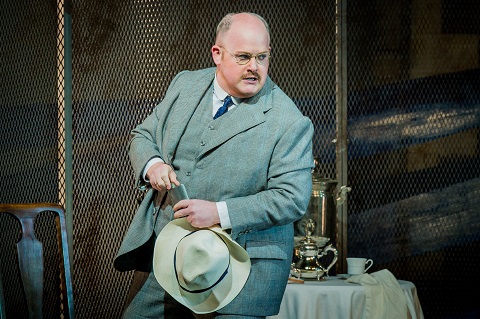 Nicky Spence as Tichon. Photo credit: Robert Workman.
Nicky Spence as Tichon. Photo credit: Robert Workman.
Nicky Spence and Peter Hoare must be getting used to pairing up in Janáček’s operas having appeared together earlier this summer at Grange Park Opera in Katie Mitchell’s 1998 Welsh National Opera production of Jenůfa , reprising a partnership formed at ENO in David Alden’s production of the work last year. They were equally comfortable in their roles as Tichon, Kát’a’s weak-willed husband, and Boris, her impetuous lover, respectively.
Spence was utterly credible as the put-upon merchant who swigs surreptitiously from a hip flask to avoid the stresses of both his business and his mother’s bullying. It’s certainly the only spirit in him; but, it also makes him deaf to Kát’a’s pleas.
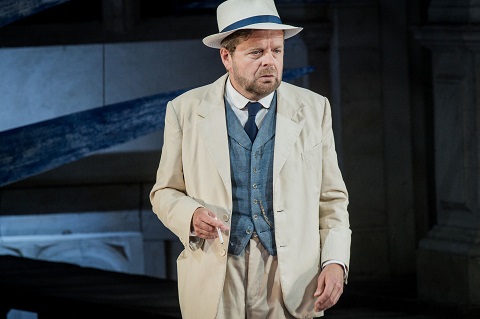 Peter Hoare as Boris. Photo credit: Robert Workman.
Peter Hoare as Boris. Photo credit: Robert Workman.
Hoare’s tenor soared with strength and passion, but Boris is no dark, brooding Laca, and Hoare’s characterisation brought out his irresponsibility and immaturity. Boris is an outsider in the community - Ostrovsky’s stage directions indicate that he should wear Western dress - and it is fitting that Fuchs makes Boris the first to dare to step from the restrictive wooden platform into the rushing Volga, coaxing Kát’a to follow him into the waters which represent, for her, both life and death.
Clare Presland was a charming, characterful Varvara, her strophic songs offering some much-needed, if temporary, relief from the prevailing tension. Presland used her full-toned mezzo to communicate Varvara’s free-spirited amorality: she believes that it doesn’t matter what you do as long as you don’t get found out. But, this was a rounded portrait and Presland did not suggest that Varvara was blameless. She and Paul Curievici’s personable, warm-voiced Kudrjaš might have been a little more impassioned in their Act 2 duet, but, then, the joy of the moment is merely a fragile peace.
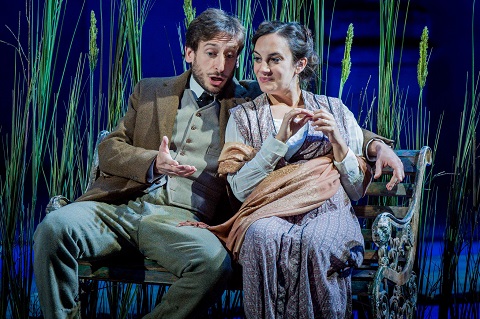 Paul Curievici as Kudrjaš and Clare Presland as Varvara. Photo credit: Robert Workman.
Paul Curievici as Kudrjaš and Clare Presland as Varvara. Photo credit: Robert Workman.
Sian Edwards drew precise, taut playing from the City of London Sinfonia but I missed some of the ‘rawness’ of Janáček’s score: the contrast between the extreme juxtapositions of high and low, the almost suffocating mass of the whole ensemble. The chromatic turn figure which conveys the lovers’ anxious expectation should surely plague one’s heart like the twist of a knife; the troika should explode with almost feverish vigour, indicating and inflaming Tichon’s agitation. Perhaps Edwards was cautious so as not to overpower her cast, but a few more risks would have raised the psychological thermometer still further.
Fuchs controls the ending’s rapid denouement skilfully. Hypocrisy and injustice resonate with discomforting power. But, in fact, Kát’a is defeated by her own shame at having destroyed her moral values. She recognises that the ecstasy of religious fervour has been replaced by an erotic giddiness: the storm is, Dikój proclaims, a punishment from God. And she believes him. Overcome by her own conscience, she kills herself: which makes Kabanicha’s proud, self-righteous claim of ‘victory’ so brutally ironic and the final pounding of the timpani’s ‘inevitability’ motif so mocking. The only relief is the wordless chorus - the soul of the Volga - whose voices sweep Kát’a away.
Claire Seymour
Janáček: Kát’a Kabanová
Kát’a Kabanová - Julie Sporsén, Boris - Peter Hoare, Kabanicha - Anne Mason, Tichon - Nicky Spence, Varvara - Clare Presland, Kudrjaš - Paul Curievici, Dikój - Mikhail Svetlov, Glaša - Laura Woods, Fekluša - Polly Leech, Kuligin - Ross Ramgobin, Žena - Ayaka Tanimoto, Boatman - Michael Bradley; Director - Olivia Fuchs, Conductor - Sian Edwards, Designer - Yannis Thavoris, Lighting Designer - Colin Grenfell, Movement Director - Clare Whistler, City of London Sinfonia, Opera Holland Park Chorus.
Investec Opera Holland Park, London; Saturday 15th July 2017.
image=http://www.operatoday.com/Boris%20and%20Katya%2013.jpg image_description=Kát’a Kabanová, Investec Opera Holland Park product=yes product_title=Kát’a Kabanová, Investec Opera Holland Park product_by=A review by Claire Seymour product_id=Above: Peter Hoare as Boris and Julia Sporsén as KáťaPhoto credit: Robert Workman
July 16, 2017
A bel canto feast at Cadogan Hall
In the nineteenth century, tenor Gilbert Duprez and soprano Julie Dorus-Gras were two of the most celebrated practitioners of the art. Duprez has been mythologised as the man who, during his debut in Paris in June 1837 as Arnoldo in Rossini’s Guillaume Tell, established the ‘modern’ tenor technique. Retaining a full-bodied tone, the chest voice, all the way up to the tenor’s high C, Duprez stunned audiences more used to the lighter voix mixte or head voice employed by the leading singers of the day, such as Nourrit or Bassini. So revolutionary was his technique, that in 1840 two French doctors, Paul Diday and Joseph Pétrequin, submitted a scientific report to the Académie des Sciences - ‘Mémoire sur une nouvelle espèce de voix chantée’ - describing Duprez’s timbre and laryngeal posture which they called ‘the voix sombrée ou couverte’ (dark or covered voice).
Julie Dorus-Gras was a leading prima donna in Paris during the 1830s and 1840s, described as by a journalist in the Revue et Gazette Musicale de Paris (June 1839) as having a voice ‘of the most beautiful quality, with great flexibility and extraordinary range’: ‘Since poor Malibran, we have not heard a singer so completely mistress of her voice, which taste and sentiment guide and which practice improves every day.’ Another commented, in May 1841, ‘Take for granted that she was perfect and you will save me as well as yourself the boredom of a lot of clichés and repetition.’
This Bastille Day programme at the Cadogan Hall presented mainly French arias made famous by those two leading figures of the nineteenth-century French and Italian operatic scene and drawn from both the familiar and rare ends of the repertoire. American tenor Michael Spyres and Lebanese-Canadian soprano Joyce El-Khoury gave superb performances that surely confirmed that they can equal the legendary achievements and artistry of their predecessors.
Spyres and El-Khoury’s former Opera Rara partnership - as Polyeucte and Pauline in Donizetti’s Les Martyrs at the Royal Festival Hall in late 2014 - won accolades, as did the subsequent recording of the opera, released the following year. Reviewing the latter, I admired Spyres’ mastery ‘of the full range of bel canto gestures — not merely its show-stopping audacity’ and noted that El-Khoury ‘matches Spyres for passion and power’, judgements which were more than confirmed on this occasion.
At Cadogan Hall, Spyres used his astonishing range, unwaveringly steady tone and darker, baritonal hue in the lower realms to convey all of Othello’s stature, dignity and sensitivity in the Moor’s entrance cavatina, ‘Venise, ô ma patrie, from Rossini’s Othello. Conductor Carlo Rizzi immediately showed his command of this repertoire too, drawing shapely phrasing from the members of the Hallé and encouraging the instrumental melodies and solos - from clarinet, flute, horn - to engage expressively with the voice. Similarly, in the recitative and air, ‘Dans ces lieux ... Quand renaîtra’, from Halévy’s seldom heard Guido et Ginévra, we enjoyed a superbly expressive trumpet solo and some lovely quiet horn playing, in partnership with the harp, as Guido mourned at Ginévra’s tomb. The recitative was truly focused and engaging, and Spyres and Rizzi were responsive to the harmonic structure, the move to the major key pushing the music forward, and the voice ever relaxed as the repeating cadential patterns built towards the stirring close.
In Auber’s air, ‘Ils s’éloignent … Gentille fée’ (Le Lac des fees) Spyres showed his dramatic nous and presence. Albert and his fellow students find an enchanted lake and when the swans are transformed into fairies he promptly falls in love with one, Zéïla. The recitative which commences this aria was tense and urgent, as Albert watches his friends depart and questions the veracity of his vision and love, but when the besotted student addressed the magical object of his infatuation, the line was beautifully gentle, clean and calm. This boy was truly spellbound, but he didn’t stay transfixed for long: infused with delirium, Albert cries out to the immortal fairy to set him alight so that he may expire in her embrace! Spyres’ ability to switch almost instantly from enthrallment to ecstasy was remarkable; his tenor was so buoyant as he leapt through the excited phrases that he seemed to strive for the stratosphere in the closing section. And, the tenor had the stamina to repeatedly reproduce such feats throughout the evening, without the least hint of strain or marring of the firm, coppery sound.
El-Khoury was announced to be suffering from a summer cold and perhaps this occasionally hindered the full flow of the longest legato lines or affected her ability to control the quietest pianissimos. But, so rich and shining is El-Khoury’s voice that one barely noticed. And, she can certainly establish a dramatic mood and context in a whisker. The opening of Isabelle’s Act 4 cavatina, ‘Robert, toi que j’aime’, from Meyerbeer’s Robert le diable may not have had quite the necessary steadiness of line, but each textual phrase was imbued with meaning as Isabelle pleaded with Robert, dispossessed and dishonoured, to resist the unholy spirits that were tempting him and to put his faith in her mortal love.
In ‘Regnava nel silenzio’ (Lucia di Lammermoor) the coloratura passagework was as clear, and refreshing, as running spring-water and she showed that, summer cold or not, she can withdraw the sound to the slenderest of transcendent silver threads, and then swell and colour with immense control. And, the vocal power and precision were matched by El-Khoury’s dramatic perspicacity, both here and in the less well-known entr’acte and air, ‘Jours de mon enfance’, from Hérold’s Le Pré aux clercs, in which the rather slight melodic interest was supplemented by leader Simon Blendis’ softly floating violin obbligato.
Donizetti’s Act 1 Scena e Duetto Finale from Lucia, brought Spyres and El-Khoury together and showcased - through sweeping, airborne phrases and easeful vocal ascents - both the singers’ supreme mastery of this idiom and the sureness of Rizzi’s direction. But, it was the less well-known repertory that was most intriguing and enchanting. Guido et Ginévra recounts an episode from Florentine history: Ginévra, daughter of Cosimo dei Medici, has been poisoned by a magic veil and collapses during her marriage to the Duke of Ferrara. She is assumed to have succumbed to the plague raging through Florence and is buried in the Medici vault. When she awakens, she goes into the plague-ridden city and the Act 4 Scène et Duo (‘Conduisez-moi … Ombre chérie’) depicts her reunion with Guido in the snow-covered, bandit-controlled streets.
In the first section, for tenor alone, Spyres captured of all of Guido’s anxiety though the voice never pushed dynamically far above the restless pianissimo of the string tremelando. The sound of Ginévra’s cries, though, brought about a wonderful enrichening and ascent. As they marvelled at the miracle of reunion, Spyres and El-Khoury’s voices wound around one another in shining rapture, the melodic climaxes perfectly judged. Pleading with Ginévra to leave, Spyres hardened his tenor a little, creating urgency, and his incredibly high heroic declaration, ‘Je suis ton défenseur!’ was gallantly golden.
Terrific stuff. Spyres and El-Khoury left no doubt that they are worthy heirs to a tradition. And, one can enjoy these and other bel canto thrills on two discs which will be released by Opera Rara in September. Écho features roles associated with Dorus-Gras and to the Donizetti, Meyerbeer and Hérold heard on this occasion, El-Khoury adds arias by Rossini (Guillaume Tell), Halevy (La Juive) and Weber/Berlioz (Le Freyschütz). Spyres’ Espoir offers arias from some of the works - La favorite, Verdi’s Jérusalem - whose instrumental numbers the Hallé and Rizzi performed with discipline and passion at the Cadogan Hall - as well as items from Rosmonda d’Inghilterra and Benvenuto Cellini. Both singers duet on each other’s discs and are accompanied by Rizzi and the Hallé.
Claire Seymour
Joyce El-Khoury (soprano), Michael Spyres (tenor), Carlo Rizzi (conductor).
Auber - Overture to Manon Lescaut, Rossini - ‘Venise, ô ma patrie’ (Othello), Meyerbeer - ‘Robert, toi que j’aime’ ( Robert le diable), Halévy - ‘Dans ces lieux ... Quant renaîtra’ (Guido et Ginévra), Verdi Ballet music fromJérusalem, Halévy - ‘Conduisez-moi ... Ombre chérie’ (Guido et Ginévra), Donizetti - Overture to La favorite, Hérold - ‘Jours de mon enfance’ (Le pré aux clercs), Auber - Ils’ s’éloignent’ (Le lac des fées), Donizetti - ‘Regnava nel silenzio’ (Lucia di Lammermoor), Donizetti - ballet music from La favorite, ‘Lucia, perdona ... Se ad ora inusitata’ ( Lucia di Lammermoor).
Cadogan Hall, London; Friday 14th July 2017.
Photo credit: Russell Duncan
July 15, 2017
Don Pasquale: a cold-hearted comedy at Glyndebourne
The opera is fairly light-weight dramatically. Giovanni Ruffini’s libretto is a variation on countless commedia dell’arte and buffe scenarios: a rich old man denies his lovelorn nephew his low-born bride and, falling prey to the scheming machinations of a clever duo of pranksters, exposes his own ridiculous pretensions and unworldliness about the wily ways of womankind. Humiliated and humbled, the aged dupe acknowledges his own foolishness and forgives all: old and young, rich and poor, man and woman are united in harmonious happiness.
Recognising that the leading characters and the make-believe marriage plot can easily slump into caricature, Clément tries to render the protagonists as three-dimensional individuals, but in doing so she sharpens the edge of the comedy to such an extent that, for the first two Acts at least, there’s scarcely a laugh to be had. Don Pasquale - essentially decent despite his all too human flaws - is used and abused by the sinister Dr Malatesta and the shrewish Norina: not so much taught a lesson as tossed pitilessly into a pit of abjection.
I’m not convinced that Don Pasquale deserves such cruelty. We first meet him, in nightcap and grubby shirt, slumped on a chaise longue beneath a memento mori painting, waiting for Doctor to cure his aches and pains. Yes, he is - as Norina bluntly states - old, fat, lecherous and parsimonious, but he’s not really doing anything ‘wrong’, at least by the mores of his day, in seeking to protect his family line and wealth through a profitable marriage for his nephew.
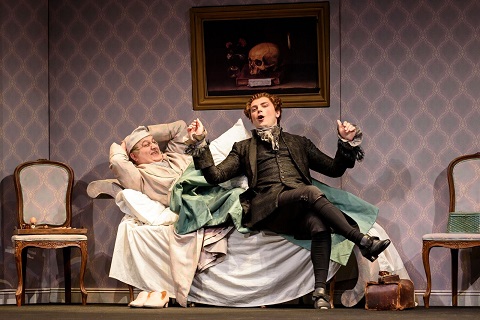 Don Pasquale (Renato Girolami) and Dr Malatesta (Andrey Zhilikhovsky) Photo credit: Bill Cooper.
Don Pasquale (Renato Girolami) and Dr Malatesta (Andrey Zhilikhovsky) Photo credit: Bill Cooper.
Moreover, Clemént’s intimations of a relationship between Malatesta and Norina add an uncomfortable tinge. Meeting the young widow in her bedroom to divulge his scheme, the doctor unties Norina’s corset, fondles her neck, and joins her, fully clothed, in her bath of bubbles. Despite the faux foam there’s not much frothiness about the scene.
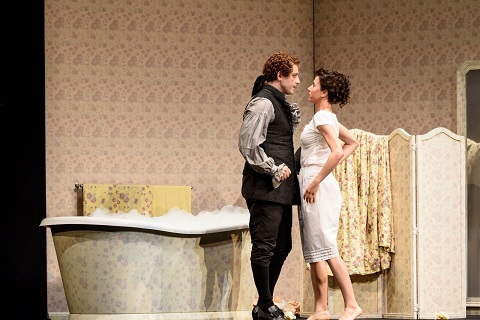 Dr Malatesta (Andrey Zhilikhovsky) and Norina (Lisette Oropesa) Photo credit: Bill Cooper.
Dr Malatesta (Andrey Zhilikhovsky) and Norina (Lisette Oropesa) Photo credit: Bill Cooper.
In any case, Malatesta may be the ingenious intriguer, but this Norina is indisputably in charge of her own destiny: indeed, we meet her seated at her desk, quill in hand, penning romantic stories, run-throughs for her own amorous fortunes. She relishes her power over the hapless Pasquale and delights in the effortlessness of his undoing; only Malatesta’s intervention stops Norina smashing the flower vase over her new husband’s head, whipped as she is into a crazed excitement by her newfound freedom and dominion. Liberated by her widowhood, flirtatious and flighty, this Norina struggles to sustain her play-acting as the demure, pure ‘nun’ who is offered to Pasquale as a bride.
It’s a weakness of Clément’s conception of the character that there is very little difference between the ‘real’ Norina and the profligate ‘Sofronia’ who unleashes her spite and snappishness on the ill-fated Pasquale. Slapped by his spendthrift bride, Pasquale is utterly humiliated but this Norina shows not the slightest twinge of regret in the face of his vulnerability. However, if Norina does not display a little essential warmth, whatever her vivacity and feistiness there’s a danger that we will lose sympathy with this heartless viper.
Juxtaposed with this harsh realism, though, Clément repeatedly foregrounds theatrical artifice. The set is a circular revolve rimmed with a swishing red curtain which withdraws to reveal Don Pasquale’s slightly down-at-heel house (presumably he’s too mean to pay for redecoration). As the overture plays - lilting lightly in conductor Giacomo Sagripanti’s hands - we spin through the old miser’s rooms and espy Pasquale, his nephew Ernesto and the latter’s beloved Norina asleep in their bedchambers, and occasionally snatch a glimpse of Glyndebourne’s stage-crew speedily redistributing beds, baths and boudoir paraphernalia. It’s a musical ‘Once upon a time’: we’re about to be told a story and there’s no doubting its author: the menacing Malatesta who creeps through bedrooms, sidling through doors, slithering through picture frames, like a Knecht Ruprecht of children’s gothic nightmares. With the concluding accelerando, the revolves spins ever faster and we tumble off the merry-go-round into the first scene.
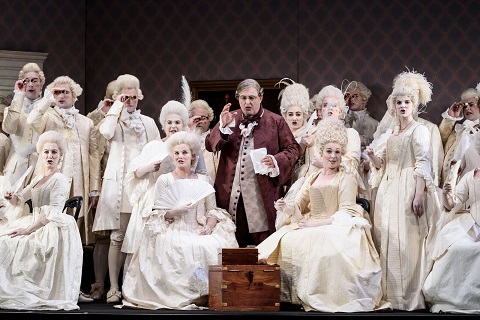 Don Pasquale (Renato Girolami) and The Glyndebourne Chorus Photo credit: Bill Cooper.
Don Pasquale (Renato Girolami) and The Glyndebourne Chorus Photo credit: Bill Cooper.
Clément uses the Chorus - in superb voice here - to sustain the stage-within-a-stage. Just when we’ve forgotten that there is a Chorus, at the end of Act 2 the principal quartet step off the revolve - as Norina, having abandoned her pretence, issues demands and summons Pasquale’s servants to carry them out - and it swivels, bringing into view an ‘audience’ of eighteenth-century ‘idle rich’, head to toe in white, watching Pasquale’s dressing-down with cool amusement. The busy overture to Act 3 brings the aristocrats back as they bustle and elbow their way through the drawn-back curtain aperture - all waggling wigs and fluttering fans - to take their places in Don Pasquale’s room, where the luckless dupe is mourning his lot, amid the mounting piles of bills, invoices, jewels and finery. Forming a formal tableau, the Chorus fling out the cries - ‘The diamonds, the brilliants — here, quick, quick!’ - which belong to the maids and milliners, hairdressers and horsemen who populate the libretto: it’s all rather disorientating.
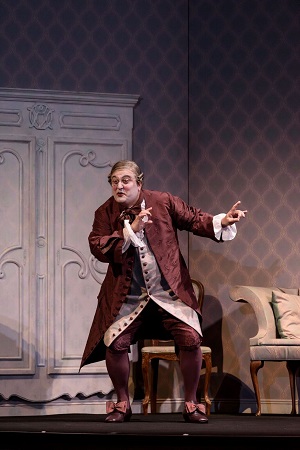 Don Pasquale (Renato Girolami) Photo credit: Bill Cooper.
Don Pasquale (Renato Girolami) Photo credit: Bill Cooper.
But, after two somewhat cold-blooded acts, the final act comes to life, not least due to some fine duets which soften the steeliness of the concept. In fact, there’s much fine singing and acting to enjoy throughout. Renato Girolami’s Pasquale blunders with charm: there’s plenty of ego-massaging and preening but as he clutches a rocking-horse and dreams of a brood of children to fill his empty rooms, it’s hard not to feel that a man who is this naïve at seventy-years-old must truly be in need of a woman’s love. Occasionally Girolami’s bass lacked focus, but he exhibited a range of colour, able to convey the languid self-absorption of the bed-bound Pasquale and, in a flash, to enrich his voice with the old lecher’s fired-up ambition. Moreover, he was good at distinguishing between the asides and self-mutterings and the text exchanged with the other characters.
Girolami made the text work, too, and the rapid-fire articulation in Pasquale’s patter duet with Andrey Zhilikhovsky’s Malatesta was one of the highlights of the evening - the more so for its slick reprise. Zhilikhovsky’s baritone was unforced and focused, even of strength, and he used a resonant legato to shape the bel canto lines effectively. He was a convincingly cunning schemer: no doubt he would make an astute Don Alfonso.
Andrew Stenson’s Ernesto - prone on his bed, reading poetry, surrounded by teddy bears - was less tempestuous poet than petulant toddler, taking his frustration out on his guitar. Stenson has a pleasing tone but lacked the necessary agility; strong through the range, at the top his tenor felt a little tight and the fortes needed more flexibility. He sang his serenade sweetly enough but was rather overpowered in his Act 3 love duet with Lisette Oropesa’s Norina.
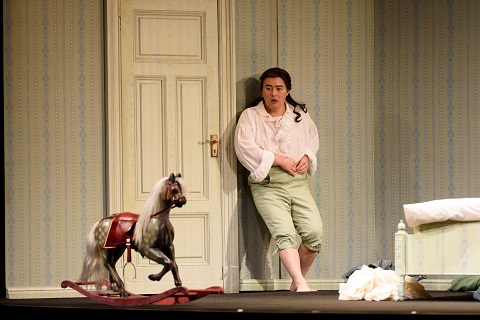 Ernesto (Andrew Stenson) Photo credit: Bill Cooper.
Ernesto (Andrew Stenson) Photo credit: Bill Cooper.
Oropesa doesn’t have a huge voice but it’s a carefully placed one that sits absolutely securely but lightly on the roulades. This was a prima donna performance in every sense, and the foot-stamping accolades Oropesa received were totally deserved. At first there was a slightly hard edge to the tone - perhaps it was intended to reflect Norina’s flintiness - but in her Act 1 duet with Malatesta, and during her raging assault on Pasquale in the final act, Oropesa’s accuracy and ease were notable.
Sagripanti gave his singers plenty of time and space in the arias, though there was some loss of ensemble during the act finales; no doubt the minor blemishes will be erased as the run proceeds. The London Philharmonic Orchestra played sensitively - including a lovely solo cello foretaste of Ernesto’s serenade in the overture and stylish playing from the trumpet in the Act 2 prelude - but also with tautness and incisiveness.
The thing about stereotypes is that in their faults and flaws we recognise our own, and such acknowledgement creates humanity and empathy. They may be caricatures, but we laugh at them and by implication ourselves. Pasquale fulminates and fumes but, ultimately, he forgives. I’m not sure, faced with the wanton cruelty of Clemént’s characters I’d have been so inclined to be generous. Yet, while Donizetti’s music may need to be sung with more of a smile in the voice, the singing on this occasion certainly offered plenty to smile about.
Claire Seymour
Don Pasquale - Renato Girolami, Dr Malatesta - Andrey Zhilikhovsky, Ernesto - Andrew Stenson, Norina - Lisette Oropesa, A Notary - James Newby, Servant - Anna-Marie Sullivan; Director - Mariame Clément, Conductor - Giacomo Sagripanti, Designer - Julia Hansen, Lighting designer - Bernd Purkrabek, Revival lighting designer - Andrew May, London Philharmonic Orchestra, Glyndebourne Chorus (Chorus Master, Jeremy Bines)
Glyndebourne Festival Opera; Thursday 13th July 2017.
image=http://www.operatoday.com/-%C2%AEBC20170708_DonPasquele_0455.jpg image_description=Don Pasquale, Glyndebourne product=yes product_title=Don Pasquale, Glyndebourne product_by=A review by Claire Seymour product_id=Above: Norina (Lisette Oropesa) and Don Pasquale (Renato Girolami)Photo credit: Bill Cooper
July 13, 2017
Billy Budd Indomitable in Des Moines
In the intimate Blank Performing Arts Center space, we are not so much observing a wrenching drama as we are participating in it. Set Designer R. Keith Brumley has outdone himself (or anyone else) with a massive prow of a hulking wooden warship that engulfs the entire playing space right up to the edge of the front row of the crescent of spectators.
Cannons poke through and point down the aisles. There are two black Jacob’s (rope) Ladders left and right allowing actors to clamber precariously above the action below, and the audience behind. A large wooden grate on the forestage has openings to allow the cast to “scurry below.” Masts feature ropes tied off in various ways so that the audience is looking through them as if part of the action. Upstage is filled with a two-tiered structure, the top of which serves as an upper deck flanked by stairs. Below, the structure contains Vere’s office, which moves forward and is revealed by the removal of four panels. To suggest the sailors’ cramped quarters below deck, two side pieces advance as though suggesting “arms” that enclose the action. A large hanging grate is positioned above the scene to replicate the one the sailors crawled through down center.
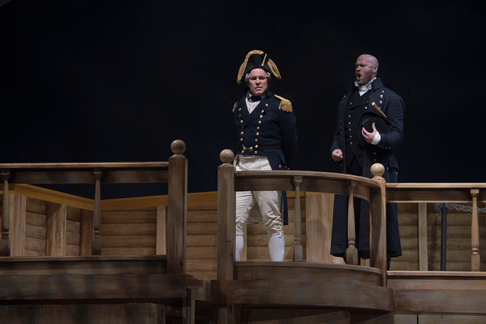 Captain Vere (Roger Honeywell) is confronted by Claggart (Zachary James)
Captain Vere (Roger Honeywell) is confronted by Claggart (Zachary James)
The excellence of Barry Steele’s remarkable, moody lighting design was surpassed only by his exquisite projections. Jonathan Knipscher’s distinctive costumes greatly illuminated the characters, and aptly defined the caste system of the differing military strata. Brittany Crinson’s detailed make-up effects, including wounds and scruffily dirt-smudged sailors contributed much to the successful look.
I had never experienced an opera this large and active in such an intimate space, and director Kristine McIntyre did a masterful job filling every nook and cranny with meaningful action and carefully rehearsed “spontaneity” without putting us on sensory overload. Having successfully negotiated this huge group around that limited space, I think Ms. McIntyre is ready to be a traffic controller at O’Hare. But she also knew when to let her forces be still. When Lisa Hasson’s impeccable chorus and the soloists stood and poured out their climactic, overwhelming war cry in Act Two, it was electrifying in its raw emotion.
Kristine also knows how to wring every conceivable variation out of well-motivated blocking, usage of levels, and meaningful character relationships. Each of the principals clearly understood the dynamic and arc of their roles, and the monologues were coached and crafted like one act plays. This was a remarkable directorial realization, one that nurtured faultless ensemble playing as well as encouraging stand-alone personal bests.
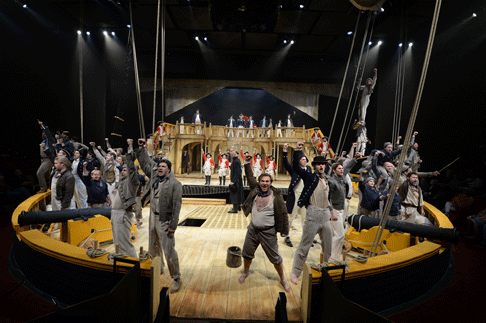 “Now Is the Moment”
“Now Is the Moment”
Craig Verm was first a playful, then a powerful Billy Budd. Mr. Verm possesses a burnished, rolling baritone that has a particularly inviting timbre. He also has such a vibrant, handsome, guileless presence that “Oh, beauty, handsomeness, goodness” is an understatement. From his first, naïvely eager statements, through his affecting bouts of stammering, to his exultant "king of the world" arioso perched on the rope ladder, to his gradual disbelieving betrayal and assumption of a tragic stature, Craig was every moment the star vocal and theatrical presence that galvanized the performance.
He had the audience in the palm of his hand the entire opera. When he is falsely accused, and cannot answer the charge owing to his stammer, patrons actually leaned forward in their seats, wishing they could help him. When he desperately pleaded with Captain Vere to “save him,” I wish I had had the Kleenex concession. His final prison monologue was heart wrenching, even if he tired just a bit by its end. Never mind, you just won’t see a finer Budd than that on view from Craig Verm.
Much the same could be said for bass-baritone Zachary James as the evil John Claggart. His imposing stature, his bad boy good looks, and most of all, his searing, orotund vocal production combined to make him a definitive Master at Arms. While he is consistently insistent in enforcing his discipline, Mr. James finds astonishing nuance in his delivery, as he is both physically and intellectually attracted to Billy, all the while disgusted by it. You will likely never hear Claggart’s aria more passionately performed with compelling tortured feelings, yet with rock solid vocalism. And Zachary’s death spiral after the fatal punch, ending fallen flat on his face, was beyond any physicality I have ever seen in this critical plot moment.
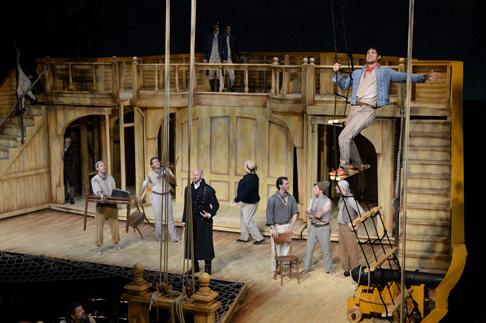 Billy Budd (Craig Verm on ladder): “Billy Budd, king of the world.”
Billy Budd (Craig Verm on ladder): “Billy Budd, king of the world.”
Completing the principal triangle, Roger Honeywell gave the performance of his life as Captain Vere. I have enjoyed any number of memorable, conscientious performances by Mr. Honeywell over the years but none has engaged him this completely. The part was written for the sometimes precious crooning of Britten’s life partner, tenor Peter Pears. Well, Roger was having none of that! He waded in to this troubled, challenged character with grit and a feisty self-awareness, and he deployed his potent tenor with skill and precision.
These days, Roger pulls a few tricks to negotiate a few of the uppermost, soft passages, but he puts every utterance in service of the drama. His tortured, internalized debate of how to do the right thing was anguishing in its dichotomy of duty versus ethics, correctness or compassion. He began and ended the show as a clouded soul, doddering barefoot in his bathrobe, almost a spectral presence. His was a mesmerizing interpretation, uniquely his own.
The entire cast was so uniformly splendid that it may be odious to single out any smaller roles, but I must commend at least a few. Michael Adams utilized his commanding baritone to great effect as Donald. His interplay with Billy in the rough housing musical challenge in the sailors’ quarters was delightful, and impetuously kissing Billy at its end was a sassy touch. Thomas Hammons’ mature baritone proved a real asset as a touching Dansker. Christian Sanders’ clear, shining tenor served the role of the Novice well, and Emmet O’Hanlon was his wonderfully sung Friend. Ryan C. Connelly had just the right, bright sound in his well-schooled tenor to succeed as Squeak. Dennis Jesse (Mr. Redburn) and Federico de Michielis (Mr. Flint) were distinctive vocal personalities, as was the smoothly sung Lieutenant Ratcliffe from Kristopher Irmiter.
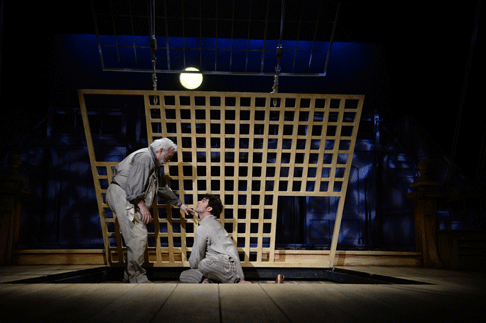 Dansker (Thomas Hammons) visits imprisoned Billy (Craig Verm)
Dansker (Thomas Hammons) visits imprisoned Billy (Craig Verm)
Finally, in the pit, David Neely conducted a brilliant, insightful performance of Britten’s masterpiece. Make that “Monster Piece.” Billy Budd is scored for a virtuoso orchestra, and the DMMO musicians rallied to meet every challenge. Maestro Neely, his cast and band have delivered unto us as great a musico-dramatic achievement as is possible.
I have seen six other good productions of this piece over my years of opera going and I have always thought that, when all its planets align, it should make me weep but it never quite did. Well, Mission Accomplished. When Vere sang his final, diminishing statements, and the “sail” descended from above with its projection of rolling waves; and when the final projections first showed a silhouette of Billy’s hanging corpse, then morphed to Billy’s wrapped body floating to the depths, and then to Billy’s handsome face dissolving into the waves; well, this was a moment of surpassing beauty. And damn if the tears aren’t streaming again right now. . .
James Sohre
Cast and production information:
Billy Budd: Craig Verm; Edward Fairfax Vere: Roger Honeywell; John Claggart: Zachary James; Mr. Redburn: Dennis Jesse; Mr. Flint: Federico de Michelis; Lieutenant Ratcliffe: Kristopher Irmiter; Red Whiskers: Steven Sanders; Donald: Michael Adams; Dansker: Thomas Hammons; Novice: Christian Sanders: Novice’s Friend: Emmett O’Hanlon; Squeak: Ryan C. Connelly; Bosun: Timothy Bruno; Maintop: Chris Carr; Arthur Jones: Ted Pickell; 1st Mate: Brandon Hendrickson; 2nd Mate: Jesse Stock; Cabin Boy: Benjamin Sarvis; Conductor: David Neely; Director: Kristine McIntyre; Set Design: R. Keith Brumley; Costume Design: Jonathan Knipscher; Lighting and Projection: Design: Barry Steele; Make-up and Hair Design: Brittany Crinson for Elsen and Associates; Chorus Master: Lisa Hasson
image=http://www.operatoday.com/DSC_0260.png
image_description=Claggart (Zachary James, right) falsely accuses Billy (Craig Verm, left) and Vere observes (Roger Honeywell). [Photo by Duane Tinkey]
product=yes
product_title=Billy Budd Indomitable in Des Moines
product_by=A review by James Sohre
product_id=Above: Claggart (Zachary James, right) falsely accuses Billy (Craig Verm, left) and Vere observes (Roger Honeywell).
Photos by Duane Tinkey
July 11, 2017
Tannhäuser at Munich
We thereby run the risk of becoming ultimately almost as conventional as those we think we have left behind. I shall happily admit that I have been wrong, should I see this staging again, crack the code — if code there be — and find greater enlightenment than I did on this occasion. As it stands, however, I found myself somewhat disappointed by a staging that seemed to pale beside Castellucci’s fascinating Paris Moses und Aron — to which there were perhaps a few too many visual resemblances for comfort, let alone provocation — or indeed to what I know of his other theatrical work. That Castellucci has thought intelligently about Tannhäuser is clear from an interview in the programme; I wish, though, that there were more of a sign, at least to me, that such thoughts had made their way into the staging. There were times, I am afraid, when this production, for all its stylised, internationalised ‘beauty’, veered close to the merely boring.
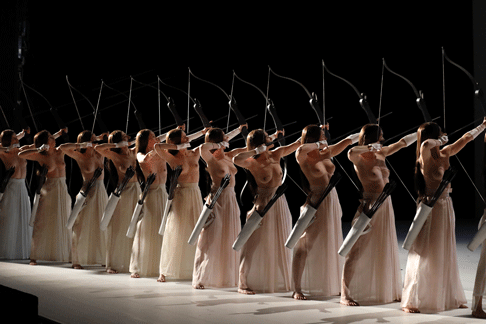 Opernballett der Bayerischen Staatsoper
Opernballett der Bayerischen Staatsoper
The setting is almost brazenly non-specific. There is nothing intrinsically wrong with that, especially when Wagner himself treads the line between myth and ‘historical’ drama. An air of mystery, even of mystification, concerning where we are, who these people may be, is in many respects welcome; not everything need be set in a present-day or time-of-composition warzone. The sinister quality of strange rituals is palpable. Is there perhaps a hint of ISIS or some such in the cult-like environment of the world beyond the Venusberg? Perhaps, but it all begins to look a little too much like the world we had seen in Moses and, more to the point, so what (without anything more on which to go)? Is there not a hint of Wieland Wagner without the content — he himself has often been accused of having, for ideological reasons, divested his grandfather’s dramas of much of their content — and in the achingly fashionable, yet vacuous, scenic language of the modern corporate art installation? Unlike many operagoers I am not, I hope, one to roll my eyes at the mere mention of interpretative — or non-interpretative — dance, but does the beautifully choreographed movement do anything more than, well, be beautiful? Is that the point? It may well be, but at some point, might it not be argued, or at least demonstrated? Or am I again missing the point, hidebound by my own, doubtless Teutonic or even Socratic preconceptions? Designers — Castellucci is to an extent his own — have their tics, of course, their house styles; but what is the idea, even the Idea, shrouded, often literally, by the undeniable style?
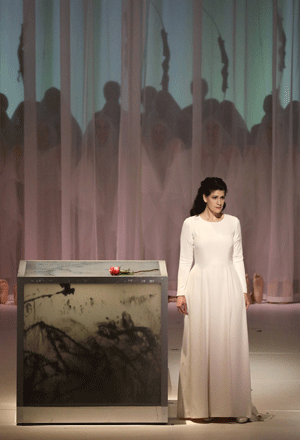 Anja Harteros (Elisabeth)
Anja Harteros (Elisabeth)
Great play — great scenic play, at least — is made of the kinship between the harp of the Minnesänger and the crossbow of the warrior. It is an interesting idea, not least in this most dualistic — at times, catastrophically if fascinatingly so, in dramaturgical terms — of Wagner’s operas. (In Tristan, even, there is more mediation than here, and it is of course infinitely more accomplished not only than Tannhäuser but than most other human drama in giving the appearance of reconciliation even when ‘reality’, whatever that may be, belies that appearance.) Alas, it never really progresses beyond a few striking visual signs, whereas an explanation, not necessarily didactic, of the relationship between art and war, love and death, is surely invited here. Even the ugliness of the fatty mound that is the Venusberg and its outgrowing creatures — the decay of boredom, satiation, and so forth, I presume — is so ‘beautifully’ stylised as to lose its dualistic edge. Or did it never have that edge in the perfect place? Lacan is clearly going round and round here, but is anything more than that happening? Again, is that the point? The second act has a great deal of slow business with people almost losing themselves in curtains; well, not a great deal, just much repetition of a little business, really. There is something intriguing about whether that mysterious thing is, flailing, writhing, maybe writing, in the central box, on which the singers’ principal concepts are inscribed; at the same time, there is a little, however inadvertent, of a Dr Who monster to it too.
I have no idea why the tombs in the third act are inscribed ‘Anja’ and ‘Klaus’ rather than ‘Elisabeth’ and ‘Heinrich’; whatever metatheatrical point may have been made quite eluded me. Likewise the passing of increasingly absurd increments of time, signalled in an o-so-‘beautiful’ typeface: from one second, to endless milliards of milliards of years. Meanwhile corpses rot — beautifully, tastefully, needless to say. The actual singers look on and occasionally move around. Eternity, perhaps, although it never actually reaches that state? Is that, again, the point? Is there a role for history after all? I certainly hope so, in this most Hegelian of composers, but I am afraid I had simply ceased to care. Having opened by saying how different Castellucci’s aesthetic was from what we tend to see in opera, I have to admit that the results, if not the intent behind them, were in some respects not so very different from Sasha Waltz’s explicitly balletic production (verging on non-production) for the Berlin State Opera. As I said above, I should be delighted to be proved, even to prove myself, wrong; none of us is infallible. I did so over Frank Castorf’s Bayreuth Ring. Perhaps I simply need to immerse myself more in Castellucci’s way of thinking; or perhaps this was not his finest hour. Time will tell.
We need await no passing of time to reach some sort of critical judgement on the musical side of things: never less than good, in some cases quite outstanding. I do not think Tannhäuser is really the role for Klaus Florian Vogt; Lohengrin is. And yet, the unearthly, almost pre-pubescent (on steroids) beauty of the voice can bring fruitful contradictions of its own, intentional or no. What if Tannhäuser is just an overgrown choirboy after all? Vogt certainly has the stamina for the role, and can sings its notes — even if he relied a little too much, especially during the first act, on the prompter, whose sibillants were almost as audible as Vogt’s own. Anja Harteros gave an excellent performance, although I could not help but think that this was perhaps not quite the role for her. She seemed almost as if she would have been happier singing Verdi; at any rate, she gave the impression of trying to play a ‘character’, which Elisabeth is perhaps not, at least in a straightforward sense. Whatever Tannhäuser may involve, it is not straightforwardly a world of psychological realism. Christian Gerhaher’s Wolfram was at least as beautifully sung as any I have heard from him (which is saying quite something indeed). It was not just beautiful though; there was an edge, an anger even, suppressed or otherwise, which had the character, such as he is, become more rounded, more interesting than I can recall. Elena Pankratova’s Venus was finely, even movingly, sung, her reappearance in the third act from on high (unseen) quite magical. Georg Zeppenfeld’s Margrave and Dean Power’s Walther von der Wogelweide also stood out, making the most of their roles without exaggeration. Choral singing, once again, was quite outstanding, a tribute both to members of the chorus and to Soren Eckhoff, their chorus master.
Last but certainly not least: Kirill Petrenko’s direction of the outstanding (once again!) Bavarian State Orchestra, whose depth and variety of tone are truly second to none. Petrenko’s way with the score is anything but conventional, without ever so much of a hint of being ‘different’ for the sake of it. If my preference, lazy or otherwise, is for the more overtly symphonic line a conductor such as Daniel Barenboim brings to this music, Petrenko’s insistence upon the individuality of ‘numbers’ — which to all intents and purposes they are, or at least can be — within the score reaps its own, explicitly musico-historical rewards. He has clearly thought about each section, however defined, and how it might characterise it — and, moreover, is able to do so. The Overture, for instance, began in surprisingly Mendelssohnian fashion, blossoming, expanding into something more, as if to suggest Wagner finding his way from roots he may or may not have wished to acknowledge. In the second act, Wagner’s antecendents in French opera, not least Meyerbeer, came very much to the fore, without loss to a greater sense of the whole. The third act was more truly ‘symphonic’; here, one felt, the Wagner of the music dramas proper had arrived. Fascinating, instructive, provocative in the best sense: more so, alas, than what I was able to glean from Castellucci.
Mark Berry
Cast and production information:
Hermann, Landgrave of Thuringia: Georg Zeppenfeld; Tannhäuser: Klaus Florian Vogt; Wolfram von Eschenbach: Christian Gerhaher; Walther von der Vogelweide: Dean Power; Biterolf: Peter Lobert; Heinrich der Schreiber: Ulrich Reß; Reinmar von Zweter: Ralf Lukas; Elisabeth: Anja Harteros; Venus: Elena Pankratova; Shepherd Boy: Elsa Benoit; Four Pages: Members of the Tölz Boys’ Choir. Director, Designer: Romeo Castellucci; Choreographer: Cindy van Acker; Assistant Director: Silvia Costa; Dramaturgy: Piersandra di Matteo, Malte Krasting; Video Design and Lighting Assistance: Marco Giusti. Chorus of the Bavarian State Opera (chorus master: Sören Eckhoff)/Bavarian State Orchestra/Kirill Petrenko (conductor). Nationaltheater, Munich, Sunday 9 July 2017.
image=http://www.operatoday.com/LM0A2159.png image_description=Klaus Florian Vogt (Tannhäuser) [Photo © Wilfried Hösl] product=yes product_title=Tannhäuser at Munich product_by=A review by Mark Berry product_id=Above: Klaus Florian Vogt (Tannhäuser)Photos © Wilfried Hösl
Des Moines Answers Turandot’s Riddles
The leading roles were deluxe casting , the envy of any world opera house. There are few roles with more baggage than Turandot and Calaf. The legendary pairing of Nilsson and Corelli is still discussed in opera circles, and even if we never heard them live, their voices are still in our head. Too, Pavarotti owned the aria Nessun dorma, and even thought he didn’t do all that many performances of the full role, interpreters are judged against that gold standard. Happily, our title role interpreter and her princely suitor were up to the task.
Alexandra Lobianco is well remembered here for her feisty Minnie in a recent season. If Fanciulla is a Big Sing for the soprano, Princess Turandot is a Big Sing on Steroids. The fiendishly high, clarion singing required is balanced with the need for controlled delicacy after her conversion to a loving mindset. Ms. Lobianco is short of physical stature, but makes up for it with potent spinto vocalizing that has its own towering presence. As she kept pouring out laser-focused riddles, rising in pitch as well as intensity, we sat wondering: “Where is all that glorious voice coming from”?
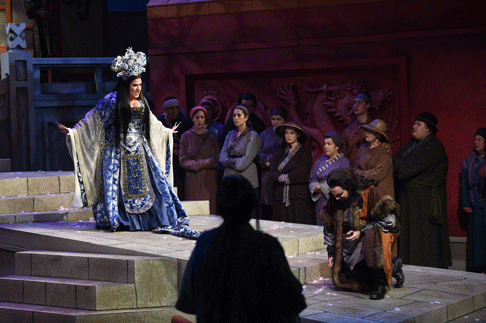 Alexandra Lobianco (Turandot) and kneeling, Jonathan Burton (Calaf)
Alexandra Lobianco (Turandot) and kneeling, Jonathan Burton (Calaf)
Later, after she is vanquished, Alexandra’s Princess was able to lighten and mellow her legato phrases to convey first crushing defeat, then willing acceptance. From hostility to acquiescence, from fortissimo to pianissimo and all points between, nothing about this taxing role eluded her. She has recently successfully debuted at the Vienna State Opera, and further stardom is surely to follow.
Jonathan Burton is a match made in heaven, having previously paired so wonderfully with this soprano in the Golden West. Mr. Burton sings this role as successfully as anyone around, with a firm, substantial tenor that has plenty of buzz and boom. When he is called upon to ride the full orchestra, stand back! He can pin your ears to the back wall. But he can also rein in his large voice to suggest a glowing lyricism that is irresistibly charismatic. Could lightning strike a third time, and could DMMO lure this perfectly paired duo back for yet another collaboration? Please, Opera God?
As the one sympathetic character in the love triangle, and with two memorable arias, Liu can often run off with the show, and Vanessa Vasquez gave her co-stars a run for their money. Ms. Vasquez is a major “find,” with a stunningly rich lyric soprano, leaning into the spinto territory. Her poised pianissimo flights above the staff were heart stopping in their beautiful timbre. Combined with her impeccable musicianship and endearing presence, Vanessa’s star is on the rise.
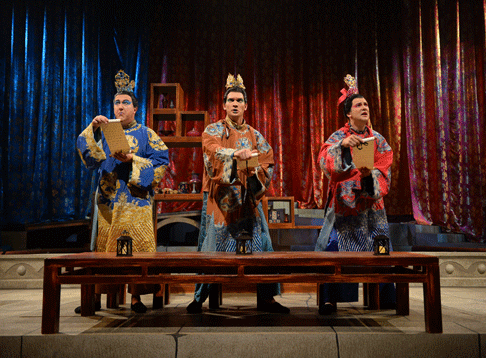 From Left, Pang: Brian Frutiger; Ping: Michael Adams; Pong: Chris Carr
From Left, Pang: Brian Frutiger; Ping: Michael Adams; Pong: Chris Carr
Ping (Michael Adams), Pang (Brian Frutiger) and Pong (Chris Carr) were particularly well sung, with polished flair, and consummate beauty of line. While their movements and gestures were cleverly coordinated, and while they functioned beautifully as a unit, each proved an accomplished, distinctive soloist. Mr. Adams showed off an ample baritone with lustrous tone; Mr. Frutiger sported a gleaming, incisive tenor; and Mr. Carr’s pointed lyric tenor instrument provided much pleasure. As Timur, Federico de Michelis’ authoritative, freely produced bass suggested a gravitas beyond his years. Similarly, young Ryan C. Connelly, decades too young for Emperor Altoum, successfully colored his pleasantly reedy tenor to cunningly suggest an aged monarch. As the Manadarin, Timothy Bruno chanted his pronouncements with solid authority.
Lisa Hasson’s superb chorus was the last major “cast member” and they sang with wondrous character and musical sweep. In such a modest sized house, this was the closest to operatic Surround Sound we might ever experience. The goose bumps are returning even as I write.
Music Director David Neely conducted his amassed forces with a loving, knowing baton. DMMO populates its pit with highly accomplished professional musicians from throughout the region (and beyond) and their incisive playing is second to none. The orchestra was a compelling partner in the musical drama, and they rose to meet every challenge.
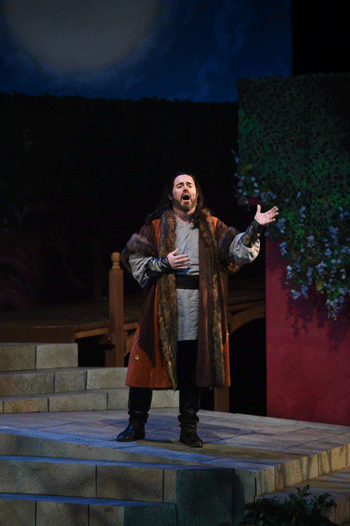 Jonathan Burton (Calaf) sings “Nessun Dorma”
Jonathan Burton (Calaf) sings “Nessun Dorma”
We have come to expect so much from DMMO that is innovative and forward looking, that it is a gentle surprise to find that this production of Turandot was more an homage to a glorious past. R. Keith Brumley’s handsome set design was wholly functional, suitably Chinese, and cleverly varied. A long set of stairs and platforms bisected the main stage from high up left to stage level stage right. Towers, drapes, and insets were moved in and out to suggest other locales, but his was one of those basic ‘unit foundation’ sets necessitated by budget realities in the 70’s. The effective costumes were courtesy of Mary Traylor and Lyric Opera of Kansas City, while Barry Steele contributed a straight-forward, well executed lighting design.
Director Stephanie Sundine has done a good job managing traffic (no small feat), and underlining the important Big Moments. Liu’s suicide had an admirable clarity and focus. But (pace Puccini) Turandot is not always dramatically propulsive, and there are stretches of (albeit beautiful) music where nothing of consequence is happening. Ms. Sundine did not completely solve the visuals of these slack moments, and too often the chorus was posed in pleasant rows, with principals left to look ‘interested.’
Small matter perhaps, as in a prima la voce mind set, this Turandot was a night to remember, and cherish.
James Sohre
Cast and production information:
Princess Turandot: Alexandra Lobianco; Emperor Altoum: Ryan C. Connelly; Timur: Federico de Michelis; Calaf: Jonathan Burton; Liu: Vanessa Vasquez; Ping: Michael Adams; Pang: Brian Frutiger; Pong: Chris Carr; Mandarin: Timothy Bruno; Prince of Persia: Nate Carter; Executioner: Paul Schmidt; Conductor: David Neely; Director: Stephanie Sundine; Set Design: R. Keith Brumley; Lighting Design: Barry Steele; Costume Design: Mary Traylor, Lyric Opera of Kansas City; Make-up and Hair Design: Brittany Crinson for Elsen and Associates; Chorus Master: Lisa Hasson
image=http://www.operatoday.com/DSC_0407.png
image_description=Vanessa Vasquez (Liu) and Jonathan Burton (Calaf) [Photo by Duane Tinkey]
product=yes
product_title=Des Moines Answers Turandot’s Riddles
product_by=A review by James Sohre
product_id=Above: Vanessa Vasquez (Liu) and Jonathan Burton (Calaf)
Photos by Duane Tinkey
Maria Visits Des Moines
While its three main stage productions continue to be performed in Blank Performing Arts Center on the Simpson College campus, 30 minutes away in Indianola, DMMO systematically develops audiences by mounting innovative smaller productions of non-standard repertoire in the heart of Iowa’s capital city. The success of this outreach is attested to by consistent sold out runs of these innovative projects.
Maria was presented in the historic Temple for the Performing Arts, which proved to be a most congenial fit. Set designer Adam Crinson has created an effective environment to enfold the action, with large, framed rectangular collages of distressed wooden window shutters spaced throughout the sides of the auditorium. Selected front row seating was at tables and chairs, with some also spilling up onto stage left, suggesting a tango nightclub venue. Mr. Crinson carried the distressed wood look into the backdrop, which was constructed of vertical slats topped by a wide, textured fabric wall hanging. A matching proscenium treatment, and rolling bar unit stage right completed the simple, limited, but eminently practical playing space.
Nate Wheatley has contributed an inventive lighting design that beautifully serves the dramatic, brooding text and music. The afore-mentioned ubiquitous panels each had individual lights installed at the top, which could alter the color wash to suit the mood. Above the stage hung variations on white globe ceiling lights, which could also change hue. Mr. Wheatley managed to alter the general area lighting with good success, although he was likely restrained from adding more specials by the limited number of instruments I counted. One effect that paid off handsomely was the tight center aisle spot that allowed Maria to wander into the audience during her penultimate number.
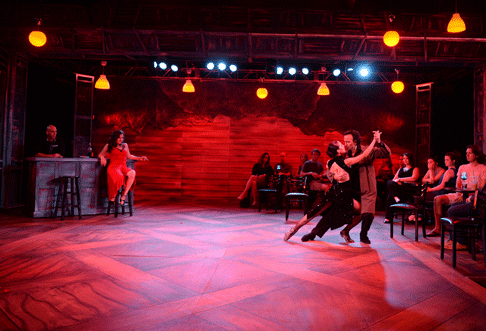 Astor Piazzolla’s “Tango Opera”
Astor Piazzolla’s “Tango Opera”
Heather Lesieur and Atlanta Opera are credited with the spot-on, character-specific costumes, a stunning array of jewel tones and reds. The selective use of masks and primitive props added to the gritty ritualistic tone of the storytelling, which was staged with inventive mischief by director Octavio Cardenas.
Mr. Cardenas embraced the composition, and acknowledged that it is decidedly not a linear tale. He created a 90-minute series of constantly morphing impressions, characterized by fluidity of motion and variety of theatrical effects. He seized on the rampant symbolism and distilled it into comprehensible dramatic points. Octavio used the entire space as his canvas, with actors entering and exiting from every nook and cranny, meticulously coordinated, but nevertheless suggesting a spontaneous, immersive theatrical experience.
The distinctive score was conducted with aplomb and incisive rhythmic propulsion by Stefano Sarzani, who numbered several Piazzolla “specialists” in his small orchestra: Daniel Binelli (Bandoneon) Polly Ferman (Piano) and Scott Mateo Davies (Guitar). All of the instrumentalists performed with real distinction for Maestro Sarzani, whether as part of a tightly knit ensemble or as featured soloist, often playing with raw energy. That said, I sometimes wished the subtle, tasteful solo violinist had summoned a little more zesty sass in the jazzy licks.
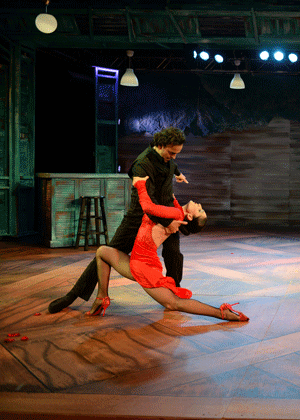 Tango Dancers Jairelbhi Furlon and Guillermo Merlo
Tango Dancers Jairelbhi Furlon and Guillermo Merlo
The band was stage right of the proscenium, and was sometimes part of the action. The interplay between bandoneonist Binelli and the narrator was especially witty. The sound palette of this unique musical world was consistently on point, and the band partnered exceptionally well with the singers and dancers. I only wish that the actors hadn’t been miked. The volume was half again as much as was needed, if it was indeed really needed at all. No matter where a performer was sanding on stage, the voice seemed to be coming from the top center of the proscenium. Perhaps this could be adjusted for remaining shows.
Even with that caveat, from her first appearance the stunningly attractive Elise Quagliata owned the title role. The part mostly lies in the low register, where Ms. Quagliata’s searing chest voice made a powerful effect. It may have been the amplification, or the mix, but in the first scene she sounded just a bit pressed, the tone tending to harden as she took a belting approach to the writing. However as the evening went on, Elise quickly relaxed the delivery, finding increasingly more legato that showed off her poised tone to perfection in a wide range of demanding emotional states. Dramatically and musically, she does not so much perform the part as inhabit it. A remarkable star turn.
Rodolfo Nieto’s El Duende (The Goblin, as narrator) is marked by a sensitive, impassioned delivery that too, is hindered a bit in his effect by the volume knob. That Mr. Nieto nonetheless makes an imposing, invaluable narrator is owing to his charisma and dramatic stature. As El Payador (Cantor or Minstrel) baritone Ricardo Rivera made the most of the diverse vocal demands, offering suave vocalism of the first rank whether investing introspective phrases with a haunting grainy quality; slamming out declamations above the staff with ferocious power and accuracy; or spinning out creamy melodies with a melting arch of gorgeous sound.
This piece is billed as a tango opera, and there are plenty of such moments to savor as a lithe pair of dancers, Jairelbhi Furlong and Guillermo Merlo, found a diverse array of effects with which to engage and delight us. Performing their own inventive choreography, the duo skillfully incorporated select props into their routines including a red scarf, an A-frame ladder, and best, a man’s suit jacket which they kept passing back and forth by inserting arms in empty sleeves. Yahaddabethere! Their every duet was rapturously received.
With this memorably stylish, cheered-to-the-rafters production of a seldom performed jewel, DMMO reminds us yet again why they are one of the most invaluable regional companies in the nation.
James Sohre
Cast and production information:
Maria: Elise Quagliata; El Duende: Rodolfo Nieto; El Payador: Ricardo Rivera; Young Maria: Lauren Verm; Dancers: Jairelbhi Furlong, Guillermo Merlo; Conductor: Stefano Sarzani; Bandoneon: Daniel Binelli; Piano: Polly Ferman; Guitar: Scott Mateo Davies; Director: Octavio Cardenas; Set Design: Adam Crinson; Lighting Design: Nate Wheatley; Make-up and Hair Design: Brittany Crinson for Elsen and Associates; Costumes: Heather Lesieur, Atlanta Opera
image=http://www.operatoday.com/DSC_5699.png
image_description=Maria (Elise Quagliata) with El Payador (Ricardo Rivera) [Photo by Duane Tinkey]
product=yes
product_title=Maria Visits Des Moines
product_by=A review by James Sohre
product_id=Above: Maria (Elise Quagliata) with El Payador (Ricardo Rivera)
All photos by Duane Tinkey
Die schöne Müllerin: Davies and Drake provoke fresh thoughts at Middle Temple Hall
But, Schubert dedicated Die schöne Müllerin to the amateur singer, Baron Karl Freiherr von Schönstein. Schönstein was a baritone, as was Michael Vogl who was regularly accompanied by Schubert in performances of the composer’s lieder, and who, in 1830, wrote vocal embellishments for an edition of the cycle by Anton Diabelli - a publication which reveals much about how Vogl might have actually performed these songs with Schubert. Certainly, there is ample precedent for baritones past and present, including Fischer-Dieskau who recorded the cycle three times, and even contraltos such as Nathalie Stutzmann , performing Schubert’s twenty Müller settings, transposed to a lower range.
Even so, countertenor Iestyn Davies’ recital with Julius Drake at Middle Temple Hall was an intriguing prospect. A search for previous performances of the cycle by countertenors unearthed a 1997 recording by Jochen Kowalski for Capriccio and some performances in Germany during the late 1990s by Austrian countertenor Bernhard Landauer (who has also sung Winterreise). Davies and Drake essentially performed the Bärenreiter edition for low voice (transposed down a fourth), but they made half a dozen or so substitutions of individual songs, presumably to better accommodate Davies’ range or because some songs sit awkwardly in particular keys.
In the opening songs, the clear tone and freshness of Davies’ countertenor bestowed some dramatic advantages, capturing the young man’s lightness of spirit as he embarks on his journey with optimism and a spring in his step, sure that fortune and love lie ahead. Davies seemed to deliberately aim for an almost airy lightness, though even as early as the second song, ‘Wohin?’ (Where to?), there was the slightest hint of anxious urgency as the wanderer questions the babbling brook where it is leading him. But, when the vocal line rose - as in the song’s closing vision of the mill-wheels turning in every clear stream (‘Es gehn ja Mühlenräder/In jedem klaren Bach!’) - there was a flash of translucency as pure as the cleanest spring-waters.
Countering this lucid wholesomeness, though, was an occasional lack of fullness and weight to the tone, in the lower register, which deprived some of the songs of their impetuous drive. ‘Halt!’, for example, needed a more pressing dynamism, while in ‘Mein!’ (Mine) Davies struggled to compete with the unremitting energy of the piano part as he asserted, with almost desperate fervour, that the girl was his. Again, only when the voice rose - ‘Die geliebte Müllerin ist mein!’ - did we sense the young man’s joyful triumphalism; the equivalent of a vocal punching of the air.
In some of the strophic songs there was a lack of variety in the vocal colour, too. And, while Davies worked hard with the text, the words sometimes didn’t make their mark against busy accompaniments - despite Drake’s sterling efforts to rein in the rapid, low passagework. In ‘Jäger’ (The hunter), the voice seemed to be struggling to chase the piano’s incessant, dry triplets and the text was lost, while in ‘Eifersucht und Stolz’ (Jealousy and pride), which followed segue, the bitter repetitions of ‘sag ihr’ (tell her) were swallowed by the piano’s racing rage in the bass.
However, these minor misgivings which were more than outweighed by the imaginative psychological portrait that Davies and Drake created, and by the convincing coherence of the narrative arc of the sequence. The tragic peak was not reached too early. It was only when the young lass got up to leave the miller in the final stanza of ‘Tränenregen’ (Rain of tears) - after Davies had conjured a melting introspection as the miller becomes absorbed in the brook’s reflection of his loved one’s eyes - that there was a slight hardening of the vocal tone which, together with the minor key coloration in the accompaniment, hinted at future rejection. A tense hiatus before the twelfth song, ‘Pause’, painfully undermined the apparent self-belief of ‘Mein!’; there followed an accumulating dynamism, before the recognition, despair and resignation of the closing songs.
And, even ‘weaknesses’ could be used to advantage, as at the close of ‘Am Feierabend’ (When work is over) where the mill-owner’s dismissal of his workforce lacked the forcefulness of the miller’s recollection of the mill-girl’s evening farewell, thereby conveying the young man’s own lack of masculine maturity. Similarly, the two speakers in the mournful, stalling ‘waltz’, ‘Der Müller und der Bach’ (The miller and the brook), may not have been strongly differentiated vocally but there was a convincing rhythmic contrast between the floating lilt of the miller’s dolefulness and silken dreams of the cool peace of dark waters, and the brook’s more energetic realism.
Davies was at his best in the slower, simpler settings, where he crafted his beautiful countertenor into unbroken legato lines of soft sweetness. In ‘Danksagung an den Bach’ (Thanksgiving to the brook) there was, beguilingly, also a sense of incipient strength beneath the unruffled surface, as the miller saw hope in the sun’s brightness. ‘Der Neugierige’ (The inquisitive one) had the rhetorical pathos - ‘Sag, Bächlein, liebt sie mich?’ (Tell me, brooklet, does she love me?) - of the most bittersweet Elizabethan lute song. In ‘Morgengruß’ (Morning greeting), the rising sixth which commences each stanza shone with innocent idealisation while the falling vocal resolutions of the miller’s hesitant questions and the slightest withdrawal of the piano cadences captured the fragility of his dreams and trembling disturbance of his fears.
For all the ambiguities, though, the cycle is anchored by the constancy of the brook’s presence, and Drake expertly conjured the stream’s changing moods: from cheerful babbling, to angry churning, to - in the final song - soothing relief. The position of the piano part is quite low, even before transposition, and Drake’s skill and sensitivity in overcoming the challenges that this low tessitura presents - the danger of ‘muddiness’, the elusiveness of true pianissimo - was remarkable: the touch was unfailingly gentle but never at the expense of clarity and detail.
In the second half of the cycle, Davies’ countertenor became richer and more focused, evoking the growing strength of the miller’s emotional uncertainty. This anxiety was powerfully expressed at the close of the penultimate stanza of ‘Pause’ where, having hung up his lute the miller fears that its strings - whose music he can no longer bear, so full is his heart - will be brushed by a breeze, or a bee: ‘Da wird mir so bange und es durchschauert mich’ (I shall feel afraid and shudder). Davies left the fermata hanging, the pain of the lingering silence finding expression in the bitter harmonic dissonances of the final stanza, and the poignant major-minor twists of the piano’s postlude.
In these latter songs, and particularly in the final three songs, Davies’ miller seemed much more than an embodiment of Romantic Sehnsucht, as one finds expressed by the deathly inertia of ‘Trockne Blumen’ (Withered flowers) and the song’s closing expression of the Romantic faith that true love can find fulfilment only in death. Instead, it was the modernity of Die Schöne Müllerin which Davies and Drake made captivatingly evident: the restlessness of a disturbed, perhaps delusional, young man who veers between defiant hope and suicidal torment - a restlessness which is enhanced by the fragmentation of the narrative, which offers only brief, subjective glimpses of an imagined external world.
And, this sense of disjuncture was enhanced by what initially seemed unsatisfying - the frequent large distance between Davies’ countertenor line and the low-lying piano accompaniment. As the cycle progressed this literal distance increasingly conveyed a psychological schism - as in ‘Pause’, when the piano repeats well-defined rhythmic motifs against which the voice drifts in self-absorbed musing. The contrast between the vocal leaps in ‘Die liebe Farbe’ (The beloved colour) and the piano’s middle-voiced repeating note, together with the harmonic changefulness of ‘Die böse Farbe’ (The evil colour) spoke of the miller’s instability and ensuing delusion. It is the brook’s own voice that speaks at the close of the cycle, but here it might have been the voice of the protagonist himself, lost in his own delirium.
Schubert composed Die schöne Müllerin under the shadows of despair. He had contracted syphilis, probably at the end of 1822. Seriously ill, he was admitted to hospital in May 1823, and it was in that month that he wrote the poem, ‘My Prayer’, which contains the lines:
Behold, brought to nothing in the dust,
a prey to unheard-of-grief,
the pilgrimage of pain that is my life nears its everlasting end.
Destroy it and all I am;
cast everything into Lethe's depths;
and then, Almighty,
let a new being thrive in purity and strength.
[
Sich, vernichtet liegt im Staube,
Unerhortem Gram zum Raube,
Meines Lebens Martergang Nahend ew’gem Untergang.
Todt’ es und mich selbe todte,
Sturz’ nun Alles in die Lethe,
Und ein reines kraft’ges Sein,
Lass’, o Grosser, dann gedeih'n.
]
In this thought-provoking recital, the final song, ‘Des Baches Wiegenlied’ (The brook’s lullaby), seemed infused with a like grief for the loss of innocence. This miller was not a would-be Romantic hero whom we might both indulge and pity for his naivety and foolishness; rather his misconceptions, self-deception and disenchantment seemed truly tragic.
Claire Seymour
Schubert: Die schöne Müllerin Op.25 D. 795
Texts by Wilhelm Müller
Temple Music Song, Middle Temple Hall, London; Monday 10th July 2017.
image=http://www.operatoday.com/Iestyn-Davies-1-resized-2017.jpg image_description=Iestyn Davies and Julius Drake, Middle Temple Hall product=yes product_title= Iestyn Davies and Julius Drake, Middle Temple Hall product_by=A review by Claire Seymour product_id=Above: Iestyn DaviesPhoto credit: Askonas Holt
World Premiere of Aulis Sallinen’s Castle in the Water Savonlinna Opera Festival
For the hundred year anniversary of Finland’s independence, the Savonlinna Opera Festival commissioned Aulis Sallinen for a work with castle Olavinlinna as its subject. The octogenarian, arguably Finland’s most famous composer since Sibelius, wrote Linna Vedessä, or Castle in the Water, “A Chronicle in four parts for narrator, four singers, chamber orchestra, and Olavinlinna.” The 75 minute composition feels like a sung epic poem, at times even an oratorio (though without a choir) with the composer’s libretto based on Lassi Nummi’s poetry.
Kari Heiskanen’s mise-en-espace took full advantage of the castle setting. He centered the reduced Savonlinna Opera Festival Orchestra on stage. The Finnish thespian directed performers in an almost choreographed fashion. The four first-class Finnish soloists, soprano Tiina-Maija Koskela, mezzo Tuija Knihtilä, tenor Jussi Myllys, and baritone Tommi Hakala sang with nationalistic pride and brought to life the castle’s history through their passionate narration. Purple and blue hues of the video projections of the castle on the limestone wall reminded of the Savonlinna sky after sunset.
Divided into four parts, each with three chapters, the work jumped through 500 years of stories and anecdotes. Sallinnen’s music accompanied these chronicles. In the first part, orchestral colours flourished from the wind instruments and thumping percussion. The singers describe an awakening of nature in the first chapter “Before”.
In “A speck of chalk, a grain of sand”, the soloists recounted the conquering of Olavinlinna by the Swedes and the Russians, while the “Dialogue between Erik Axelsson Tott and the Savonian woman” related how the Danish Christian Knight took over the region. In the second part, “The time to build” recounts the construction of the castle with its erected towers. Sallinen’s bellicose, military rhythms provided energetic jolts.
Sallinen added a fresh and lighthearted scene amongst all the serious history with “Salt and Malt (The Hop Waltz)-- my favorite part of the work. In witty banter the four singers lined up, performed a silly dance as they mentioned the influence of beer. Together with the audience I laughed at this entertaining segment, which I could see easily adapted as an individual orchestral piece for future performances.
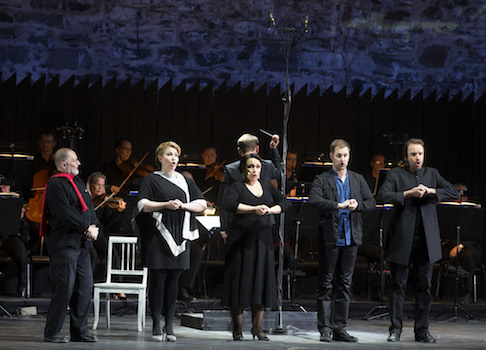 Singers dance to "Salt and malt (The Hop Waltz)"
Singers dance to "Salt and malt (The Hop Waltz)"
In “The dawn of a new age”, Sallinnen infused his score with the flair of Renaissance as the singers reminded the audience that during the castle’s construction, in Italy, Michelangelo, Machiavelli, Leonardo, and Colombus were cultivating humanity out of the Middle Ages. The third part lacked in energy, and felt more historical than musical. The chapters merely described who were in charge, and the momentum of the piece temporarily flatlined. Still informative though!
The finale proved very poetic. We move towards the present. “A message from Elimyssalo” described how the Olavinlinna now sits like an old man on a rock, and time has stopped around him. It was an elegant closing to this compelling journey.
Alternating with the narrator, heavy-handed voice-overs bellowed through the Castle. They did sometimes feel like a tour guide talking us through the history. Still, a tour with Sallinen’s music is far more thrilling than the monotony of a museum guide. The musicians made Olavinlinna's 500 year history come to life.
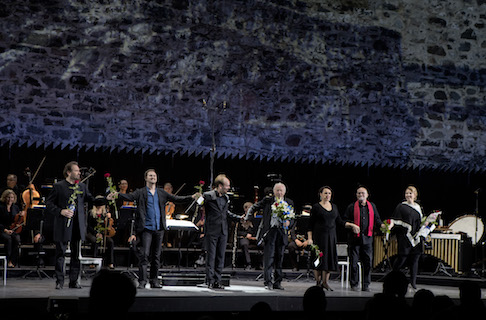 Aulis Sallinen between his performers of Linna vedessä
Aulis Sallinen between his performers of Linna vedessä
With a firm hand in the new composition, Ville Matvejeff conducted the orchestra animated by his passionate Finnish pride. Yet however much engaging, I did not experience Sallinen’s music as a unifying whole, nor recognise themes. Although the four parts together seemed episodic, the chapters within each part flowed from one into another. The music seemed more like a soundtrack to a play. Outside, sporadically the many lokki (gulls) shrieked violently and contributed to Olavinlinna's natural charm.
I was lucky on my first trip to Finland to hear Linna Vedessä. With only two scheduled performances this Summer, it would be a shame if the Castle did not offer this work yearly, in some form or another, so visitors can get this sense of its history through Sallinen's engaging storytelling.
David Pinedo
Cast and production information:
Soprano: Tiina-Maija Koskela; Mezzo-soprano: Tuija Knihtilä; Tenor: Jussi Myllys; Baritone: Tommi Hakala; Narrator: Jukka-Pekka Palo; Savonlinna Opera Festival Orchestra; Conductor: Ville Matvejeff; Production Coordinator: Kari Heiskanen; Olavinlinna Castle, Savonlinna, July 8, 2017
image=http://www.operatoday.com/_I2I7839.jpg
image_description=
product=yes
product_title=Castle in the Water
product_by=A review by David Pinedo
product_id=Above Castle Olavinllina video projection on the stage
All photos by Soila Puurtinen, Itä-Savo
Mozart and Stravinsky in Aix
French theater director Jean-François Sivadier certainly gave it a go with his high, very high concept of Don Giovanni, focusing high-style Brechtian theater conventions onto Mozart’s rich hero. His accomplishment was to take all the fun out of this over-indulged dramma giocosa and let us know that it makes a very significant point that we all are Don Giovanni.
The Brechtian process can easily be imagined (an open stage, people like you and me milling around, the Don among them, the opera begun the 18th century costuming progressively deconstructed into contemporary dress, absolutely abstract [nothing realistic] in its geometric staging, and much use of the half-curtain). The Don himself was a life-force symbol, not a stud (or Tcherniakov’s drunk).
The Commendatore was an authority who was revealed as a buddha once the back wall was partially demolished (noisily a vista of course) and the Christian cross initially hung on the back wall became a “t” as the word liberta was written out. It was not a political statement.
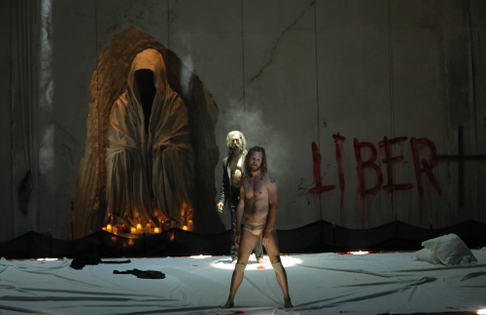 Philippe Sly as Don Giovanni, David Leigh as the Commendatore
Philippe Sly as Don Giovanni, David Leigh as the Commendatore
And finally the Don was delivered to his fate by taking all his clothes off except his briefs which were more or less the discretely placed loin cloth of the Christian crucifixion.
Or something.
As usual the Aix Festival casting was impeccable. Impeccable for this concept. Young Canadian bass-baritone Philippe Sly was the Don. This unique artist projects deep energy and unstoppable force. His youthful physique projected an innocence for the Don of this concept. Wigged with long hair, his final image was absolutely Christ-like.
An announcement was made before the performance that he was ill, but would perform. Perhaps intended, perhaps because of illness Mr. Sly’s Don sometimes crooned, and this voice was indeed effective in his serenade to Elvira’s maid. This was the moment in the performance when the extraordinary communicating power of this young artist was most apparent.
The Don’s servant Leporello was sung by Argentine bass Nahuel di Pierro. Unlike the usual equality of master and servant in Mozart, Mr. di Pierro’s Leporello was indeed a servant, remaining always in the shadow of the Don, both vocally and emotionally. Slovakian tenor Pavol Breslik made the arias of a beautifully voiced Don Ottavio among the high points of the evening.
In harmony with the concept the Commendatore, sung in beautiful, youthful tone by American bass David Leigh, morphed into one of the universal crowd.
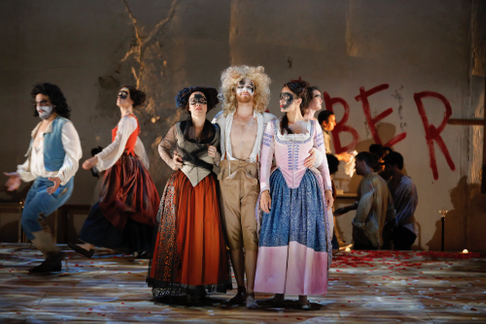 Isabel Leonard as Donna Elvira, Philippe Sly as Don Giovanni, Julie Fuchs as Zerlina, English Voices as the peasants in the Act I finale
Isabel Leonard as Donna Elvira, Philippe Sly as Don Giovanni, Julie Fuchs as Zerlina, English Voices as the peasants in the Act I finale
Stage director Sivadier’s concept rendered the female heroines devoid of personality, though both sopranos brought splendid vocal colors and great virtuosity to their arias. American mezzo-soprano Isabel Leonard initiated her Donna Elvira at New York’s Metropolitan Opera in May, vocally displaying its musical and dramatic richness just now in Aix in very bright, silvery tones. Italian soprano Eleonora Buratto who makes her debut at the Met this fall, sang Donna Anna in a full throated voice of both power and agility. Overheard comments at intermission lamented pitch problems in both voices though I did not notice such issues.
As usual Zerlina and Masetto went through their paces. Director Sivadier presented them with the formidable challenge of singing their duets placed on opposite sides of the stage. French soprano Julie Fuchs sang a much appreciated Zerlina, and Polish bass Krrzystof Baczyk made Masetto into director Sivadier’s sung rather than acted peasant.
All splendid singers they came together wonderfully in the their second act chance encounter finding a gorgeous musical sublimity that we wish for and sometimes get in Mozart operas. Conductor Jérémy Rhorer gave his singers easy tempos, allowing them to show off their voices in the arias and work together in the ensembles. His orchestra, comprised of players on 19th century instruments, made a dark, scratchy sound continuum that compounded the stultifying austerity of the directorial concept. The bright colors on the stage offered little relief.
An American mid-last-century musical institution, Igor Stravinsky was fully immersed in his extreme neo-classicism when he composed The Rake’s Progress (premiere in 1951). In recent years the Aix Festival has focused on Stravinsky, having presented enlightened productions of his pre-American period operatic works — the Peter Sellars production of Oedipus Rex (1927) last year and the Robert Lepage production of Le Rossignol (1914) in 2010.
Thus all stops were pulled for this new production of The Rake’s Progress, entrusted to British theater director Simon McBurney. Mr. McBurney is known to nearby opera audiences for his masterful production of Coeur de Chien in Lyon and his gimmick filled filled ENO production of The Magic Flute in Aix. As for Coeur de Chien McBurney worked with British set designer Michael Levine for this new production, and much the same setting resulted — a white platform and solid white walls. But the walls are really paper walls that at strategic moments are torn through.
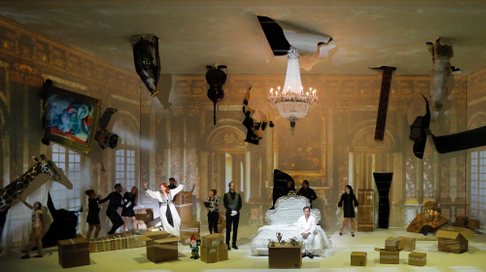 White box set in Act II with projected decor. Baba the Turk's excesses having been thrust through the walls
White box set in Act II with projected decor. Baba the Turk's excesses having been thrust through the walls
For The Rake’s Progress much use was made of projected moving images (video) thus there were very distinct locales quickly created to substitute the eight scenes of the William Hogarth moralistic engravings from 1735 that were Stravinsky’s motivation. This as opposed to the unit set of the famed David Hockney production one fondly recalls.
The production was precisely conducted by Swedish maestro Elvind Gullberg Jensen replacing Daniel Harding who withdrew because of an injured wrist. The careful conducting seemed at odds with, and far away from the energy and brutality of the physical production, i.e. the fast moving images, the bursting of walls and the use of the theater itself as part of the stage.
As well the physical production itself was at calculated odds with McBurney’s actors who were rendered low affect, indeed colorless in contrast to the brilliant coloration of the set and its machinations, and the fantastic apparitions of Mother Goose and Baba the Turk. McBurney announces in his program booklet apology that The Rake’s Progress is a condemnation of braggartly Hollywood where Stravinsky resided with Auden as his guest. Evidently McBurney perceives Stravinsky and Auden, intellectually important, culturally alienated emigrants, as wanting to reveal and illustrate the inherent shallowness of the broader American civilization.
Stravinsky the neo-classicist is not universally admired, the detail and repetitiveness of his compositions in this period verging on the psychotic according to some critical estimations. In The Rake’s Progress one does indeed find the kind of ego destruction that results from such psychosis in both Tom and Ann.
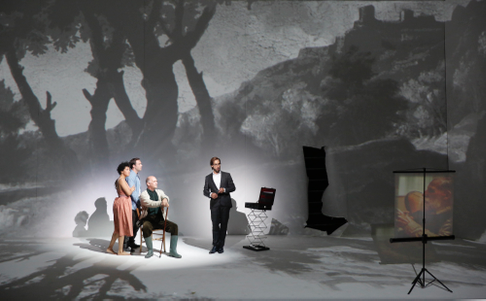 White box set in Act I with Ann, Tom, Trulove and Nick Shadow
White box set in Act I with Ann, Tom, Trulove and Nick Shadow
The Aix Festival casting found American tenor Paul Appleby as a beautifully sung Tom Rakewell, ingenue American soprano Julia Bullock as Ann Trulove, American bass baritone David Pittsinger as her father Trulove. American bass baritone Kyle Ketelsen sculpted Nick Shadow on a level and energy far exceeding that of his compatriots. British counter tenor Andrew Watts rendered Baba the Turk as a brash, caricatured buffo presence that removed this pivotal character from Stravinsky’s neo-classical, distanced and refined world. The same may be said of British contralto Hilary Summers’ performance as Mother Goose.
Michael Milenski
Cast and production information:
Don Giovanni: Philippe Sly; Leporello: Nahuel di Pierro; Donna Anna: Eleonora Buratto; Don Ottavio: Pavol Breslik; Donna Elvira: Isabel Leonard; Zerlina: Julie Fuchs; Masetto: Krzysztof Baczyk; Il Commendatore: David Leigh. Chorus: English Voices; Orchestra: Le Cercle de l’Harmonie. Conductor: Jérémie Rhorer; Mise en scène: Jean-François Sivadier; Décors: Alexandre de Dardel; Costumes: Virginie Gervaise; Lumière: Philippe Berthomé; Wigs and Make-up: Cécile Kretschmar. Théâtre de l’Archevêché, Aix-en-Provence, July 8, 2017.
The Rake’s Progress Anne Trulove: Julia Bullock; Tom Rakewell: Paul Appleby; Nick Shadow: Kyle Ketelsen; Nick Shadow 2 / Le Gardien de l’asile: Evan Hughes; Trulove: David Pittsinger; Mother Goose: Hilary Summers; Baba la Turque: Andrew Watts; Sellem: Alan Oke. Chorus: English Voices; Orchestre de Paris. Conductor: Eivind Gullberg Jensen: Mise en scène: Simon McBurney; Dramaturge: Gerard McBurney; Décors: Michael Levine; Costumes: Christina Cunningham; Lumière: Paul Anderson; Vidéo: Will Duke.Théâtre de l’Archevêché, Aix-en-Provence, July 5, 2017
image=http://www.operatoday.com/Giovanni1_Aix17.png
product=yes
product_title=Don Giovanni and The Rake's Progress at the Aix Festival
product_by=A review by Michael Milenski
product_id=Above: Nahuel di Pierro as Leporello, Philippe Sly as Don Giovanni [All photos by Victor Pascal, courtesy of the Aix Festival]
July 10, 2017
Des Moines: Nothing ‘Little’ About Night Music
When Israel Mizrahi’s set and costume designs debuted at Opera Theatre of Saint Louis a few years back, I opined: “At long last we have been treated to a multi-faceted production that not only equals, but in many ways surpasses the dazzling original.” DMMO’s Blank Performing Arts Centers has a thrust stage configuration similar to St. Louis, and Mr. Mizrahi’s set design proves to be a most congenial fit. The magnificent forest of massive trees is a veritable Shakespearean garden. Positioned upstage of the proscenium, the trees are suitable for climbing, perching, and frolicking. A lush green grassy ground cloth is carried forward onto the thrust front of the pit, dotted with strategic stumps and flowery mounds for additional seating possibilities.
Boris Aronson's original scenic concept was all tracked scenery and cinematic dissolves which informed how the piece developed and was played. Since the DMMO venue afforded no computerized movement capability, director Matthew Ozawa carefully devised a choreographed shifting of necessary furniture, props, and doors. The theatricality of the effect proved to be visually engaging and dramatically fluid. Only twice did we have to wait a bit for the setting to be completed (placing and removing the massive dinner party table for example), but we were compensated with some tasteful instrumental Sondheim variations. The only stationary furniture is a handsome grand piano up left, that is delightfully out of place in this bucolic Eden. Nate Wheatley's magical, sensitive lighting design captured all the intrigue and mystique of a midsummer night when the sun never quite sets.
Mr. Mizrahi (who had also directed in Saint Louis) also bequeathed a stunning array of costumes to Mr. Ozawa. From stuffy straight-jacketed business and formal attire to the suggestive undergarments and accoutrements of half-dressed cast members lounging (and longing) on stage, this was a costume plot by turns gleefully hedonistic and repressively, gorgeously laced up. The whimsical little angel wings attached to the quintet and some servants at once suggested cupids, angels, and fireflies flitting in the perpetual Swedish twilight.
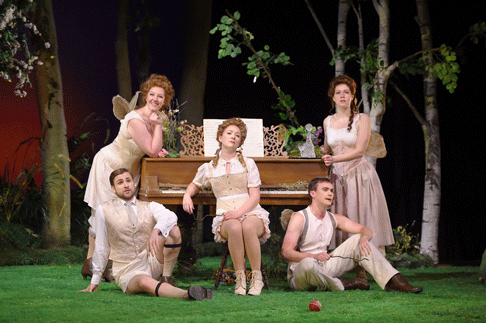 The Liebeslieder Quintet
The Liebeslieder Quintet
Director Ozawa forged a good blend of Swedish directness and an American penchant for sentimentality. Hugh Wheeler’s libretto remains a model of civilized wit, and the direction explored rich subtext, coupled with telling stage business. Inventive blocking made full use of the sprawling playing area, and character relationships were well defined. Initially, I resisted the somewhat stilted, quaint elocution of the spoken lines, declared with operatic resonance to the back wall rather conversing with each other. But I was soon enough won over by the attention to diction and the absolute success in setting up and landing the many laughs.
Fresh from a triumphant star turn the night before as Maria de Buenos Aires, damn if Elise Quagliata didn’t score another knockout performance with her acerbic, self-effacing Countess Charlotte. Ms. Quagliata not only made the long-suffering wife all too human, but she delivered every one of her scripted comedic zingers with laser accuracy. Moreover, Elise sang the part with a vibrant, plush mezzo that was richly sympathetic.
Kelly Kaduce proved to be a predictably beguiling Desiree Armfeldt, largely owing to her being one of opera’s pre-eminent actresses. The role was originally written for the slightly weathered physical beauty and extremely limited vocal means of actress Glynis Johns. Indeed, Ms. Johns decidedly belongs to the Lauren Bacall, whoopee cushion method of tonal production. It is ironic that one of Sondheim’s best-loved songs, Send in the Clowns was specifically crafted to her one octave range and shortness of breath.
Since Ms. Kaduce is not only too youthfully beautiful for the aging actress, and since she sings with a polished, poised soprano, I wondered how she would manage. My fears proved groundless, thanks to Kelly’s knowing (if sparing) injection of an underlying sadness for her life’s routine, and her (and her coaches’) success in finding ways to make the part “sing” that was uniquely hers. I have never heard The Glamorous Life patter actually sung before, albeit up an octave and with delectable operatic flourishes. In short, Kelly Kaduce has added another jewel to her repertoire by making Desiree her own special creation.
As Madame Armfeldt, the venerable mezzo Joyce Castle deployed exquisite diction and evergreen vocalizing to make a mini-drama out of Liaisons. Written for the gravely bass range of character actress Hermoine Gingold, Ms. Castle negotiated the subterranean passages with a firm legato. What’s more, she has the timing of a seasoned comic and drew some of the evening’s biggest laughs with her imperious delivery. Her withering delivery of the word Raisins was perfection.
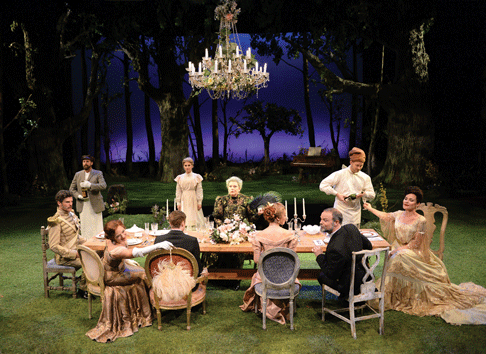 The Dinner Scene
The Dinner Scene
Troy Cook’s assured Fredrik Egerman was marked by a clean, buzzy baritone that was uncommonly supple. The tricky patter of Now was tossed off with consummate ease. Mr. Cook has a sincere delivery, the right look, a wonderful chemistry with Ms. Kaduce, and many sterling artistic attributes. I only wish his resonant declarations sounded a bit more truthful and less operetta-ish.
Lauren Snouffer is a deliciously giddy, virginal Anne Egerman, feigning naivete with convincing results. Ms. Stouffer’s shimmering soprano gleamed above the staff, and her pure sense of line enchanted the ears. Her foil (and eventual lover), Herik Egerman was winningly taken by Quinn Berneger. His pleasing lyric tenor effortlessly suggested the conflicted young man’s duplicitous character, and his enthusiastic ‘cello playing’ did not distract him from offering a firmly sung Later.
Talented local high school student Aviana Gedler proved a real find, as she turned in an assured performance as the young daughter Fredrika Armfeldt. Melanie Long was an especially perky Petra, her sassy sexiness bringing a welcome brazenness to counter the propriety of the other repressed, clandestine philanderers. Her powerful, well-considered version of The Miller’s Son, was securely delivered, even if containing a few wayward sustained pitches. John Graham made the most of his stage time as the horny Frid.
The one principal cast member I had seen in his role before is the assured, distinctive baritone Lee Gregory. Of his Saint Louis Carl-Magnus I wrote: “At first I thought Mr.Gregory's Dudley Do-Right approach might not wear well, but his utter belief in it, and relentless delivery of it ended up being a very satisfying portrayal. Coming off more the stupid prat than usual, the story was the richer for it.” While Lee still sings with gleaming security, I found his take has become more caricatured. With all of the other performers grounded in heightened realism, it seemed that this appealing, talented performer was in another show.
You will likely never hear a finer sung rendition of this score, and much of the glory must be shared by the Liebeslieder Quintet of singers who were splendidly matched, soloing magnificently and blending smoothly as required: Charles H. Eaton (Mr. Lindquist); Chelsea Miller; (Mrs. Nordstrom); Grace Kahl (Mrs. Anderssen); Christian Sanders (Mr. Erlanson); and Stephanie Schoenhofer (Mrs. Segstrom). These attractive, gifted singers from the Apprentice Artist Program present and past, are far too young to sing about "remembering" sexual peccadilloes that are well in the past, but they are most appealing, and sing Sondheim's complex vocal writing with conviction.
In the pit, conductor Eric Melear drew nuanced, colorful playing from the orchestra. I never cease to marvel at Jonathan Tunick's flawless orchestration, the waltz scoring evoking a sinuous Ravelian sweep. Maestro Melear sometimes favored more deliberate tempi, but his collaboration with the singers and his identification with their phrasing was complete.
A Little Night Music has nothing “little” about it, as it adds up to a “lot” of classy entertainment.
James Sohre
Cast and production information: Mr. Lindquist: Charles H. Eaton; Mrs. Nordstrom: Chelsea Miller; Mrs. Anderssen: Grace Kahl; Mr. Erlanson: Christian Sanders; Mrs. Segstrom: Stephanie Schoenhofer; Fredrika Armfeldt: Aviana Gedler; Madame Armfeldt: Joyce Castle; Frid: John Graham; Henrik Egerman: Quinn Berneger; Anne Egerman: Lauren Snouffer; Fredrik Egerman: Troy Cook; Petra: Melanie Long; Desiree Armfeldt: Kelly Kaduce; Malla: Emily Triebold; Bertrand: Zach Rohlwing; Carl-Magnus Malcolm: Lee Gregory; Charlotte Malcolm: Elise Quagliata; Osa: Mary Bricker; Young Prince: Akul Gonchigar; Conductor: Eric Melear; Director: Matthew Ozawa; Set and Costume Design: Isaac Mizrahi; Lighting Design: Nate Wheatley; Make-up and Hair Design: Brittany Crinson for Elsen and Associates; Choreography: Todd Rhoades
image=http://www.operatoday.com/DSC_1928.png
image_description=Troy Cook (Fredrick) and Kelly Kaduce (Desiree) [Photo by Duane Tinkey]
product=yes
product_title=Des Moines: Nothing ‘Little’ About Night Music
product_by=A review by James Sohre
product_id=Above: Troy Cook (Fredrick) and Kelly Kaduce (Desiree)
Photos by Duane Tinkey
Longborough Festival Opera: A World Class Tristan und Isolde in a Barn Shed
Wagner described Tristan und Isolde as a dramatic action rather than an opera. An actor’s director, Carmen Jakobi seemed to have this in mind. With a mostly empty stage and a few geometrical building blocks around which the singers acted, Ms Jakobi emphasized theatrical drama through the aesthetic of Japanese Noh Theater. Set and designer Kimie Nakano’s creations reminded me of Samurai fashion. Her sharp designs suited the elegance unfolding on stage. Ben Ormerod’s exquisite colours in light and shadow highlighted the moonstruck melodrama.
The singers in their acting elevated the experience to the sublime.
During the First Act, Ms. Bisset displayed Isolde’s venomous hatred towards Tristan through fierce acting. Harriet Williams sang Brangäne with a concerned gravitas. As Isolde’s handmaiden and confident, she counterbalanced Ms. Bisset’s raving passions. She even relayed some slightly Sapphic suggestions to the erotic overtones of Wagner’s music.
After Brangäne switched Isolde’s intended poison for Tristan with a love potion, the lovers collapsed on stage, while reaching in a desperate grasp longing for each other. Wedd and Bisset’s chemistry heightened the love between Tristan and Isolde with profound effects.
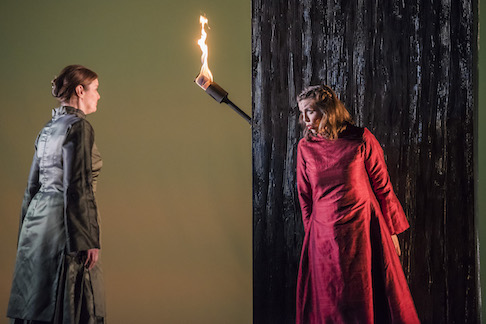 Lee Bisset as Isolde and Harriet Williams as Brangäne
Lee Bisset as Isolde and Harriet Williams as Brangäne
In Act II, the two stars continued to fire up the drama. In their love duet, these two expressive powerhouses erotically charged their chemistry with rapturous kissing and lustful groping. I haven’t seen anything so explicit, yet elegant and authentic, quite like this before in Wagner. I don’t know enough about the man, but based on his highly charged music, I am pretty sure he would have approved of this sexual display.
In the final act with Tristan’s rotting flesh wound inflicted by Melot on full display, Wedd created a terrific momentum. With rip roaring vocal energy, he brought out all the drama in his part. “It’s all about the und in Tristan und Isolde,” I can still hear my college teacher proclaim. As Wedd sung about his love for Isolde, his other half, his und, I finally got what Mr. Stephenson meant: there’s no love without and. Tonight, what used to be a mere academic idea became a passionate memory. I was so struck by my epiphanous recollection, I actually let a laugh escape.
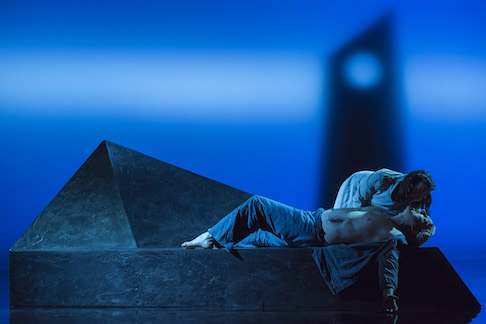 Peter Wedd as Tristan and Lee Bisset as Isolde during the Liebestod
Peter Wedd as Tristan and Lee Bisset as Isolde during the Liebestod
The other actors certainly added to the drama. Stuart Pendred’s Kurwenal offered convincing despair over the dying Tristan. Though his acting conveyed the worry and love for his fraternal companion, Pendred’s voice lacked body. After having been told about Brangäne duplicitous switch, Geoffrey Moses with avuncular conviction frailly vocalised Marke’s compassion for Tristan. Stephen Rooke conveyed Melot effectively: I just wanted Tristan’s nemesis to die.
A protege of Boulez and loyal Bayreuth enthusiast, Negus invigorated Wagner’s magnificent suspense ceaselessly, though not without a few off sounding passages from the orchestra. The Brass unnecessarily relocated above the audience towards the end sounded painfully muffled. However, the extraordinary singing positively inspired the orchestra to great heights. With the strings swelling and contracting, Negus offered dynamic momentum to Wedd and Bisset’s sizzling eroticism.
Ms. Bisset stole my heart as Isolde. I envy the audience who heard her Sieglinde. I checked all Ms. Bisset’s future engagements. For now, one must travel to Britain to witness her talents. With their chemistry conveying true love with such authenticity, I can’t imagine I will soon encounter another coupling quite like Wedd and Bisset.
During the applause, after Isolde’s Liebestod and the music had died off, this modest soprano appeared to be so drained from her performance, so utterly exhausted, it seemed Ms Bisset herself would burst into tears. Based on the flamboyant characters in the audience, this in-crowd appreciated all too well the rustic excellence at Longborough. I cannot wait to have my heart broken again here.
Next year at Longborough Opera Festival, you can experience Wagner’s Der fliegende Holländer.
David Pinedo
Cast and production information:
Tristan: Peter Wedd; Isolde: Lee Bisset; King Marke: Geoffrey Moses; Kurwenal: Stuart Pendred; Brangäne: Harriet Williams; Melot: Stephen Rooke; Sailor/Shepard: Sam Furness; Helmsman: Adam Green; LFO Orchestra; Conductor: Anthony Negus; Director: Carmen Jakobi; Designer: Kimie Nakano; Lighting Designer: Ben Ormerod
image=http://www.operatoday.com/Peter%20Wedd%20%28Tristan%29%2C%20Lee%20Bisset%20%28Isolde%29%20-%20LFO%20Tristan%20und%20Isolde%202017%20cr%20Matthew%20Williams-Ellis%20%2814%29.jpg
product=yes
product_title=Tristan und Isolde
product_by=A review by David Pinedo
product_id=Above: Tristan and Isolde at Longborough [All photos by Matthew WIlliams-Ellis]
July 9, 2017
The Royal Concertgebouw Orchestra throws a glossy Bernstein party
Last Friday’s splendid Bernstein bonanza with the Royal Concertgebouw Orchestra will surely be one of this year’s festival highlights. Besides Bernstein’s soundtrack for the 1954 Marlon Brando movie On the Waterfront, there were extracts from Candide and West Side Story, and solos and duets from the musicals On The Town, Wonderful Town and 1600 Pennsylvania Avenue.
The first fearless bars of “New York, New York”, arranged as a duet for tenor Julian Ovenden and baritone Nadim Naaman, tipped the Amsterdam audience that it was in for an outsized musical theatre experience. One of the top orchestras in the world in bold, swinging mode and a deluxe quartet of entertainers – it’s a formula that could hardly go wrong. But it was conductor John Wilson, straight-backed and outwardly cool, who seamlessly piloted this evening of sass and glamour, repeating a similar success he had at the 2015 BBC Proms with his own band, the John Wilson Orchestra. With laconic gestures he kept rhythms clean and urgent and performed dynamic sorcery. Transformed into a super big band (with five percussionists!), the RCO never upstaged the singers. Scarlett Strallen’s vocally fragile lullaby from Peter Pan, “Dream With Me”, quivered on soft, lush strings. When Julian Ovenden sang an ardent yet intimate “Maria” from West Side Story, the musicians followed his lead, flooding the hall with sound as his shiny tenor opened up, and slinking to a whisper with his final, beautifully sustained piano.
On their own, the RCO turned the obligatory overture to the operetta Candide into a light and sparkly frolic. In the symphonic suite from On the Waterfront Wilson hammered out the climaxes with accurate savagery. The elegiac solo themes rang out with primeval beauty, the horn solo, placed offstage, particularly haunting. Heard live, the piece reveals its debt to the rhythmic structure of Stravinsky’s Rite of Spring, but also Bernstein’s quintessentially American originality. The orchestra visibly enjoyed the lively musical numbers. When it was their turn to play “The Dance At the Gym” from West Side Story several orchestra members rocked uninhibitedly to the infectious mambo and cha-cha beats. Every deserving musical score should get such a 24-carat orchestral treatment once in a while. The vocal performances, varied in mood and style, were just as exhilarating. Nadim Naaman sang “Lonely Town” with winning melancholy. After her tentative lullaby, Scarlett Strallen was absolutely charming in “A Little Bit In Love”. Her showpiece, “Glitter and Be Gay”, was a brilliant send-up of an operatic aria. She exaggerated coloratura notes with glottal chugs and crashed downward scales hilariously into a guttural chest register. Glittering of gown and voice, she securely pinned all the high C’s, D’s and E flats and earned herself a huge applause.
Contrasting with Strallen’s diamond-point vocalism, Kim Criswell lent her turbine-driven voice and huge personality to a gallery of feisty women. As touching as she was in the ballad “Take Care of This House”, from Bernstein’s last composition for Broadway (and famous flop), 1600 Pennsylvania Avenue, it was her pizzazz in assertive, jazzy numbers that set the stage on fire. Both taxi driver Hildy’s imperative seduction catalogue “I Can Cook Too” and writer Ruth’s sardonic “One Hundred Easy Ways To Lose A Man” were irresistibly vivid. With unerring phrasing and a chameleon-like persona Criswell draws characters so rich that she makes you forget you’re listening to musical numbers out of context. From the robust top notes to the chocolate bourbon chest voice, her instrument is a dazzling vocal carousel. Her shifts though the various musical idioms – jazz, musical, operetta – seemed effortless. An intuitive comic, she sang the Old Lady’s Tango from Candide with a hyperbolic Spanish accent and full, throbbing tone. In “Island Magic” from the opera Trouble in Tahiti Criswell’s arms were as eloquent as her voice as they traced Dinah’s mockery of, and submission to, escapist silver screen entertainment. Supported by the other soloists as the trio, she was utterly magnetic, painting the scenography with her hands and swaying to her mighty Polynesian vocalise.
Criswell and Strallen ended the official program with a bouncy “Wrong Note Rag”, but the delighted audience naturally wanted more. They got two encores, the philosophical resignation quartet “Some Other Time” from On The Town and the “Tonight” quintet from West Side Story as a quartet. “Anita’s gonna get her kicks tonight”, sang Criswell. And she was not the only one who got them.
Jenny Camilleri
Performance information:
Kim Criswell, soprano; Scarlett Strallen, soprano; Julian Ovenden, tenor; Nadim Naaman, baritone. Royal Concertgebouw Orchestra. Conductor: John Wilson. Heard at the Concertgebouw, Amsterdam, Friday, 7th July 2017.
image=http://www.operatoday.com/Bernstein.png image_description=Leonard Bernstein product=yes product_title=The Royal Concertgebouw Orchestra throws a glossy Bernstein party product_by=A review by Jenny Camilleri product_id=Above: Leonard BernsteinDie Frau ohne Schatten at Munich
First, and perhaps most important: both received outstanding performances, fully worthy of any festival in the world, let alone one such as this which offers both new productions and stagings from the repertory. This FroSch may have been the latter, but who would have known? There are clearly advantages to being conducted by the Music Director — not least the identity of this particular music director — but even so…
Both works offered the director considerable challenges. In the Schreker opera, Warlikowski rose admirably to the challenge of drawing out what was of greatest interest in a flawed work and, indeed, even to criticising certain of its more problematical aspects. Die Frau ohne Schatten is not without its problematical aspects either, of course, not least Hofmannsthal’s bizarre pronatalism — perhaps a staging that made more of its wartime origins might help, but I have yet to see one — and, more broadly, the mismatch between Strauss and Hofmannsthal here. If Strauss misunderstands Hofmannsthal, though — and we should be wary of awarding priority simply on a chronological basis, especially with so complex a composer-librettist relationship as this — it is, to borrow a term from Webern and the post-war avant garde, a productive misreading.
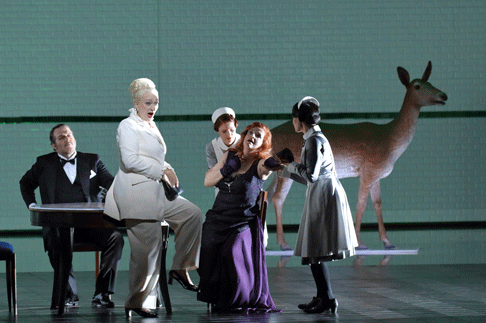 Sebastian Holecek (Der Geisterbote), Michaela Schuster (Die Amme), Ricarda Merbeth (Die Kaiserin), Statisterie der Bayerischen Staatsoper
Sebastian Holecek (Der Geisterbote), Michaela Schuster (Die Amme), Ricarda Merbeth (Die Kaiserin), Statisterie der Bayerischen Staatsoper
How does Warlikowski deal with that, in a production first seen in 2013? I am not entirely sure that he does, but it may well be that I am missing something. What he certainly does accomplish is to present a number of standpoints, which may, to an extent, like those presented in the work ‘itself’, be reconciled, or even set against each other. The world of medicalised hysteria, of the sanatorium is present, just as in Claus Guth’s production (seen at La Scala, Covent Garden, and the Berlin State Opera). Perhaps counter-intuitively, for a work in which, laboriously at times, Hofmannsthal at least seems to offer layer upon layer of symbolism, often highly referential or at least allusive, Warlikowski penetrates to a very human drama at the work’s heart. It might sound banal; perhaps in some ways it is; but why not actually present this as a drama concerning a woman, the Dyer’s Wife rather than the Empress, who wishes to have children, is pressured to renounce her desire, and then achieves what would seem to be genuine fulfilment by doing so? There are various answers to that, of course, or at least to why such a drama might be problematical; but they are not unanswerable answers.
Freud hangs less heavily over the production than he does over Guth’s, but he is there, glimpsed indeed in video projections at the end alongside a motley crew that includes (I think) Gandhi, Christ, the Buddha, King Kong, and Marilyn Monroe. (I have no idea, I am afraid; I suspect I am missing something terribly obvious, but never mind…) More overtly present is Last Year in Marienbad. Pictures from the film lead us in to the opening of the opera and accompany its course, far from obtrusively, yet offering connections should we wish to follow them. A sadness born of lack of fulfilment, perceived or otherwise, hangs over what we see — and interacts, sometimes harmoniously, sometimes less so, with what we hear. Even the Nurse seems a far more human figure than usual. There is, perhaps, loss there too, but to see her a broken woman, trying to deal with an impossible situation that is not of her choosing is fascinating: it certainly made me reconsider the role.
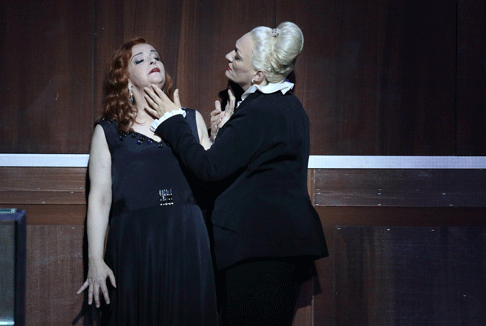 Ricarda Merbeth (Die Kaiserin), Michaela Schuster (Die Amme)
Ricarda Merbeth (Die Kaiserin), Michaela Schuster (Die Amme)
Where Ingo Metzmacher had given a commanding account of Schreker’s score the previous night, Kirill Petrenko went further still in Strauss’s score. It does no harm, of course, that Strauss is by far the greater composer and musical dramatist. But that can come to naught, or at least be severely diminished in the wrong hands. Musical performance is certainly not a matter of league tables, but I can certainly say, hand on heart, that I have never heard the opera better conducted or played. This was at the very least a musical performance to set alongside those by Christoph von Dohnányi and Semyon Bychkov at Covent Garden, and superior to any of the others I have heard. Petrenko’s ear for Strauss’s complex orchestral polyphony is second to none, not only amongst any conductor alive but any I know from recorded performances.
The similarities and differences between Strauss and Schoenberg — you will have to forgive me for having the latter very much on my mind at the moment — are as complex as their music ‘in itself’. There is, though, something here which, ironically, given Strauss’s reported remarks on Schoenberg’s score, brings Strauss closer than one might expect to the Five Orchestral Pieces, op.16. Alma Mahler just could not help herself in telling Schoenberg that Strauss had said Schoenberg would be ‘better off shovelling snow’ than ‘scribbling on manuscript paper’. (What is less often reported is that he recommended the younger composer for the Mahler Foundation grant in any case. Schoenberg, unsurprisingly, never forgave him; when asked the following year for a fiftieth-birthday tribute, he responded angrily: ‘He is no longer of the slightest artistic interest to me, and whatever I may once have learned from him, may God be thanked, [I had] misunderstood.’) Petrenko is a very fine Schoenberg conductor; indeed, it was in Erwartung at Covent Garden that I first heard him. The interplay between colour, line, harmony, every changing parameter was such that I could not help but think I was hearing Strauss with somewhat Schoenbergian ears — and that was not entirely to be attributed to my own present preoccupations. The Bavarian State Orchestra was at least equally responsible: in every respect worthy of the most exalted comparisons, past or present. I do not think I have ever heard the solo cello part played with greater tenderness and yet with such a sense of where, motivically and harmonically, it is heading. Nor have I heard the full orchestra sound more thrillingly present and yet more transparent. It was not only seeing the glass harmonica in one of the boxes overlooking the pit that meant I could hear it so well.
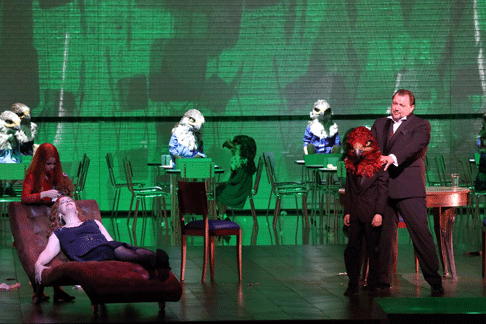 Ricarda Merbeth (Die Kaiserin), Burkhard Fritz (Der Kaiser), Kinderstatisterie der Bayerischen Staatsoper
Ricarda Merbeth (Die Kaiserin), Burkhard Fritz (Der Kaiser), Kinderstatisterie der Bayerischen Staatsoper
Vocal performances were almost equally magnificent. Burkhard Fritz greatly impressed in Berlin earlier this year, and did so again here: quite tireless and perfectly capable of riding Strauss’s orchestral wave. The Emperor is, perhaps, the best role in which I have heard of him. Ricarda Merbeth was more than his equal as his consort: as tenderly moving as, when required, imperious. She truly drew one into her particular drama, as did the Dyer and his Wife, even, as mentioned above, the Nurse. Elena Pankratova and Wolfgang Koch were also in previous casts I had seen, London and Berlin respectively. Fine though their performances had been then, Petrenko’s conducting seemed to incite them to still greater things in Munich. (The more I consider Zubin Mehta in Berlin, the more uncomprehending his conducting seems by comparison.) Theirs was at root a human, commonplace relationship, exalted by particular musico-dramatic circumstance and by musical performance into something transformative, in a sense that both Strauss and Hofmannsthal might have acknowledged. The sadness both felt could be perceived in their faces, their body language, but still more in the alchemy of stage, words, and music that is opera at its greatest — and which, with the best will in the world, a lesser composer such as Schreker could never have summoned. To her trademark malevolence in the role, Michael Schuster was here fully enabled to offer a poignancy one rarely sees and hears in the Nurse. Sebastian Heleck’s Spirit Messenger was perhaps first among equals — intelligent, deeply musical singing — amongst the ‘smaller’ roles, but there was no weak link here. Choral singing and acting were equally outstanding. Likewise those roles played by non-singing actors: the Apparition of a Youth here our first among equals, sporting an excellent line in gigolo contempt when collecting his earnings for unachieved attempted seduction from the Nurse. As had been the case in the previous night’s performance, the dramatic whole was greater than the sum of its parts — just not quite in the same way. Now how about a Moses und Aron
Mark Berry
Cast and production information:
Nurse: Michaela Schuster; Spirit Messenger: Sebastian Holececk; Emperor: Burkhard Fritz; Empress: Ricarda Merbeth; Voice of the Falcon, Guardian of the Threshold of the Temple: Elsa Benoit; The One-Eyed: Tim Kuypers; The One-Armed: Christian Rieger; The Hunchback, Apparition of a Youth: Dean Power; Dyer’s Wife: Elena Pankratova; Barak: Wolfgang Koch; Serving Maids: Elsa Benoit, Paula Iancic, Rachael Wilson; Voices of Unborn Children: Elsa Benoit, Paula Iancic, Alla El-Khashem, Rachael Wilson, Okka von der Damerau; Voices of Night-Watchmen: Johannes Kammler, Sean Michael Plumb, Milan Siljanov. Director: Krzysztof Warlikowski; Designs: Malgorzata Szczęśniak; Lighting: Felice Ross; Video: Denis Guéguin; Video Animation: Kamil Polak; Abendspielleitung: Georgine Balk; Dramaturge: Miron Hakenbeck; Children’s Chorus (chorus master: Stellario Fagone) and Chorus (chorus master: Sören Eckhoff) of the Bavarian State Opera/Bavarian State Opera/Kirill Petrenko (conductor). Nationaltheater, Munich, Wednesday 5 July 2017.
image=http://www.operatoday.com/P_O_Die_Frau_ohne_Schatten_09.png image_description=Elena Pankratova (Färberin), Statisterie der Bayerischen Staatsoper [Photo © Wilfried Hösl] product=yes product_title=Die Frau ohne Schatten at Munich product_by=A review by Mark Berry product_id=Above: Elena Pankratova (Färberin), Statisterie der Bayerischen StaatsoperPhotos © Wilfried Hösl
A Resplendent Régine Crespin in Tosca
Both of these reasons apply to the recording here, from a performance at Covent Garden on May 18, 1961. We get to hear Régine Crespin singing a role that she never recorded commercially, and at the peak of her vocal voluptuousness and steadiness. She was Mme. Lidoine (the new Prioress) in the first recording of Poulenc's Dialogues of the Carmelites (1958). In the early 1960s she made a still-classic recording of Berlioz's Les Nuits d'été and Ravel's Shéhérazade and contributed a magnificent Sieglinde to the Solti/Culshaw Ring Cycle.
What we get here is, as we had reason to hope, an immensely artful blending of vocal plenitude, nuanced phrasing and dynamics, and alert moment-to-moment clarity of characterization. Crespin now leaps to the top of recorded Floria Toscas, next to my, and many people's, two favorites: Maria Callas (the mono recording, conducted by De Sabata) and Leontyne Price (two great recordings: with Karajan and with Mehta).
The Cavaradossi, Giuseppe Di Stefano, sounds very involved in certain solo moments but distracted or routine in interaction with other characters. The voice is wonderfully sweet at times, but it can become tight—almost like a comical “character tenor” (e.g., the landlord Benoît in La Bohème)—when it has to contend with a full orchestra.
Much more convincing is the Scarpia of Czech-born Otakar Kraus. The voice is well controlled and used to good dramatic point. Kraus's burly singing over the chorus and orchestra at the end of Act 1 is stunning and scary, and the singer shows his ability to be manipulatively lyrical in his negotiation with the diva in Act 2. This Kraus (not to be confused with tenor Alfredo) recorded very little. He is not so much as mentioned in the Metropolitan Opera Guide to Recorded Opera. He sang the roles of Nick Shadow in the first production of The Rake's Progress and of Tarquinius in the first Rape of Lucretia. That first (live) Rake is available on CD, but reportedly the performance as a whole is somewhat helter-skelter and the sound quality pale. Is there more Otakar Kraus in the archives and decently recorded?
The conducting is first-rate: brisk but always ready to bend to make a point. The Covent Garden orchestra is ultra-responsive, with only a few momentary slips in intonation. The clarinet introduction to “E lucevan le stelle” is done in the modern international manner: vibrato-free and eloquent. The conductor, by the way, is not the Edward O. D. Downes who used to host the Metropolitan Opera Quiz. This Edward Downes was English-born and renowned as a Verdi conductor; he rose to become Associate Music Director of Covent Garden and Principal Conductor of the BBC Philharmonic.
The booklet contains only a tracklist and an apology for imperfections in the original tapes. My ears found nothing to complain of, beyond the predictable limitations in a mono recording of a complex opera. Indeed, offstage sound effects generally register well and in good balance with the onstage singing and the playing from the pit. My one complaint: very soft singing is occasionally covered by the orchestra.
Perhaps several mikes were used and artfully mixed at the moment of recording? Was this performance originally broadcast on the radio? I wish that certain record companies would reveal a little more about the origins of their archival releases. YouTube has a recording of the same opera made four years later with the same soprano and tenor, but with a marvelous Giuseppe Taddei as Scarpia (though a bit weak on the low end), from the Teatro Colón in Buenos Aires, under Bruno Bartoletti.
Crespin still sounds vital and detailed; Di Stefano’s voice is in further decline. The winds are often out of tune with each other, and the recording lacks the opening minutes. YouTube also has several recordings of Crespin singing “Vissi d’arte” (including a made-for-TV video), and a video in which Crespin enjoys retelling (in French) two different mishaps in the scene in Act 2 where she needs to grab a knife and murder Scarpia.Ralph P. Locke
Ralph P. Locke is emeritus professor of musicology at the University of Rochester’s Eastman School of Music. He has written extensively on opera and symphonic music and on the relationships between music and society. His most recent two books are Musical Exoticism: Images and Reflections and Music and the Exotic from the Renaissance to Mozart (both Cambridge University Press).
The above review is a lightly revised version of one that first appeared in American Record Guide and appears here by kind permission.
image=http://www.operatoday.com/Tosca_Crespin.png image_description=Myto 00311 product=yes product_title= product_by=Régine Crespin (Tosca), Giuseppe di Stefano (Cavaradossi), Otakar Kraus (Scarpia), Forbes Robinson (Sacristan); David Kelly (Angelotti), David Tree (Spoletta), Victor Godfrey (Sciarrone, jailer), John Pyle (shepherd). Orchestra and Chorus of the Royal Opera House Covent Garden, conducted by Edward Downes. product_id=Myto 00311 [2CDs] price=€ 12.99 product_url=https://www.jpc.de/jpcng/classic/detail/-/art/Giacomo-Puccini-1858-1924-Tosca/hnum/2793389
July 8, 2017
Karine Deshayes’s Astonishing New Rossini Recording
I can now join him and complain about the same thing—in this case in a Rossini album, on the Aparte label, presenting the remarkable young mezzo-soprano Karine Deshayes.
Alternating vocal and instrumental pieces makes sense in a long concert, but less so in a CD for one’s library. Here we get two orchestral numbers, and they are ones that don’t stand very well on their own, namely the storm interludes from two Rossini operas: Il barbiere di Siviglia and La Cenerentola. How often would you want to listen to, say, the storm from Beethoven’s “Pastoral” Symphony out of context? The conductor states, in the booklet essay, that he was trying to give the whole CD a dramatic arc. This was lost on me.
Still, it’s churlish to complain about such things if the repertoire is interesting and the performances are accomplished and persuasive. That is certainly the case on this recording, which will be many people’s first introduction to the mesmerizing Deshayes. I first encountered her voice and artistry on the world-premiere recording of Félicien David’s grand opera Herculanum. In my review of that recording, I called her performance of the role of the pagan queen Olympia “at once commanding and subtle, quite an achievement.” She can also be heard on two other recent CDs: one consisting of pieces by Karol Beffa; the other entitled Après un rêve, with the Ensemble Contraste.
Deshayes is a mezzo of the modern kind, which is to say light and clean, with a quick, tight vibrato, splendid breath control, and marvelously fleet coloratura. She is perfect for the many Rossini roles that were written for mezzo—roles sung, just a few decades ago, by Marilyn Horne and Cecilia Bartoli. Deshayes has her own vocal personality: her low notes do not bloom as Horne’s did, and she rarely bites into the words as Bartoli does. Instead, she focuses on etching the vocal line with all the nuances of a great instrumentalist. (Perhaps some of her musicality derives from her early training as a violinist.) We are treated to innumerable subtle shadings in dynamics, including many ear-ravishing instances of a sudden diminuendo on a single note, such as one more often encounters in recordings of Baroque music. Deshayes never seems unaware of the emotions behind a given passage. It’s just that she tends not to sacrifice vocal beauty in order to drive a verbal message home. Her frequent embellishments are appropriate to the context, gently surprising but never distracting, and performed with keen rhythmic variety.
The tempos set by conductor Raphaël Merlin are generally brisk and always apt, with natural-sounding adjustments at major structural junctures. The orchestra, Les Forces Majeures, is here making its disc debut. Les Forces Majeures seems to be active mainly in the summers, at festivals. It consists of players who—according to the booklet—are members of professional string quartets or other chamber groups, or play in French orchestras, or have recently finished their musical training. (Merlin is best known as the cellist in the award-winning Quatuor Ebène.) As for the orchestra’s name: force majeure means a situation that was unavoidable and overturns all plans and promises; or, more generally, an irresistible trend. The phrase can at times be roughly equivalent to “an act of God.” Here it is made plural, creating a play on words because the orchestra consists of various groups—i.e., performing forces, including those string quartets—that combine to form a single unified ensemble that makes a major impact. The musicians presumably play modern instruments. Gratifyingly, it sounds as if the timpanist is using hard sticks rather than the big spongy ones that would be appropriate to later repertoire.
There is one problem: the acoustics. The recording was made in a repurposed stone-walled granary in Villefavard (near Limoges), which now serves as a concert venue. A photo of the raked seating that has been installed at one end of the space suggests that no more than 400 listeners can be accommodated. Presumably because the hall is small and the surfaces are non-absorbent, the microphones pick up a quick, loud echo, especially on high notes (whether from the singer or from the brass and winds). I sometimes have trouble hearing notes that the singer touches lightly (e.g., in a downward run) after she has emitted a clarion high note that continues to ring, and I often have trouble hearing what harmonies the strings are playing quietly under the singer or under wind passages. Since the music-making here is on such a high level, I hope that the engineers, in future recordings, temper the hall’s acoustics, perhaps by more careful microphone placement or by placing absorbent cones in the seats to simulate the effect of an audience.
The repertory is a mix of familiar and not. We get to hear the most famous soprano or mezzo arias from Il barbiere di Siviglia (two: “Una voce” and “Contro un cor”), Cenerentola, Semiramide, and Otello, plus a second, shorter, excerpt from the latter opera and a wonderful multi-movement aria from La donna del lago, which can be heard by clicking here. There are also three Rossini songs, orchestrated by the conductor in a colorful manner. Indeed, too colorful at times: the numerous instrumental intrusions in L’âme délaissée are distracting, even at times soupy. The Spanish touches added to Nizza, though played with great flair, seem excessive. The poet who wrote Nizza, by the way, is not identified in the booklet: it’s Emile Deschamps. The performance of Nizza omits Deschamps’s wittily worded second strophe, which Rossini certainly intended to be sung, as one can see in the early edition available online at IMSLP.org.
I particularly object to the way that Merlin has updated the Canzonetta spagnuola to make it seem like a direct model for the Gypsy Song in Bizet’s Carmen. Merlin, clearly following Bizet’s lead, makes the orchestration progressively more elaborate in each of the three strophes and gradually speeds the tempo up. Rossini’s score (for, of course, voice and piano) simply gives the music once, with repeat signs and the three sets of words.
More appropriate to the aesthetics and style of Rossini’s music is the orchestration used here for the cantata Giovanna d’Arco (i.e., Joan of Arc). It was made in 1989 by renowned Rossini scholar Philip Gossett for a performance by Teresa Berganza and is based on Salvatore Sciarrino’s edition of Rossini’s original version (for voice and piano). It may be that the orchestral version is here receiving its first recording. Though the publisher (Ricordi) has labeled it an elaborazione (on the title page), I found it very persuasive and not—as that word might suggest—over-done.
I will be listening to this CD many times in the future, if not often to its two interpolated storms. And I look forward to the future projects of this remarkable young mezzo and equally remarkable new chamber orchestra—separately or together. A video with captivating excerpts from the recording sessions is at https://www.youtube.com/watch?v=jpAo06q2x4I.
Ralph P. Locke
The above review is a lightly revised version of one that first appeared in American Record Guide and appears here by kind permission.
Ralph P. Locke is emeritus professor of musicology at the University of Rochester’s Eastman School of Music. His most recent two books are Musical Exoticism: Images and Reflections and Music and the Exotic from the Renaissance to Mozart (both Cambridge University Press).
image=http://www.operatoday.com/Karine_Deshayes_Rossini.png image_description=Karine Deshayes — Rossini product=yes product_title=Karine Deshayes — Rossini product_by=Karine Deshayes, mezzo-soprano, Les Forces Majeures, conducted by Raphaël Merlin. product_id=Aparte AP121 [CD] price=$20.99 product_url=http://www.arkivmusic.com/classical/Drilldown?name_id1=111189&name_role1=2&bcorder=2&name_id=10388&name_role=1
Knappertsbusch’s Only Recording of Lohengrin Released for the First Time
It was thus with some excitement that I opened a new 3-CD set from Orfeo, consisting of the first release ever of any performance of Lohengrin conducted by the conductor sometimes known among musicians and operagoers as “Kna.”
There are many things to admire in the recording, as one might expect from a live recording made in a major opera house, namely the Bavarian State Opera’s theater on the Prinzregentenstrasse. The performance took place on 2 September 1963. The occasion was a notable one: the 59th and final performance of Lohengrin before the theater closed for renovations. That same year, the Nationaltheater—which had been largely destroyed in an air raid in 1943—reopened. From that time onward, it has served as Munich’s main opera house. The Prinzregentenstrasse theater—with its relatively intimate size: 1112 seats—would not be put back into service until 1988. It is often used for spoken plays and dance performances.
The production was a long-admired one, by Rudolf Hartmann. First seen in 1954, it hewed a middleground between the detailed, quasi-realistic stagings that had long been traditional for Wagner's operas and the highly abstract, concept-driven renderings that Wieland Wagner was, around then, introducing in Bayreuth and elsewhere.
We of course are left here only with the recorded sound of the production, and of one particular performance, to respond to. Unfortunately, the sonics vary greatly. Whereas selected Bayreuth productions were recorded professionally for broadcast and then released commercially--and whereas those Bayreuth recordings used stereo as early as the mid-1950s--this one is in mono and seems to have been made for archival purposes only. (The tapes were apparently found years later in the papers of the opera company's general director.) I would guess that a single microphone was used throughout, in a fixed position in front of the stage, causing predictable problems in such a complex work.
The conducting, not surprisingly, is in capable hands. (One can get a quick sense of Knappertsbusch’s stylistic mastery, and occasional lack of discipline, from the excerpts from the present recording that can be heard on YouTube: the Prelude to Act 1 and the end of Act 2, with its choral peroration immediately countered by the motive of the promise that Lohengrin has wrung out of Elsa.) The singers all sound like they know what they are singing about, no surprise as they are mostly native German-speakers or, in two cases, Scandinavians. The singing—in the strict sense of vocal production, rather than interpretation—and the quality of the orchestral playing vary more, as of course is often the case in live recordings of highly demanding operas.
Ingrid Bjoner, from Norway, makes generally beautiful sounds as Elsa, and also develops appropriate toughness in her confrontations with the nasty Ortrud. Astrid Varnay, a Swede, sings Ortrud in commanding manner. She offers a splendid scene here in Act 2 with Hans-Guenter Noecker (as Telramund). Their voices are similarly tough in quality, and they even handle sneering portamentos in much the same way. These two villains clearly deserve each other.
In the title role, Hans Hopf is not as secure as Jess Thomas (on Kempe’s famous studio recording) nor as wonderfully vivid as Sandor Konya (on Leinsdorf’s). He sounds metronomic at times, as if he is reading the score in his head. This is most unfortunate in the intimate love duet with Elsa in Act 3. Kurt Boehme is occasionally a bit unsteady as the king but enunciates admirably. Metternich is a first-rate herald. The chorus sings in a resonant, slightly messy opera-house manner. Their shifting moods “tell”: one senses, as one rarely does in opera recordings (whether recorded in a studio or during a performance), a group of real people responding plausibly to one or another event on stage.
Occasionally a solo singer is somewhat far from the microphone, or goes flat, or both. Hopf is flat for long stretches. The chorus, as a whole, tends to keep pitch with the orchestra, but sometimes the individual members or sections are not perfectly tuned with each other. The winds and brass, too, do not always tune their chords tightly. Some stretches of solo singing are afflicted with a quick echo. I think this happens when a singer was far from the microphone, and the engineer (then or for the rerelease) raised the volume level and, in the process, picked up each note a second time, after the sound bounced back from the auditorium walls. The CD firm (the often admirable Orfeo) should have put some kind of explanation in the booklet and a warning on the outside.
The informative booklet—excellently translated by Chris Walton—stresses that this is the first time any Knappertsbusch recording of Lohengrin has been released to the public. I have long heard complaints about Knappertsbusch’s fondness for slow tempos, but the tempos here are actually similar to those on the Kempe recording, and Knappertsbusch is just as ready as Kempe to adjust the pace to make a dramatic or musical point. Nothing ever sounds stodgy or inert. The recording would have been only a few minutes longer than Kempe’s except for the fact that Knappertsbusch makes a substantial cut in Act 3 that was traditional in many opera houses (though not at Bayreuth). The cut begins when Elsa faints after Lohengrin reveals his name and ends just before the chorus's cry "Der Schwan! Der Schwan!"
I can recommend the recording for its authentic feel—especially if you enjoy, as I do, hearing portamentos not just in the voices but also in the strings—and for its feeling of “You are there.” Still, some of those same virtues are to be found, and in much better sound, in two much-praised Bayreuth recordings that likewise have Varnay as the Ortrud: those conducted by Keilberth (1953) and, in stereo, by Sawallisch (1962). If you are happier with studio recordings, the longstanding recommendation from most critics remains the one conducted by Rudolf Kempe (1962-63), with a superb cast and in sound that holds up beautifully after more than half a century.
One ironic plus: this new release (from 1963) gave me occasion to sample the Kempe for comparison. Many details emerge on that famous studio recording with greater clarity, and the work seems to move more quickly because we hear so much more specificity and variety from moment to moment. Christa Ludwig and Dietrich Fischer-Dieskau bring fascinating nuances to the Ortrud/Telramund duet in Act 2 that are nowhere to be found in the admirable but relatively straightforward reading here by Varnay and Noecker. When I listen to this new release, the year 1963 seems awfully long ago. In Kempe's recording, 1963 seems like just yesterday.
The Knappertsbusch set lacks a libretto. The 2010 rerelease of the Kempe contains the libretto on a fourth CD. The libretto is also available online here.
Ralph P. Locke
Ralph P. Locke is emeritus professor of musicology at the University of Rochester’s Eastman School of Music. He has written extensively on opera and symphonic music and on the relationships between music and society. The above review is a lightly revised version of one that first appeared in American Record Guide, and appears here by kind permission.
image=http://www.operatoday.com/Lohengrin_Knappertsbusch.png image_description=Richard Wagner: Lohengrin (Orfeo C900153D) product=yes product_title=Richard Wagner: Lohengrin product_by=Ingrid Bjoner (Elsa), Astrid Varnay (Ortrud), Hans Hopf (Lohengrin), Hans-Guenter Noecker (Telramund), Josef Metternich (Herald), Kurt Boehme (King Heinrich). Bavarian State Opera Chorus and Orchestra/ Hans Knappertsbusch. product_id=Orfeo C900153D [3CDs] price=$54.99 product_url=http://www.arkivmusic.com/classical/album.jsp?album_id=2169081
Dulwich Opera’s Carmen
Despite being in a functioning school hall in south London, with a minimal set, dodgy lighting, and done on the proverbial shoe-string, it still managed to transport us into a languid, sun-soaked Mediterranean. Added to which Phillipa Thomas is the best Carmen I’ve seen since Maria Ewing in the Peter Hall production at Glyndebourne in the ‘80’s. While Ewing had a breath-taking stillness about her, Thomas brings an innocence to the role.
In his programme notes the director Ptolemy Christie writes that the original Carmen in Prosper Merimee’s book was ‘vicious, intoxicating, ruthless, double-crossing and dark. She’s bad news. In the opera she is also vicious and of course intoxicating but she is also a creature of humour and light.’ Phillipa Thomas came onto the stage with a huge, slightly naughty smile on her face — she was going to enjoy herself, and who can blame her when she’s nailed this role so well, and evidently has a good time singing it (even with an announced but imperceptible cold). She allows the role to develop, initially a curious pretty alley cat at her first meeting with Don Jose when she throws him the flower — she knows she fancies him and wants to play with him. She allows her character to unravel and when her smuggling mates go off to the mountains, her happiness at being in love with Don Jose is genuine. Even in the final act when she’s trying to get past Don Jose, the music is uncertain and although her heart is hardened against him, Carmen mirrors this, at the same time showing that’s she’s moved on. This Carmen doesn’t shake her booty but celebrates it. She has no inhibitions on stage, she’s a stage animal and she inhabits her role — one to keep a sharp eye on.
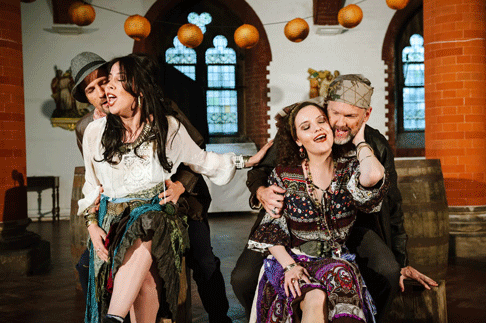 Caspar James (Le Dancaïre), Claudia Haussmann (Frasquita) Urszula Bock (Mercedes), Jeremy Vinogradov (Le Remendado)
Caspar James (Le Dancaïre), Claudia Haussmann (Frasquita) Urszula Bock (Mercedes), Jeremy Vinogradov (Le Remendado)
This luxury Carmen casting wouldn’t have worked had it not been for the production around her which used what they didn’t have to their advantage; at the beginning of Act 11, Frasquita and Mercedes gathered round the upright piano in the Lillas Pastia Bar giving a seedy image, and in the mountain scene, the cards were clearly visible when Carmen sees death in them. Christie also got round the crown scene outside the bullring in Act 4 without a crowd. He placed the focus solely on Carmen and Escamillo, the extent of their love and put them in gorgeous eye-pleasing costumes. This in turn made Don Jose’s entrance and the last scene more menacing and powerful. Christie also injected energy into the production and cast; Carmen as a piece is an onslaught of emotions and this cast didn’t shy away from that — they were believable. James Hutching’s Don Jose looks like a young boy and plays the role with acute vulnerability - his Flower Song was real tear jerker. He coped well vocally although this role is a big sing for him. Loretta Hopkins looked like a mixture between a NHS nurse and a milkmaid, a good combination for Micaela while David Fletcher was an aptly oily Escamillo, but vocally this isn’t his role. Credit should go to the rest of the cast for their energetic back-up.
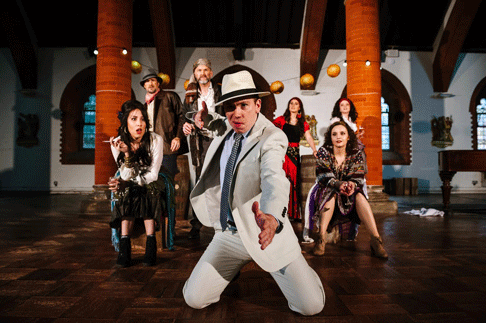 Claudia Haussmann (Frasquita), Caspar James (Le Dancaïre), Jeremy Vinogradov (Le Remendado), David Fletcher (Escamillo), Phillipa Thomas (Carmen), Urszula Bock (Mercedes)
Claudia Haussmann (Frasquita), Caspar James (Le Dancaïre), Jeremy Vinogradov (Le Remendado), David Fletcher (Escamillo), Phillipa Thomas (Carmen), Urszula Bock (Mercedes)
The sight of a little black upright piano for Carmen was daunting but fears were soon aligned. The music director Jeremy Silver kept the show on course, the tempo never lagged, and legato passagios were emotively spun out. With the invisible cuts, this was a compulsive and enjoyable show.
Louise Flind
image=http://www.operatoday.com/%28c%29-Alex-Brenner%2C-no-usage-without-credit%2C-Dulwich-Opera-Company---Carmen-%40-All-Saints-St-Albans-%28_DSC5114%29.png image_description=Phillipa Thomas (Carmen) and James Hutchings (Don José) [Photo by Alex Brenner] product=yes product_title=Dulwich Opera’s Carmen product_by=A review by Louise Flind product_id=Above: Phillipa Thomas (Carmen) and James Hutchings (Don José)Photos by Alex Brenner
Franz Schreker: Die Gezeichneten
There is a host of fine operas out there languishing more or less unperformed (in some cases, quite unperformed). A few of them might even qualify as ‘great’. Franz Schreker’s Die Gezeichneten, whatever its proponents might claim, is certainly not one of those: not even close. Nor, however, is it a piece that fails to merit the occasional outing. Whether it merits the torrent of productions seemingly in store is rather less clear. For what it is worth — and this is partly a matter of taste, or lack thereof — there is not a single opera by Mozart, Haydn, or Gluck I should not rather see before sitting through this again. That said, I was immensely grateful not only for the opportunity afforded by the Bavarian State Opera not only to see the opera staged, but to see and hear it performed and staged so well — so much so, indeed, that the whole experience was enjoyable, absorbing, very much more so, I think, than the intrinsic merits of the opera might suggest.
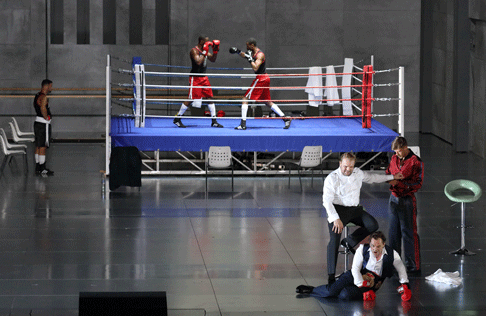 Tomasz Konieczny (Herzog Antoniotto Adorno), Christopher Maltman (Graf Andrea Vitellozzo Tamare), Statisterie der Bayerischen Staatsoper
Tomasz Konieczny (Herzog Antoniotto Adorno), Christopher Maltman (Graf Andrea Vitellozzo Tamare), Statisterie der Bayerischen Staatsoper
That might sound odd, but it is not really so very odd — at least not necessarily. A peculiarity, indeed a fascination, to the opera is that almost every charge one might lay at its door might conceivably meet with the rejoinder: ‘that is the point’. It depends whose point, really: it is less often the point if we focus narrowly on ‘intention’, but why should we? Krzysztof Warlikowski’s production seems to nod to this thorny question by interpolating, immediately after the interval, before the third of the three acts, Schreker’s own character sketch of 1921, in which he presents — even, to an extent, ‘reclaims’, as we might say — accusations thrown at him and his art. It is, we may be reasonably sure, intended ironically or, perhaps better, with understandably vicious sarcasm, having been constructed from criticisms he had received:
I am an Impressionist, Expressionist, Internationalist, Futurist, a musical purveyor of verismo; Jewish, and rose through the power of Jewishness; Christian and was ‘made’ by a Catholic clique under the patronage of a Viennese arch-Catholic countess.
I am a sound artist, sound fantasist, sound magician, sound aesthete, and have no trace of melody (other than so-called short-breathed empty phrases, newly known as Melodielein). I am a melodist of the purest blood, as a harmonist however, anaemic, but perversely in spite of this a full-blooded musician! I am (unfortunately) an erotomaniac and work balefully upon the German public (eroticism is obviously my innermost contrivance, despite Figaro, Don Giovanni, Carmen, Tannhäuser, Tristan, Walküre, Salome, Elektra, Rosenkavalier, and so on). ...
The rest, in which he continues, to explain that he is not of the true modernistic ‘left’ (Schoenberg and Debussy), owes something to Verdi, Puccini, Halévy, Meyerbeer, et al, and so on, may be read here. (It is well worth doing so, if you have the German.) It made for a powerful moment, or rather few moments, in the theatre, not least since Warlikowski has it read by the tragic, ugly hero-artist (the libretto was originally intended for Zemlinsky), who thus becomes at least in part an explicit realisation of Schreker’s plight. The problem, however, remains that, insofar as we may dissociate criticism of Schreker from anti-Semitism — perhaps it is impossible historically, but it need not be so now — many of the criticisms levelled tend actually to be born out; either that or the comparisons (Figaro, Tristan, etc.!) are rather embarrassing, doing neither composer nor opera any favours at all.
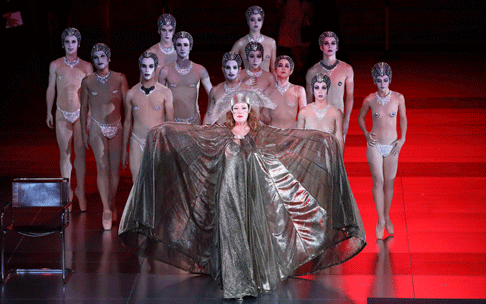 Catherine Naglestad (Carlotta Nardi), Opernballett der Bayerischen Staatsoper
Catherine Naglestad (Carlotta Nardi), Opernballett der Bayerischen Staatsoper
What we have, then, is an evening in the theatre in which that problem is, if not worked out, at least explored. The slipperiness of artistic creation and agency is embodied in Alviano Salvago. Is he a good artist or a con artist? There are many other possibilities; we do not end up necessarily falling short of Mozart and Wagner because we are not trying. Salvago has created a garden of delights, an island park of Elysium, which he wishes to give to the people of Genoa. Is the suspicion of its establishment justified? In part, perhaps. Dark things clearly go on there. Are they the creator’s doing? Not intentionally, but they can be readily understood, made out to be, especially by other, more attractive noblemen who wish to be able to pursue something far more dastardly, indeed truly shocking — such as to leave our aesthetic-moralistic sniping at Schreker-Salvago look at best misguided. Do we really want to be the ones to say ‘yes, I’m sorry, your music is overblown, verging on the formless, an illustration or at least a piece of evidence, moreover, that Schoenberg was right: once a certain point of chromaticism has been reached, there really is nowhere else to go other than somewhere you would not…’, and so on? Of course we do not, especially when we know with whom we are allying ourselves, especially when we know how the crowd may be swayed — either by Salvago or by his opponents. On the other hand, Goebbels is not the only option: there is Schoenberg too; there is Moses und Aron, where we can see and hear these antinomies, or better dialectics, actually treated with the seriousness they deserve.
Give ourselves a third hand, though, or, Blair forbid, a ‘third way’, and perhaps we may wish to tarry. It is not as bad as Korngold, say. There is genuine fascination in the harmonic and instrumental colour: evidence of the most extraordinary ear. Alas, there is such an utter lack of variety that it all sounds more or less the same. One may like the sound; I might, for a few minutes. But for three acts? Three acts, that is, intruded upon only by a strange vulgarity in the third: dramatically effective, to a certain extent, as a suggestion of crowd dynamics, yet ultimately incongruous and, more to the point, unconvincing. The lack of ‘traditional’ melodic invention is not the end of the world in itself, but let us not convince ourselves that this is replaced by the still well nigh incredible perpetual self-transformation of Erwartung. Nor is the lack of musical characterisation necessarily fatal, although it is clearly a flaw, for this is not Fidelio, in which characterisation is simply not the point. Returns, however magnificent they sound in themselves, diminish all the time, without ever being replaced by something which, in that old Romantic way, we might consider to be true inspiration. Contrivance is all very well; who cares, ultimately, if the result is good. But is it?
Warlikowski proves himself, unsurprisingly, a dab hand at the erotomaniac side of things. The burlesque dance performed before the angry Schreker-Salvago is not the half of it, although it is perhaps the most memorable side. He shows also, quite unsparingly, how evil one side of the accusers is: that is, the party of Vitelozzo Tamare. Rich, unscrupulous, deceiving, plausible, violent: it is they who do the real harm, who have kidnapped and abused Ginevra Scotti, whilst framing the poor Salvago. How many other productions manage to incorporate a boxing training session into proceedings, as if to underscore the lavish obscenity of the violence? The humanity of the genuine artist, Carlotta, is underscored equally well, not least given an exemplary, heartfelt performance from Catherine Naglestad. She looks for the soul and perhaps she finds it: or perhaps, given her fate, she realises there is none at all, and is better off out of the game entirely. In that, encasing herself, she becomes an installation, perhaps an artwork of her own. The raging rodent crowd — more than a nod to Hans Neuenfels’s Lohengrin — would neither understand nor care. Salvago does though — we think.
The Bavarian State Orchestra under Ingo Metzmacher played with such glorious golden tone that it might have been the Vienna Philharmonic in Strauss — other, that is, than the score itself not having Strauss’s sense of drama, of direction, of characterisation, and so on, and so on. There was no sense of hurrying, which may or may not have been an unalloyed advantage. I think it was pretty much an advantage, for one certainly gained the impression of the score being permitted to speak for itself, even if to be hoist by its own petard. John Daszak gave a deeply moving account — like so many of the performances, seemingly moving beyond the limitations of the work ‘itself’ — of the central role. Christopher Maltman proved diabolically irresistible as his wicked opponent in love, art, and so much more; there was more than a hint of an ultra-decadent Don Giovanni here (definitely without the idealism — or Idealism). Tomasz Konieczny gave a magnificently forthright performance as Duke Adorno: duly ambiguous as to whose side he was on, if any, never anything but fully committed, though, in vocal terms. The doubling of his part with that of the Capitaneo di giustizia — gleefully ripping off his mask to confirm what we suspected — only heightened the troubling implications. The huge cast did not, so far as I can recall, have a single weak link to it; this, and the equally fine choral contribution showed just what an opera house and company can achieve. The extraordinarily self-reflexive quality of the evening and its aftermath will, I suspect, continue to intrigue. The Vorspiel zu einer Drama, the concert version of the opening Prelude, both says it all — and yet, in another way, says none of that.
Mark Berry
Cast and production information:
Duke Antoniotto Adorno/Capitaneo di giustizia: Tomasz Konieczny; Count Andrae Vitelozzo Tamare: Christopher Maltman; Lodovici Nardi: Alastair Miles; Carlotta Nardi: Catherine Nagelstad; Alviano Salvago: John Daszak; Guidobald Usodimare: Matthew Grills; Menaldo Negroni: Kevin Conners; Michelotto Cibo: Sean Michael Plumb; Gonsalvo Fieschi: Andrea Borghini; Julian Pinelli: Peter Lobert; Paolo Calvi: Andreas Wolf; Ginevra Scotti: Paula Iancic; Martuccia: Heike Grötzinger; Pietro: Dean Power; Youth: Galeano Salas; Friend/Servant/Giant Citizen: Milan Siljanov; Girl: Selene Zanetti; Senators: Ulrich Reß, Christian Rieger, Kristof Klorek; Little Boy: Soloist from the Tölz Boys’ Choir; Servant: Niamh O’Sullivan; Father: Yo Chan Ahn; Mother — Eleanor Barnard; Citizens: Harald Thum, Thomas Briesemeister, Klaus Basten, Burkhard Kosche, Tobias Neumann, Sebastian Schmid. Director: Krzysztof Warlikowski; Designs: Malgorzata Szczęśniak; Lighting: Felice Ross; Choreography: Claude Bardouil; Video: Denis Guéguin; Dramaturgy: Miron Hakenbeck: Children’s Chorus (chorus master: Stellario Fagone) and Chorus (chorus master: Sören Eckhoff) of the Bavarian State Opera/Bavarian State Orchestra/Ingo Metzmacher (conductor). Nationaltheater, Munich, Tuesday 4 July 2017.
image=http://www.operatoday.com/5M1A0891.png image_description=JOHN DASZAK (ALVIANO SALVAGO) [Photo © Wilfried Hösl] product=yes product_title=Franz Schreker: Die Gezeichneten product_by=A review by Mark Berry product_id=Above: John Daszak as Alviano SalvagoPhotos © Wilfried Hösl
Erismena at the Aix Festival
Erismena in Aix was an incredible feat, captivating its audience for nearly three hours, evoking a thunderous applause. Its dramatis personae seducing us with their airs and ariosos, their elaborate recitatives and a final madrigal sung by its two sets of lovers, four soprano voices interweaving with such sweetness that we too drowned in their eternal raptures of love.
It took a long time to get to that madrigal, but no one minded. Least of all, seemingly, the young artists who sustained a concentration of voice and word and line, and the suspended tension of outcome created by the insatiable thirst Aldimira had for lovers, the terrifying dream that haunted Erimante, the dalliances of servants, the discoveries of “real” identities (and so on and so forth). It was the youth and the charm and the excellent artistry of these artists that made the inanities of Venetian opera into high art and great entertainment.
This version of Cavalli’s masterwork was created by Argentine born, Swiss early music conductor Leonardo Garcia Alarcón with his continuos provided by his Cappella Mediterannea (last spring Mo. Alarcón created a version of Cavalli’s massive Giasone for the Geneva Opera). The continuos in Aix were rich indeed with the maestro seated at an organ with virginals atop, harpsichord, two cellos, a bass and three “pluckers” on a variety of instruments. Two violins and two wind players added a plentitude of additional colors for the concerted pieces.
There were always new combinations to support the complications on the stage — from the roughness of Baroque violins, the violence of the cornetti, the sweetness, then unleashed chirping of the flutes, the warmth of full ensemble, the thundering (intended) of the organ. It was a very busy pit, Mo. Alarcón conducting seated, standing, with one hand (the other always at a keyboard), with his head, with his body. It was concentrated, joyous music making.
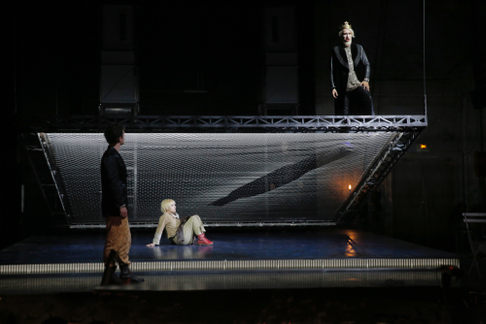 The platform
The platform
On stage there was nothing but a suspendible platform of transparent metal mesh, two elevated doorways, a canopy of suspended light bulbs and five or so cafe chairs from a junk pile somewhere. Think minimalism but do not think it was minimal. Moving these elements every which way as the situations changed throughout the evening was a monumental task. And there was a multitude of lightbulbs, some of which even knew to burst with a bang when there was a revelation down below!
The production requirements and accomplishments were formidable. From the “found” nature of the costuming (but indeed constructed given that no fuchsia suit the size needed to cloth the “skirt role” of the nurse could possibly exist, or the specific choice of fabric and sizes for the skirts worn by the male roles) to the make-up that added flashes of sparkle to the femme fatale Aldimira and the livid facial scar worn by Erimante’s lieutenant Diarte as examples of many.
There was no metaphor. The imagined story of pseudo-Roman history was told as written in this abstract, contemporary setting, French director Jean Bellorini moved his actors on and off the sometimes suspended platform, carefully established a space for each of the arias, changed his actors positions in direct dialogue to punctuate statement, and displaced them in a sudden blackout into a pool of light to utter an inner thought. Mr. Bellorini also masterminded the lighting that was of formidable complexity and huge effect.
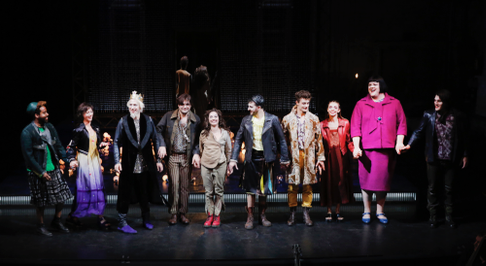 The bows
The bows
This weighty production effort was effectively absorbed, even eclipsed by the individual performances. Italian soprano Francesca Aspramonte sculpted the title role disguised as a warrior in clear tone, making impressive use of the Italian rolled “r” to aggravate her chagrin (she has lost her lover Idraspe to Aldimira), Italian counter-tenor Carlo Vistoli brought sensitivity and strength to Idraspe (who finally, hours later, recognized Erismena). British soprano Susanna Hurrell as Aldimira negotiated her nymphomania with soprano-esque verve, Polish counter-tenor Jakub Jósef Orliński dazzled us with some spectacular breakdance move declaring his love for Aldimira. These four artists delivered the final, mesmerizing, four part madrigal.
Some of the most impressive singing of the evening was achieved by 23 year-old French mezzo Lea Desandre as Aldirmira’s maid Flerida and Italian baritone Andrea Bonsignore as Idraspe’s servant Agrippo. The man who lost it all but gains a daughter and an heir, the Median king Erimante was solidly sung and acted by Russian bass-baritone Alexander Miminoshvili. New Zealand tenor Jonathan Abernathey was the strong voiced, virile lieutenant to King Erimante, these the two male voiced male roles.
Not to neglect dwelling on the crowd pleasing accomplishments of the comic roles — the nurse, Alcesta, well sung and convincingly, even lovingly acted by British tenor Stuart Jackson, and the role of Idraspe’s friend Clereo Moro, sung in very beautiful voice and estimable charisma by American counter-tenor Tai Oney.
The program booklet included a two-page, small print synopsis of the story of the opera. No one but no one could have made heads or tails of it. This excellent production took it all in stride and made an evening of admirable, comprehensible and highly amusing theater.
Michael Milenski
Cast and production information:
Erismena: Francesca Aspromonte; Idraspe: Carlo Vistoli; Aldimira: Susanna Hurrell; Orimeno: Jakub Józef Orliński; Erimante: Alexander Miminoshvili; Flerida: Lea Desandre; Argippo: Andrea Vincenzo Bonsignore; Alcesta: Stuart Jackson; Clerio Moro: Tai Oney; Diarte: Jonathan Abernethy. Orchestre Cappella Mediterranea. Conductor: Leonardo García Alarcón; Mise en scène et lumière: Jean Bellorini; Décors: Jean Bellorini et Véronique Chazal; Costumes: Macha Makeïeff; Wigs and Make-up: Cécile Kretschmar. Théâtre du Jeu de Paume, Aix-en-Provence, July 7, 2017
image=http://www.operatoday.com/Erismena_Aix1.png
product=yes
product_title=Cavalli's Erismena at the Aix Festival
product_by=A review by Michael Milenski
product_id=Above: Francesca Aspramonte as Erismena [All photos copyright Pascal Victor, courtesy of the Aix Festival]
July 7, 2017
Fairytale Spectacle: Turandot at the ROH
Sally Jacobs’ drum-shaped balconies create a frame for Puccini’s enigmatic, imperfect masterpiece, the onlookers forming a sort of Greek Chorus, watching the horrors unfold. Baying for blood like sadistic spectators at a gladiatorial arena, they roar with relish in the opening scene as the Mandarin reads his proclamation of the impending execution of the Prince of Persia.
Despite the passing years, the oriental stylisation - visual and kinetic - remains striking. Giant, grimacing severed heads top towering poles, their blood-red streamers testifying to the agonies suffered by Turandot’s decapitated suitors. The Mandarin mounts a rolling tower to thunder his edicts and incite the crowd’s bloodlust. Emperor Altoum floats down from the fly-loft on a cloud-cushioned golden throne. There is a mammoth gong, a scything executioner’s sword, a giant whetstone transported on an elaborate dragon-cart. When the sky grows dark, in anticipation of Turandot’s delivery of her tyrannous decree, the Chorus’s invocation to the moon initiates the descent of an immense canvas moon which eclipses much of the stage.
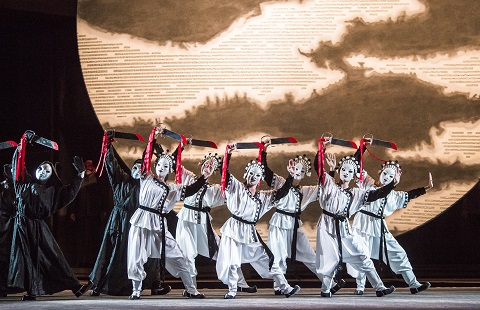 Photo credit: Tristram Kenton.
Photo credit: Tristram Kenton.
Revival director Andrew Sinclair has done a good job, working with original choreographer Kate Flatt, to ensure that the t’ai chi-based movements of the white-masked dancers are slick and fresh. Those ‘grotesque imperial ministers’, Ping, Pang and Pong, cavort with commedia -like outlandishness - perhaps a reminder that the inspiration for Puccini’s opera came from a commedia dell’arte play written in 1762 by Carlo Gozzi, which itself drew upon ‘The Story of Prince Calaf and the Princess of China’ from a collection of Persian fairy tales, The Thousand and One Days.
Indeed, this dialogue of cultures is relevant, for while the production resonates with myth and ritual, it’s a bit of a hotchpotch, with ‘oriental’ interpreted rather loosely (there’s a nod, surely, to Japanese Kabuki and Noh theatre), as well as a few touches of Brechtian alienation. But, this doesn’t really matter; after all, Puccini’s score is itself eclectic and episodic, juxtaposing a plurality of styles and allusions. If Serban and Jacobs have assembled a cultural smorgasbord, then it’s a beautiful and enchanting one; and the visual beauty is often powerfully and disturbingly at odds with the barbarity of the drama.
It also makes a loud impact. In Turandot, Puccini calls for huge orchestral resources, both in the pit and on stage, and conductor Dan Ettinger lets his instrumentalists off the leash. Seated in the Stalls Circle, I’m sure I felt the auditorium tremble when the death-knell drumming pounded during Turandot’s pronouncement of the riddles, and in Act 2 the brass blazed with imperial majesty. Ettinger might have reined things in a bit at times - the ‘power’ of the score was generated by turning the volume up as far as it would go, rather than through surging, well-crafted fullness of sound - as the singers were required to project over unalleviated orchestral swells.
Fortunately, the principals had the necessary vocal strength and stamina. Christine Goerke used her huge voice to capture the heartlessness of the unsympathetic ‘heroine’, who in Serban’s vision is an icy she-devil who delights in sending her hapless suitors to their grisly deaths. Goerke began ‘In questa reggia’ a little cautiously but as she proclaimed the three enigmas there was no doubting Turandot’s venom. Goerke’s soprano gained in focus as the performance proceeded and she was at her best in the final act, her voice sonorous and gleaming. There was little sense, though, of the princess’s ‘inner life’; perhaps, this inevitably remains an enigma - the opera’s unanswered riddle -but if we are to believe in Turandot’s redemption then surely we need to be permitted a little intimacy with the workings of her soul?
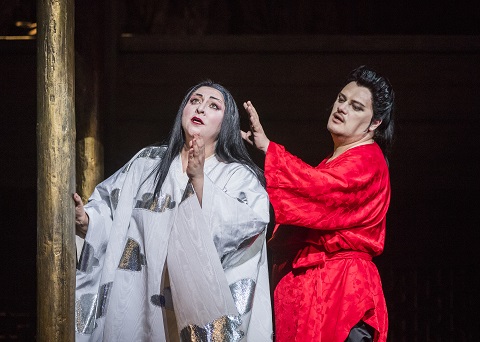 Christine Goerke (Turandot), Aleksandrs Antonenko (Calaf). Photo credit: Tristram Kenton.
Christine Goerke (Turandot), Aleksandrs Antonenko (Calaf). Photo credit: Tristram Kenton.
Aleksandrs Antonenko was a heroic rather than chivalrous Calaf - no-one would have any chance of forty winks during this ‘Nessun dorma’ - but he placed the notes with control and pushed through the soaring lines with warm amplification. Antonenko’s didn’t really bother to act, though the large props and choreographed acrobatics didn’t leave much room for subtle engagement between the characters. In any case, it’s hard to make Calaf’s sudden enthrallment to Turandot’s ‘charms’ credible, and Antonenko was a fittingly gallant hero who brought daylight back to Turandot’s night-dominated realm and restored the patriarchal gender hierarchy.
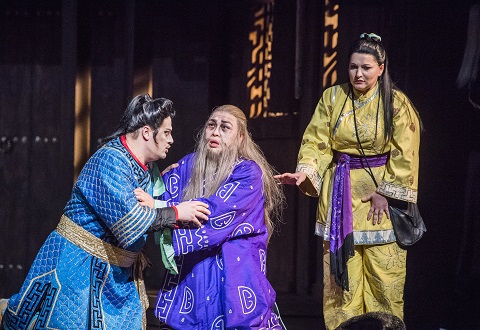 Aleksandrs Antonenko (Calaf), In Sung Sim (Timur), Hibla Gerzmava (Liù). Photo credit: Tristram Kenton.
Aleksandrs Antonenko (Calaf), In Sung Sim (Timur), Hibla Gerzmava (Liù). Photo credit: Tristram Kenton.
As Liù - Puccini’s archetypal suffering heroine, subservient, innocent, self-sacrificing - Hibla Gerzmava sang with a winningly sweet tone balanced by innate strength. During her fifteen-minutes of emotional torment in the final act, Gerzmava movingly conveyed the unconditional love which underpins Liù’s purity.
Yury Yurchuk was an authoritative Mandarin, though I thought that In Sung Sim’s Timur needed a bit more nobility and stature. Robin Leggate brought out the Emperor’s gentility and regretfulness, in contrast to the vicious cruelty of Ping (Michel de Souza), Pang (Aled Hall) and Pong (Pavel Petrov), who formed a well-integrated trio but had little to distinguish them as individuals.
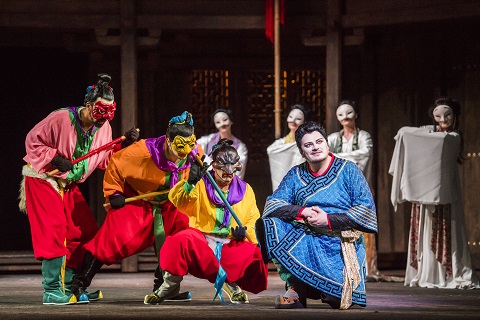 Michel de Souza (Ping), Pavel Petrov (Pong), Aled Hall (Pang), Aleksandrs Antonenko (Calaf). Photo credit: Tristram Kenton.
Michel de Souza (Ping), Pavel Petrov (Pong), Aled Hall (Pang), Aleksandrs Antonenko (Calaf). Photo credit: Tristram Kenton.
The main weakness of Serban’s production is that it denies us understanding of the causes of Turandot’s apparent inhumanity, and thus makes her atonement less convincing. The narration in which she explains the reasons for her misogyny, should make us understand that she speaks as an avenger, as one whose ancestress who was raped and murdered thousands of years ago. As one whose violence is retribution for the violence done by men to all women; as one determined to the be agent of her own destiny. Serban creates little sense of the emotional energies which drive the drama and shape the dynamic between Turandot and Calaf. And, the sense of emotional stasis is exacerbated by the literal stasis of the chorus - a result of lack of time to stage the Chorus in the hasty run-up to the production’s premiere as part of the 1984 Olympic Arts Festival in Los Angeles - though the ROH Chorus were, as ever, in tremendous voice as they expressed their perverted pleasure at the executioner’s bloody deeds.
Despite this misgiving, this production just about avoids the composer’s own tendency to indulge in kitsch and offers fairy-tale spectacle with some spectacular singing. A real summer treat.
Claire Seymour
Giacomo Puccini: Turandot
Princess Turandot - Christine Goerke, Calaf - Aleksandrs Antonenko, Liù - Hibla Gerzmava, Timur - In Sung Sim, Ping - Michel de Souza, Pang - Aled Hall, Pong - Pavel Petrov, Emperor Altoum - Robin Leggate, Mandarin - Yuriy Yurchuk; Director - Andrei Serban, Conductor - Dan Ettinger Designer - Sally Jacobs, Lighting designer - F. Mitchell Dana, Choreographer - Kate Flatt, Choreologist - Tatiana Novaes Coelho, Orchestra of the Royal Opera House, Royal Opera Chorus (Chorus Director, William Spaulding).
Royal Opera House, Covent Garden, London; Wednesday 5th July 2017.
image=http://www.operatoday.com/Turandot-ROH-234%20TURANDOT%20PRODUCTION%20IMAGE%20%28C%29%20ROH.%20PHOTO%20BY%20TRISTRAM%20KENTON.jpg image_description=Turandot , Royal Opera House, Covent Garden product=yes product_title=Turandot, Royal Opera House, Covent Garden product_by=A review by Claire Seymour product_id=Above: TurandotPhoto credit: Tristram Kenton
July 5, 2017
Fidelio at Princeton Festival
Yet one senses throughout Beethoven’s inexperience with the operatic genre. He toiled on Fidelio for over a decade, through three versions and four overtures, complaining that it would have been easier to start over. The result bears the marks of a struggle, not entirely successful, to impose coherence on conflicting plot elements and musical styles.
The bourgeois domesticity with which the opera begins—based on a trivial matter of unrequited petit-bourgeois love—alternates, often abruptly, with the universal struggle for political justice against tyranny. Beethoven increasingly came to see the latter as the opera’s real theme; it is no coincidence that the real-world story that inspired the libretto took place during the Reign of Terror in 1794. Yet he never entirely erased the traces of the previous, more prosaic theme.
 Opening staging
Opening staging
Of course the personal and the political are connected: in order to fight for universal human rights, Beethoven seems to be saying, we must transcend more immediate concerns about material comfort, family attachments and personal safety. Or, more subtly, we must learn that a genuine commitment to the welfare of those in our immediate surroundings may well imply that we struggle for universal justice.
Yet Beethoven never entirely succeeds in weaving the personal and the political into a coherent musical tapestry. Fidelio set a new standard for music of heroic grandeur: at its best, it nobly portrays secular idealism by drawing on elements of religious music, as in numerous choruses and the solo numbers of Leonore and Florestan—and, later, in the Ninth Symphony. Yet the opera also contains numerous Singspiel, opera buffa and spoken elements that seem to have parachuted in from another opera. Struggling to combine the two types of expression, Beethoven’s score repeatedly thrusts powerfully forward and upwards only to be brought back down earth by comic relief, lighter music, and spoken dialogue.
These awkward tensions have an important implication: a great live performance of Fidelio demands that performers infuse every moment with vocal and orchestral conviction so powerful as to sweep away all hesitations and misgivings. In the mid-20th century, many treated Fidelio as a grand symphony and looked to great conductors to supply this forward impetus.
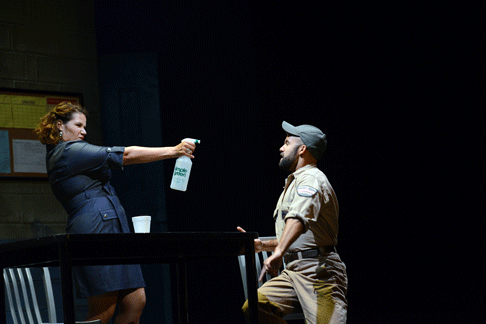 Danielle Talamantes (Marzelline) & Michael Kuhn (Jaquino)
Danielle Talamantes (Marzelline) & Michael Kuhn (Jaquino)
In this spirit, conductor Richard Tang Yuk, director of the Princeton Festival, invoked the admirable tradition of inserting the epic Leonore Overture No. 3 before the final scene—a practice now threatened by musical literalism, short audience attention spans, and union wage scales. Here, as elsewhere, the slimmed-down orchestra played smoothly and surprisingly error-free throughout. This is no small feat, as the score contains cruelly exposed wind parts that occasionally embarrass even the world’s greatest musicians.
Yet interpretively, the orchestral playing was less than the sum of its parts. Yuk’s approach to the score—as has been true before in Princeton—tends to privilege smoothness and accuracy over energy and attack. He selected cautious tempos and smoothed Beethoven’s dynamics to the middle of the spectrum. The overtures and the opening to Act 2 were lovely in places but lacked sweep and drama. A more impetuously inflected approach to the orchestral score, as Beethoven himself reportedly conducted it, would have been welcome—even at the cost of a few more bloopers. The orchestra was also generally too loud when accompanying singers and too soft (or improperly accented) in grand orchestral moments like the Leonore No. 3. The dynamics in the vocal score—except in a few exceptional numbers—tend to be p or pp when anyone is singing, and marked louder and regularly punctuated by Beethoven’s distinctive accented dynamics (sfp and fp) when he wants the orchestra to be more prominent.
The primary responsibility for bringing this Fidelio to life, therefore, fell on the singers. The Princeton Festival casts solidly and this year it assembled seven vocalists, each of which is the model of the modern American singer. Armed with degrees from top conservatories, competition awards, and experience in young singers’ programs, most are now in their 30s, working their way up in a tough profession. At major houses like the MET, they sing comprimario roles or cover more established colleagues; at regional companies, they sometimes assume lead roles. Most also do concert or Broadway work, and several have foreign experience.
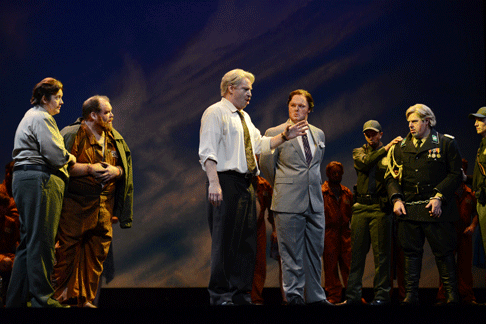 (L-R) Marcy Stonikas (Leonore/Fidelio), Noah Baetge (Florestan), Gustav Andreassen (Rocco), Cameron Jackson (Don Fernando), Joseph Barron (Don Pizarro)
(L-R) Marcy Stonikas (Leonore/Fidelio), Noah Baetge (Florestan), Gustav Andreassen (Rocco), Cameron Jackson (Don Fernando), Joseph Barron (Don Pizarro)
By far most impressive among them is Noah Baetge. From the first word of Florestan’s Act II recitative—a striking messa di voce from pianissimo to forte and back on “Gott!”—he displayed a voice of potential greatness. I have rarely heard any tenor, live or in recordings, so effortlessly navigate Beethoven’s unforgiving heights, to which Baetge adds heroic brilliance, a sweet timbre and spot-on intonation. A bit more weight in some swiftly moving passages lower down and better German diction (especially spoken) would have rendered this performance worthy of a major house. I have not heard such a thrilling voice in live opera in Princeton since the young Lisette Oropesa appeared a decade ago in Lucia di Lammermoor—a role she reprises this fall at Covent Garden.
Raised in Chicago and now based (like Baetge) in Seattle, Soprano Marcy Stonikas has sung Leonore at the Vienna Volksoper. She deploys a voice of considerable weight with conviction. For lack of more freely soaring high notes and warmer low ones, and a general cautiousness of utterance, the character of Leonore never came entirely to life.
The rest of the cast sang with uniform professionalism. Norwegian-American bass Gustav Andreassen made a solid Rocco, even without the warm bass, crisp articulation and clear diction appropriate to his voluble paternalism. Soprano Danielle Talamantes (a graduate of nearby Westminster College) and tenor Michael Kuhn (who appeared in “A Little Night Music” last year in Princeton) waxed passionate as Marzelline and Jaquino, even if somewhat they lacked some smoothness and charm. (Kuhn, an experienced Broadway singer, did act convincingly.) Pennsylvanian bass-baritone Joseph Barron, returning after “Peter Grimes” last year, chewed the scenery as a truly villainous Don Pizarro. Cameron Jackson, still attending graduate school in North Carolina, presented a believable Don Fernando. The chorus sang lustily, with fine solos from the two prisoners.
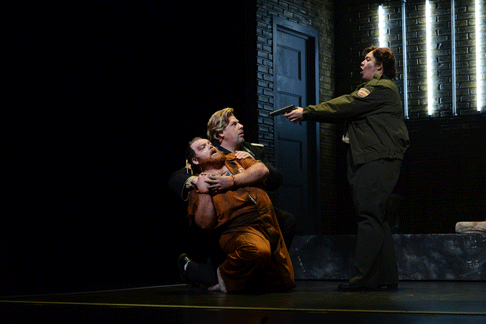 Marcy Stonikas (Leonore/Fidelio), Noah Baetge (Florestan), Joseph Barron (Don Pizarro)
Marcy Stonikas (Leonore/Fidelio), Noah Baetge (Florestan), Joseph Barron (Don Pizarro)
The Princeton Festival’s long-time stage director, Steven LaCosse, set the action in modern Spain, with Florestan as a union organizer, Rocco as an older prison warden, Marzelline as his daughter, Jaquino as a janitor, Don Fernando as a prime minister in a fancy grey suit, and so on. Some of the resulting dramatic action, especially in Act I, was remarkably convincing to a modern audience.
While I deplore, for example, the modern habit of distracting audiences by “staging” overtures and “entre’acts” behind a scrim. (This is particularly annoying when the music from which one is being distracted is a timeless Beethoven overture.) Yet I must admit that this approach worked well: during the Fidelio overture, we saw Florestan being arrested for holding a union meeting and during the Leonore No. 3 we saw loved ones greeting the freed prisoners one-by-one as they emerged from the subterranean prison. Both stagings tastefully went dark at the recapitulation, giving music lovers their moment, too.
Similarly impressive was the use of class distinctions to underscore conflicts, as with Marzelline’s unwillingness to give Jaquino the time of day apparently because he is a custodian. For the first time ever, I heard an audience actually laugh at the comic interchanges in the first scene. And amidst the concluding jubilation, I appreciated the conceit of the lead characters giving brief TV interviews.
Otherwise the sets honed to the successful formula of opera at the Princeton Festival: simple, suggestive, realistic and brightly lit. One suggestion for the future. It is always worth the expense—especially in a hall like Matthews Theater, with exceptionally harsh and cold sound—to create acoustically resonant scenery. Above all, that means avoiding “open” sets (scenery without backs, sides or a top), which project substantially less vocal sound to the audience (up to 25% less, according to some studies). This surely contributed to the persistent imbalance between orchestra and singers—except in the case of Noah Baetge, a singer I hope to hear again soon.
Overall, with this Fidelio Princeton Festival extends a string of remarkably accomplished and successful operas—an impressive achievement not least because each production receives only two performances. The audience, which filled about ¾ of the hall, responded enthusiastically.
Andrew Moravcsik
image=http://www.operatoday.com/Jessica-Franko-06.15.17_Fidelio_0825_EDIT.png image_description=Marcy Stonikas (Leonore/Fidelio) [Photo by Jessi Franko Designs LLC] product=yes product_title=Fidelio at Princeton Festival product_by=A review by Andrew Moravcsik product_id=Above: Marcy Stonikas (Leonore/Fidelio)Photos by Jessi Franko Designs LLC
Carmen at the Aix Festival
This new production by the Aix Festival was awaited with bated breath, Tcherniakov no stranger at the Aix Festival with two recent, unforgettable Don Giovanni under his belt, and the Aix Festival debut and role debut of conducting star Pablo Heras-Casado.
The euphoria and the dangers of imagining Bizet’s Carmen have long challenged avant-garde directors, among notable examples in my experience the by now historic stagings of Harry Kupfer and Calixto Bieito. The bar has been set always deeper into re-imagining the piece, and now Dimitri Tcherniakov has simply knocked the bar off its pinnings.
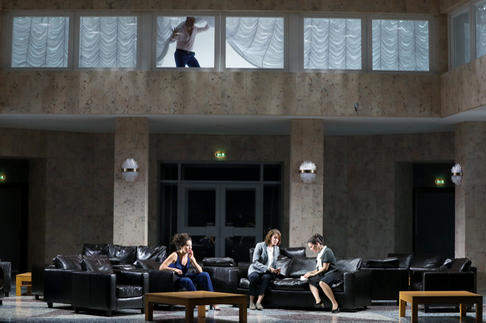 The card trio
The card trio
Tcherniakov’s Carmen is no longer Carmen. It is the naked destruction of a human psyche, Carmen is merely its means. Layers of emotional bravado are meticulously stripped away within Tcherniakov’s chamber of horrors, a type of corporate-style self-improvement sanitarium. Not only the male anima is destroyed by an unfathomable sensation of maybe love, so also is the female anima destroyed. The tragedy sinks to the most elemental level of human existence, feeling laid bare. It is ugly, not cathartic.
To get there Tcherniakov has constructed a witty platform that ruthlessly plays with Bizet’s opera, and plays with us, challenging us to make it into a Carmen. Maybe you will be able to — there are five more performances and the production will travel to Luxembourg. I could not find a Carmen, this staging was not a real, working metaphor. But yes, the experience was pure gesamtkunstwerk, and high art, very high art.
Conductor Pablo Heras-Casado gave corpus to the stage. It was orchestrally full-throated, forcing out always intense feeling, i.e. the ultimate emotional elaboration of every melody, and the uncovering of emotional depths by laying bare the inner workings of Bizet’s harmonies and structures (who knew they were so incredibly rich). He took the Seguidilla to impossible hysterical frenzy, rendered the third act idyll as intense uncertainty, promise and frustration. As Tcherniakov laid naked his victims, the maestro flayed their feelings.
French diva Stéphanie d’Oustrac moved through Tcherniakov’s paces balancing a number of personalities, living not only the realities of Bizet’s vocal heroine and Merimée’s cold gypsy but also the delicacies, fears and sympathies of a real woman, and at the same time the detached professionalism of Tcherniakov’s illusive metaphor. The extent of these changing emotions were exponentially explored, her persona and her voice able to find always another elaboration, another level of feeling, another release of spirit.
American tenor Michael Fabbiano has the young tycoon swagger, the thirst for the ultimate experience, the blatant bravery, the unstoppable drive, the hidden vulnerability and the final weakness of all heroes. Mr. Fabbiano’s essentially monochromatic voice served this Jose to the fullest, his persona able to sustain the pressures and the abuse he imposed on himself until his final destruction. May you too beware of self discovery.
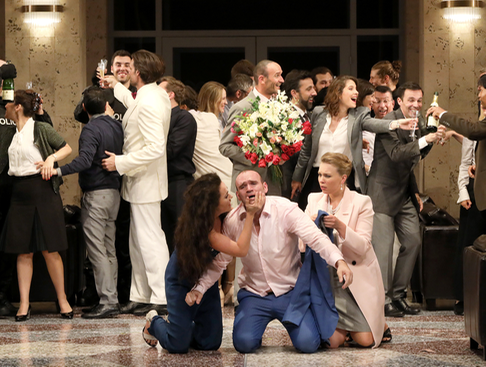 Jose'e graduation. Carmen, Jose, Michaëla
Jose'e graduation. Carmen, Jose, Michaëla
In Tcherniakov’s spoken frame for the opera Micaëla was Jose’s wife. Sung by French-Danish soprano Elsa Dreisig she used a bell-like purity of tone, in fact of metallic strength to push her husband into finding deeper feelings for her, i.e. so that he could give her more than wealth. This Micaëla was maybe a lot like Tcherniakov’s Lady Macbeth, but here in search of a sort of selfish emotional power.
American baritone Michael Todd Simpson had the task of acting out a matinée idol in Tcherniakov’s implied metaphor. The smugglers were simply magnificent, the quintet a masterpiece of execution. The children’s chorus was in the pit, in impeccable unison with the stage (the male chorus mouthed their words in hilarious pantomime).
Essentially the same set as his Don Giovanni which he used for his two distinctively different stagings perhaps Tcherniakov will use this set as well to stage a second edition of this Aix Carmen. There will always be something more to say.
Michael Milenski
Cast and production information:
Carmen Stéphanie d’Oustrac; Don José: Michael Fabbiano; Micaëla: Elsa Dreisig; Escamillo: Michael Todd Simpson; Frasquita: Gabrielle Philiponet; Mercédès: Virginie Verrez; Zuniga: Christian Helmer; Moralès: Pierre Doyen; Le Dancaïre: Guillaume Andrieux; Le Remendado: Mathias Vidal; L’Administrateur: Pierre Grammont. Chorus: Chœur Aedes; Childrens Chorus: Chœur d'enfants Maîtrise des Bouches-du-Rhône; Orchestra: Orchestre de Paris. Conductor: Pablo Heras-Casado; Mise en scène, décors et costumes: Dmitri Tcherniakov; Costumes: Elena Zaytseva; Lumière: Gleb Filshtinsky. Grand Théâtre de Provence, Aix-en-Provence, July 4, 2017.
image=http://www.operatoday.com/Carmen_Aix1.png
product=yes
product_title=Carmen at the Aix Festival
product_by=A review by Michael Milenski
product_id=Above: Stéphanie d'Oustrac as Carmen, Michael Fabbiano as Jose [All photos by Patrick Berger/ArtComPress) of the Aix Festival]
July 4, 2017
Pinocchio in Aix (World Premiere)
The metteur en scène of this Pinocchio telling was Joël Pommerat, a 54 year-old French theatrical thinker who says he is an auteur de spectacle. When Mr. Pommerat turned 40 years-old he made a pact with a group of actors to create a show each year for 40 years. Thus he has a lot of experience creating shows and intends to create a lot more.
He authored a Pinocchio in 2008. But it was hardly on the scale of grand opera on the stage of one of the world’s important festivals of lyric theater. This 2017 Aix Pinocchio is big, great big and truly magnificent. It is grand opera complete with a ballet!
Mr. Pommerat writes shows about the world he and we live in — the “we” limited in no small way to a fairly rarefied world of the French avant-garde. Thus it was to that world that the mostly French audience of this international festival ascended. It is a perch that makes an intellectual, or theatrical game of animating fancy theatrical and musical genre with low-life characters, values, aspirations and situations. But not without intervention from much higher forms of life and art. Like Mr. Pommerat’s théâtre. Like la grande musique classique (oft referred to in Mr. Pommerat’s libretto).
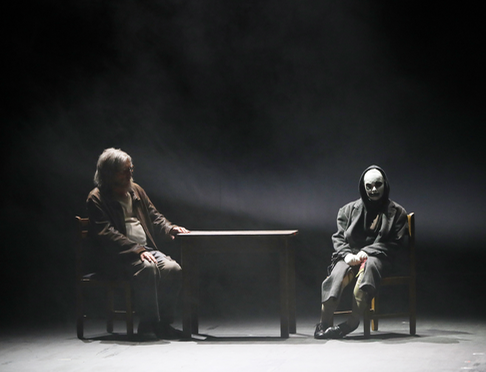 Vincent Le Texier as Pinocchio's father, Chloé Briot as Pinocchio
Vincent Le Texier as Pinocchio's father, Chloé Briot as Pinocchio
Pinocchio was an ideal subject to inspire Pommerat’s substantial operatic theatrics! Maybe here is where the actual music of the evening might be mentioned. The sound world accompanying Mr. Pommerat’s show was created by French composer Philippe Boesmans. This fine composer gamely built the complex world of Mr. Pommerat’s theatrical quotes of expressionism, cabaret, circus, fairyland, etc., and, yes, opera too.
Mr. Boesmans took a bow at the end of the show, sadly missing from the opening night accolades to the stage was Mr. Pommerat himself.
The music was always attractive, as was of course Mr. Pommerat’s show, the most lovable moments when the basic musical recitation of text burst into arioso — brief, even sometimes not so brief melodic flights that invited us to partake of moments of emotional release in pure operatic bel canto!
And, yes, the ballet — that was scene 16 (of 24), about the place of the traditional grand opera fourth act ballet. A group of ragamuffins were called onto the stage to seemingly rap dance to the howling klezmer band (an accordion, saxophone and violin who were in fact on-stage much of the evening, chiming in charmingly in all sorts of occasions).
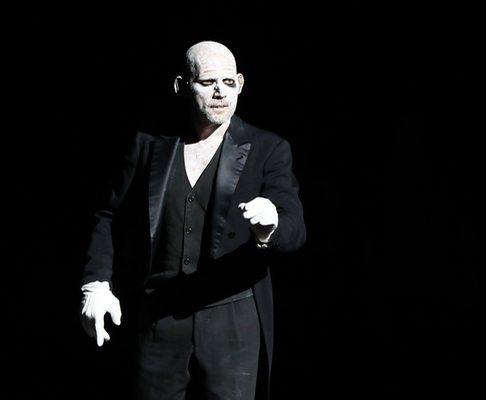 Stéphane Degout as the Director of the Troop (narrator)
Stéphane Degout as the Director of the Troop (narrator)
All of Collodi’s Pinocchio was essentially present, but reclothed, most importantly with a narrator (the director of a theatrical troop that completed Mr. Pommerat’s larger metaphor) who made the transition from Collodi’s narrative text to Mr. Pommerat’s theatrical text. This role was superbly delivered by French baritone Stéphane Degout who kept us spellbound whenever the narrator took over or morphed into the circus director. His spoken French was brilliantly clear, as was his sung French to the degree that it was not included in the supertitles.
Pinocchio himself (herself) was diminutive French soprano Chloé Briot, supple of voice and of body (an incredible running leap up onto a table). She created a real Pinocchio, that is she found the brashness, the brattiness, the intelligence, the soft spots and finally the dignity of the brat becoming a real boy on his way to a classical music concert. A superb performance.
As usual at the Aix Festival casting was exemplary, mastery of vocal technique a given, appropriate colors of voice in place, physique and personality of actor in harmony with character.
Argentine/Italian conductor Emilio Pomarico presided over 19 players of the Klangforum Wein who easily made the magical sounds of the fairy world alongside the brash out-of-tune trumpets of composer Boesmans' musical dada.
Transforming metteur en scène Pommerat’s textural and dramatic world into a magical theatrical world was his long time collaborator set designer/lighting designer Éric Soyer who was joined by video designer Renaud Rubiano. The visual language is minimalism, the colors black and white, light and dark, stark and bright. The effects were huge, the moments were precise, the video seamlessly integrated to deploy massive, epic images. It was everything you expect from the minimal means of studio theater magnified with taste and intelligence to technically complex grand opera proportions.
Yet it was a long evening. Maybe you had to be French.
Michael Milenski
Cast and production information:
Le directeur de la troupe / premier escroc / deuxième meurtrier / le directeur de cirque: Stéphane Degout; Le père / troisième meurtrier / le maître d’école: Vincent Le Texier; Le pantin (Pinocchio): Chloé Briot; Deuxième escroc / le directeur de cabaret / le juge / premier meurtrier / le marchand d’ânes: Yann Beuron; La chanteuse de cabaret / le mauvais élève: Julie Boulianne; La fée: Marie-Eve Munger. Orchestre Klangforum Wien. Conductor: Emilio Pomarico; Mise en scène: Joël Pommerat; Décors et lumière: Éric Soyer; Costumes, maquilleage, perruques: Isabelle Deffin; Vidéo: Renaud Rubiano. Grand Théâtre de Provence, Aix-en-Provence, July 3, 2017
image=http://www.operatoday.com/Pinocchio_Aix1.png
product=yes
product_title=World Premiere of Pinocchio at the Aix Festival
product_by=A review by Michael Milenski
product_id=Above: Marie-Eve Munger as the Good Fairy, Chloé Briot as Pinocchio [All photos by Patrick Berger/ArtComPress, courtesy of the Aix Festival]
Franz Schreker Die Gezeichneten, Bayerische Staatsoper
Die Gezeichneten flows from the same Zeitgeist that produced Freud, Expressionism, modern art and literature. In the libretto, Schreker makes a wry dig at Puccini and Strauss, meaning, I think, Johann rather than Richard, for Die Gezeichneten has a lot in common with Die Frau ohne Schatten. Both operas, written at the same time and premiered within a year of each other, explore the nature of creative art through a lens of morbid psychology, which is a theme which runs through much of Schreker's work. Directed by Kryzsztof Warlikowski, this production is musically sensitive and well informed, and also connects the opera to other currents in art and society in its time. This Die Gezeichneten goes a long way to restoring Schreker's true status in cultural history.
Metzmacher conducted the Vorspeil so the surging pulse heaved, as if propelled by ocean tides. Salvago's Elysium is an island, as isolated as the man himself, surrounded by currents beyond his control. The moon controls tides. The image of the moon appears in the libretto, intensified by musical figures that describe darkness and flickering light. To the Greeks, the moon symbolised Athena, the goddess of art. For Goethe, the moon symbolised chastity, inspired by his patroness, the Duchess of Weimar. As the Vorspeil proceeds, we see Salvago (John Daszak) , his head covered by a bag, looking towards an orb of white light that dominates the darkened stage. Later, when Carlotta (Catherine Nagelstad) is seduced, the orb turns red (as described in the text).
Complex dichotomies operate throughout this opera, reflecting conflicts that can never be reconciled. Ugliness and beauty, creativity and destruction, purity and corruption: thus the churning tensions in the music. Metzmacher isn't afraid to emphasise the contrast between lush orchestration and the savage undercurrents. Luxury is deception. Like the grotto, beauty is delusion. Women are violated. Lust is joyless, motivated by power, money, and something even more sinister. Carlotta succumbs, as graphically described in the text and music. Wisely, Warlikowski doesn't depict the scene, concentrating on Tamare's braggadocio and the music around it. Salvago isn't as upset by the idea of Carlotta being raped as by the realization that she might have had a part in proceedings. We see her dressed in white, her dress back to front. The ensemble that follows isn't a trio, because all three characters are singing at cross-purposes. No dissonance but no harmony, either. Wonderfully astute writing on Schreker's part and well executed in performance.
Salvago creates Elysium to please his friends, as if by creating art he can compensate for his physical ugliness. How far is he culpable when his friends misuse his grotto for evil? Carlotta falls in love with him partly because she can see good in him, but also because she sees the potential for artistic creation of her own. In some ways, the second act is the heart of the whole opera. Carlotta's friend paints only hands, but the hands she paints are so expressive that they can portray whole stories. Art is invention, but can reveal deeper truths. Thus Carlotta, an artist, sees more in Salvago than meets the eye. Thus scene is brilliantly depicted, with imagination and sensitivity. A second stage appears behind the singers. At first we see what appears to be a dragonfly, which turns out to be a young girl. She has the head of a mouse. Her family are around her, too, sometimes interacting. Humans with mouse heads. We are in Die Frau ohne Schatten territory, or rather the world of surreal symbolism that fascinated a generation familiar with Classical antiquity, discovering psychology and Jungian archetypes. Clips of silent movies appear behind the action. Scenes from Der Golem, and Frankenstein, where a "monster" shows tenderness to a little girl, then scenes from The Phantom of the Opera and Nosferatu where the "monster" isn't benign. Thus Warlikowski makes connections between Die Gezeichneten and other Schreker operas, with other cultural memes which confront sexuality and fear.
Warlikowski doesn't need to show Carlotta with paintbrush and easel. Her painting exists in her soul. Does she love her creation more than reality? Why does he pull back, paralysed with inhibition, when his wildest dreams come true as she declares her love ? Why does she, too, pull back on the eve of their wedding ? Does she intuit that their relationship will be sterile due to his inhibitions ? Does she respond to Tamaro because he's sexual, or because he has the courage Salvago lacks? Christopher Maltman, as Tamaro, is a hunk. Salvago lives in his head, while Tamaro lives in his body. He doesn't like mirrors because they make him face himself. But can he escape? Warlikowski's staging (sets by Malgorzala Szczesniak) hints as what is not said. Mirrors, often distorted, appear now and again, sometimes as physical mirrors, sometimes as subsidiary characters like Mattuccia (Heike Grotzinger) and Pietro (Dean Power), usually roles so small they don't get attention, but which exist for a reason. Salvago isn't the only person trapped in games in the guise of service to others. A wonderful touch - Metzmacher himself is glimpsed on stage from time to time, reflected in the mirrors.
In this production, Salvago's spoken monologue is included, which makes a difference since it shows how he reflects on his own condition though he can't break out of it. Though he didn't rape women, he is morally culpable by making the violence possible,. Extremely moving, especially since Daszak delivered it with great dignity.
Schreker writes an angelus into the music before the wedding party. Angels appear on stage, but angels dressed in nude suits. They (male and female) are supposed to resemble showgirls but they dance so deftly en pointe that they're clearly ballet dancers with great technique. The wedding guests are prissy: they don't like nakedness but sex is all around. Later a voluptuous stripper bumps and grinds beside Salvago, who doesn't notice. Either he's too uptight or he can't see the beauty beneath her poundage. Eventually, like so many others before her in this production, she ends up inert, in a display case, unused.
At the end, Tamare sings about a village fiddler gone mad because the girl he loved found another man. This is a reference to a medieval legend, which pops up often in German literature and song. Salvago asks for his cap and bells. Has he gone mad, or are he and Tamare re-enacting an old saga ?? There are so many levels in Schreker's Die Gezeichneten, skilfully blended together, Warlikowski's silent movie clips and business suits extend what is already in the opera, though few productions come as close to its true spirit. Altogether, the finest full Die Gezeichneten that I can imagine, full of detail and sensitive to music and meaning. Bayerische Staatsoper productions don't usually make it to DVD, but the audio recording to get is the operfa is the one conducted by Lothar Zagrosek, DSO Berlin from the Decca Entartete Musik series, the benchmark reference. Outstanding, and even Matthias Goerne (aged 26) in a minor role.
Anne Ozorio
image=
image_description=
product=yes
product_title=Franz Schreker : Die Gezeichneten, Bayerische Staatsoper, Munich 2nd July 2017 live broadcast. A review by Anne Ozorio
product_by=
product_id=
product_url=
July 3, 2017
Natalya Romaniw: 'one of the outstanding sopranos of her generation’
As I wrote in my review of the production, ‘her terrible bereavement, at first quietly accepted, resurges with terrifying force when … she recognises the tiny red cap that she knitted for him. Never has such a small motif borne an emotional weight of greater poignancy.’
During our conversation, it’s clear that Romaniw genuinely ‘lives’ Jenůfa’s tragic disillusionment, when hopes of healing - through marriage with Laca - are destroyed in an instant by the irrevocable secrets of past sins and suffering. Indeed, who in the audience could doubt Romaniw’s utter commitment, so burdened by emotional truth is her searing soprano. But, it’s equally evident that the Welsh singer has a level-headed and pragmatic approach to her art, which brings an honesty to her interpretations and a striking lack of pretentiousness to her engagement with her profession.
Romaniw seems, with genuine delight, hardly to believe that she is singing in the UK’s top opera houses at all, let alone that she is receiving stellar reviews for her dramatically acute and vocally heart-grabbing performances. Last year her interpretations of two Tchaikovsky roles - Tatyana in Garsington’s Eugene Onegin and Lisa in The Queen of Spades at Investec Opera Holland Park, thrust her into the foreground with the Sunday Times extolling her as ‘a Tatyana in a thousand’ and the Daily Telegraph lauding her as ‘one of the outstanding sopranos of her generation’. More recently, Romaniw has been nominated for this year’s’ Times breakthrough category in the South Bank Sky Awards, with the winner due to be announced at the Savoy in London in Sunday 9th July.
But, as a young girl from Swansea, the daughter of police officers who enjoyed music theatre, the world of international opera must have seemed light year’s away. But, the Ukrainian grandfather to whom she owes her surname, who taught himself to play the accordion and played his granddaughter Ukrainian songs, must have sown fertile musical seeds. Singing lessons developed her nascent talent and after performances with Welsh National Youth Opera, she found herself at the Guildhall School of Music and Drama.
Romaniw recounts with characteristic ingenuousness a singing class early on in her student career, where her enthusiasm and willingness to learn led her to volunteer to sing in front of other students who seemed amazed by her choice of ‘Vissi d’arte’. ‘It was what I knew,’ she laughs. And, little did her fellow students know, at that stage, that Romaniw would go on to win the prestigious Gold Medal in her final year. It is surely this candour, keenness and frank self-reflection that contribute to her utterly engaging stage presence.
Other accolades followed, including the Clonter’s Opera Prize in 2010 - an inter-conservatoire prize awarded to singers nominated by the heads of opera at six of the UK’s leading music colleges - and both the Loveday Song Prize and overall First Prize at the Kathleen Ferrier Awards in 2012.
It hasn’t all been absolutely plain-sailing, though. Having won the London Welsh Singer’s Competition in 2008, the following year Romaniv found herself selected as the Welsh representative in the BBC Cardiff Singer of the World competition, and though she obviously relished the experience and was a Song Prize finalist, she feels that the opportunity came a little too early in her career.
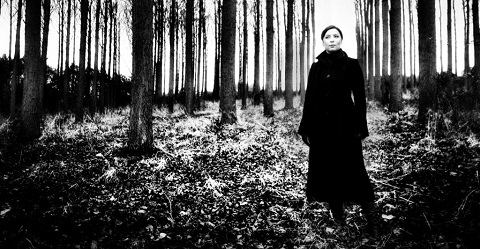 Photo credit: Patrick Allen, Opera Omnia.
Photo credit: Patrick Allen, Opera Omnia.
But, she has a wise head on young shoulders. Following her Ferrier Award success, Romaniw joined the Houston Grand Opera’s Young Artist programme, deciding that this was the best route to develop her voice and experience a wide range of repertoire, in the process turning down places on the Jette Parker Young Artist scheme at the ROH and the study programme at New York’s Metropolitan Opera, for which she was also accepted. It was a good choice. In 2012, she was the second prize winner of the Eleanor McCollum competition at Houston, and during the two-year programme sang Ortlinde (Die Walküre), Mimi, Ines (Il Trovatore), Rosalinde ( Die Fledermaus), Micaela, and Krystina (The Passenger). Returning to the UK she won roles at Holland Park (as Maliela in Wolf-Ferrari’s I gioielli della Madonna, Romaniw was praised by the Guardian for her ‘forthright vocalism and astutely managed, siren-like tempting’) and at Scottish Opera (Foreign Princess Rusalka). She also sang the Governess in Glyndebourne’s 2014 touring production of The Turn of the Screw, having previously covered several roles in the main house including Anne Truelove (The Rake’s Progress), Armida (Rinaldo) and the Countess (Figaro).
Despite such accomplishments, Romaniw remains refreshingly self-effacing and down-to-earth, as when recalling a performance of Beethoven’s 9 th Symphony with the Hallé under Sir Mark Elder, before which she was a bundle of nerves in what she saw as the company of more experienced colleagues.
Of late, Romaniw’s successes have come in ‘Slavic’ roles and I ask her if she feels that she has a special affinity to the language and music of Eastern Europe. She replies that she finds the idiom comes naturally to her, that she is able to learn the roles quickly, and that she doesn’t find the language challenges too taxing; indeed, she enjoys working through the relationships that develop through the libretto text with her fellow performers during rehearsals.
There is more Janáček and Tchaikovsky to come: later this month she will perform the former’s Glagolitic Mass in Worcester Cathedral, at the Three Choirs Festival, and then she reprises her Tatyana with Welsh National Opera this autumn and with Scottish Opera next spring. She is aware that some may wonder why she wishes to repeat these roles, but Romaniw feels that her interpretation can grow further, especially in different productions and working with different directors.
I ask the usual ‘end-of-interview’ question: what next? For the first time during our conversation, Romaniw - who has been absolutely smashing company, delightfully garrulous and funny - becomes is a little reticent. She will just divulge that, to her delight, three of Puccini’s heroines are on the near horizon.
When, in April this year, Romaniw stepped into the indisposed Karah Son’s shoes as Cio-Cio-San in Welsh National Opera’s revival of Joachim Herz’s 1978 production of Madame Butterfly, at the Bristol Hippodrome - making her company and role debut - one reviewer remarked: ‘As one of the iconic roles in opera you’d expect some first night nerves, but this Welsh soprano … barely blanches … she already combines the timid and bashful young teen who falls in love with the wrong man, to the deluded romantic waiting for her husband to return home, to the grieving but resolute mother prepared to make the ultimate sacrifice for her son. It’s a performance that more than merits the rapturous applause received.’ And, this is praise which more than whets the opera-lover’s appetite.
Claire Seymour
image= http://www.operatoday.com/Natalya.web-2-1-1024x678.jpg image_description=An interview with Natalya Romaniw product=yes product_title= An interview with Natalya Romaniw product_by=By Claire Seymour product_id=Natalya RomaniwPhoto credit: Raphaëlle Photography
July 2, 2017
WNO's Butterfly at the Birmingham Hippodrome
Similarly, Eleonore Kleiber’s costumes - all uninspiring browns and beiges - suggest that the exotic richness of the East has been leeched of its colour by imperial avarice and domination. Servants, officials and grandees alike sport Western headgear - bowlers, trilbies - and this Pinkerton is no dashing US officer, but a middle-aged boor in search of a dalliance before he returns to the US to find himself a ‘proper’ US wife. It’s depressingly bleak, visually and contextually.
There are moments when the screens serve up their magic, shifting with the mercurial mystery of a magical Rubik Cube. At the end of Act 1, an impatient Pinkerton slides through the maze and beckons to his new bride through the twilight. And, at the end of the first part of Act 2, the tortured silhouettes of Suzuki, Butterfly and her son, stark against the translucency, form a painful image of futile hope as they long for Pinkerton’s return.
But, the sparsity of Butterfly’s abode makes it difficult for us to imagine the further material hardship that ensues following Pinkerton’s desertion. Indeed, Act 2 reveals that two chairs, including a patriarchal looking porch rocker, have been imported into her home, their emptiness an irrevocable sign of absence and rejection.
The latter scenes, however, suggest that the external world is irrelevant to this Butterfly; she is entrapped in a world which she has created inside her own mind - a fantasy of family and a future. When her child runs in, during her anguished conversation with the US Consul Sharpless, he’s an unexpected reminder that there is a world beyond Butterfly’s mental delusions and suffering.
Despite the Japonaiserie, there was a disappointing lack of authentic grace about the movement direction of this performance. At times, I felt that rather more care should have been taken to ensure authenticity of detail and gesture. The heavy-footed shuffles and clumsy bows of the servants in the opening scene were ungainly. Later, when Cio-Cio-San arrived with her friends, despite the fine singing of the ladies of the WNO Chorus I longed for them to be less brazen, to hide their faces behind their fans - it was all a little G&S, as if they would break out into ‘Three Little Maids’ any moment …
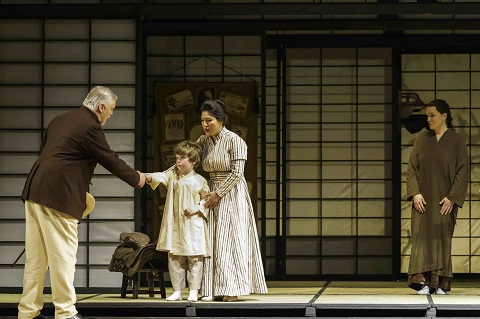 David Kempster (Sharpless), Karah Son (Cio-Cio-San - from an earlier performance in the run), Rebecca Afonwy-Jones (Suzuki). Photo credit: Jeremy Abrahams.
David Kempster (Sharpless), Karah Son (Cio-Cio-San - from an earlier performance in the run), Rebecca Afonwy-Jones (Suzuki). Photo credit: Jeremy Abrahams.
Similarly, Richard Wiegold’s Bonze was a figure of pantomime-esque ‘menace’, and Yakuside’s drunken exploits (exuberantly delivered by George-Newton Fitzgerald) were a caricature of the ‘wedding guest from hell’. Yamadori (Alastair Moore) was no imperious, regal suitor: carried in by two lackeys who struggled to bear the weight of his sedan chair, his entrance was less than stately and imposing, and vocally Moore conveyed little overbearing arrogance. David Kempster’s Sharpless was similarly lacking in definition and presence, his phrases requiring more strength and character. When Butterfly related her tragic tale, this Sharpless - arms tucked behind his back - seemed unmoved, and later emotional displays seemed little more than clichéd affectation. Butterfly’s son (Haydn Morgan Lockwood) provided the requisite ‘cuteness’ but - even allowing for theatrical licence and suspension of disbelief - it was hard to believe that this near-shoulder-high lad was a mere three years old.
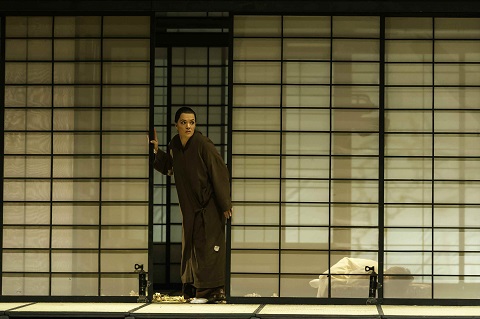 Rebecca Afonwy-Jones (Suzuki). Photo credit: Jeremy Abrahams.
Rebecca Afonwy-Jones (Suzuki). Photo credit: Jeremy Abrahams.
The performance was ‘saved’ by some sterling vocal commitment and delineation by several of the principals. Simon Crosby Buttle’s Goro was less overtly rapacious and ‘evil’ than is sometimes the case, but his excellent diction and poker-straight demeanour conveyed a frightening self-possession and power. Rebecca Afonwy-Jones was a superb Suzuki, her rich voice strong in all registers, the phrasing well-judged. This Suzuki was not in awe of her mistress; instead she lamented and raged at her misconceptions. When Cio-Cio-San announced that she had been to the Mission to convert to her new husband’s ‘faith’, Suzuki bowed her head to the floor in abjection and appeasement to her own gods; and, she possessively snatched up the spirits of Butterfly’s ancestors which Pinkerton so crudely dismisses as ‘puppets’, recognising her mistress’s tragic error.
Paul Charles Clarke’s ignorant, cloddish Pinkerton was lacking in allure, as the production seems to demand - as when he petulantly clapped his hands, to get the faux marriage rituals over and done with. More disappointingly, his vocal phrasing was sometimes inelegant as he forced his tenor somewhat emphatically, struggling to carry across the WNO Orchestra - who played accurately and articulately, but who were over-encouraged at times by conductor Andrew Greenwood.
But, Judith Howard’s Cio-Cio-San grew in sympathetic stature as the performance progressed. Though there were initially a few giggles when she declared her years of age to be more than 10 and less than 20, once she’d untied the cheap butterfly clips holding up her hair, Howard acquired more grace, even though she was dressed for Act 2 in a shapeless dress that was more Victorian governess’s dowdy gown than the plainest kimono. Howard had the vocal stamina for the role, and real strength and grace at the top, though her lower-pitched passages carried less well. ‘One Fine Day’ was movingly shaped, and while Pinkerton lacked forthcoming warmth in their Act 1 ending duet, Howard’s lines gleamed with hopefulness.
The final moments failed to convince, although Cio-San-San’s heroic self-sacrifice was beautifully lit (original lighting design by John Waterhouse), her son shielded from her violent end by the opacity of a screen. Why would Kate Pinkerton grab the child and run off, flinging his treasured teddy bear to the ground? Why would Suzuki chase after her, rather than rush to her dying mistress’s side?
Overall, the drama felt slow - and at just over three hours, this was a long running time. At times, there was an unfortunate amateurishness to the choreography and acting, but the strong singing of Howard and Afonwy-Jones lifted the performance to emotionally moving peaks. In any case, the punters seemed delighted.
Claire Seymour
Puccini: Madame Butterfly
Cio-Cio-San - Judith Howard, Lieutenant Pinkerton - Paul Charles Clarke, Goro - Simon Crosby Buttle, Suzuki - Rebecca Afonwy-Jones, Sharpless - David Kempster, Bonze - Richard Wiegold, Prince Yamadori - Alastair Moore, Kate Pinkerton - Sian Meinir, Yakuside (Uncle) - George Newton-Fitzgerald, Cousin - Meriel Andrew, Mother - Monika Sawa, Aunt - Sawa, Imperial Commissioner - Martin Lloyd, Official Registrar - Jack O’Kelly, Trouble (Cio-Cio-San’s child) - Haydn Morgan Lockwood, Cousin’s child - Joshua Barnfield, Servant and Cook - David Tilley & Derek Tilley, Geishas/Relations/Monks/Servants/Sailors - WNO Chorus.
Director - Joachim Herz, Revival director - Sarah Crisp, Conductor - Andrew Greenwood, Designer - Reinhart Zimmermann, Costume designer - Eleonore Kleiber, Lighting designer - John Waterhouse, WNO Orchestra.
Birmingham Hippodrome; Friday 30th June 2017.
image=http://www.operatoday.com/wnomadambutterfly-karahsoncio-cio-sanleoadamstroublerebeccaafonwy-jonessuzuki-178_01.jpg image_description=Madame Butterfly, Welsh National Opera at the Birmingham Hippodrome product=yes product_title=Madame Butterfly, Welsh National Opera at the Birmingham Hippodrome product_by=A review by Claire Seymour product_id=Above: Waiting for Pinkerton, Act 2Photo credit: Jeremy Abrahams
The sands of time: WNO's Rosenkavalier in Birmingham
The production has made its way from Cardiff to Birmingham. During the orchestral prelude, designer Niki Turner and lighting designer Ian Jones dot the dark stage with a haze of swirling green which embraces a lone figure, a dignified, elderly lady in a beige dress, seated at a small round table, elegantly sipping tea from a china cup. Through a gauze, as Strauss’s instrumental narrative declares its sensuality with cocksure confidence, the erotic playfulness it depicts fades in and out of view: an arching back, a flash of black stockings amid the white bedding.The words ‘Wien 1941’ come into focus on the back-drop, like the flickering subtitles of an old movie. With gradual illumination, the set comes into focus and time recedes - ‘Wien 1911’. We are in the Marschallin’s plain white bedroom, but the low light hints at the shabbiness that the passing of thirty years will bring. The drooping chandelier evokes the glistening grey of a spider’s web.
The old duchess remains: a Dickensian ‘ghost of time yet to come’, haunting the present with presentiments of the future. And, during the lively teasing of the first scene as Octavian exults in his secret tryst with his ‘Bichette’, it is the Marschallin’s sudden, fleeting encounter with this disturbing alter ego who paces the rim of the room, that brings the first note of sadness to the lovers’ indulgence of their desire.
Later, during the Marschallin’s morning levée, the lingering presence of the gracious old dame amid the helter-skelter raucousness of the milliner, bird-catcher, lawyer, pleading orphans and hair-dressers adds pathos to the riotousness which intrudes into the boudoir. When Rebecca Evans’ Marschallin inspects her coiffeuses’ efforts in a gold-rimmed hand mirror, her alarm - ‘Why, today you’ve made me look like an old lady!’ - inspires tenderness and pity.
The orphans’ hasty elocution lesson, and Baron Ochs’ haughty pique when the lawyer disillusions him about the potential profitability of his marriage contract, sugar the scene with a patina of humour. But, it is the stillness of the Italian singer’s serenade - as elegantly shaped by Paul Charles Clarke as the singer’s red velvet tail-coat - which confirms the underlying sadness. When a waiter pulls out a chair for the Marschallin, for a moment it seems that it is the old countess who will seat herself, usurping her younger self.
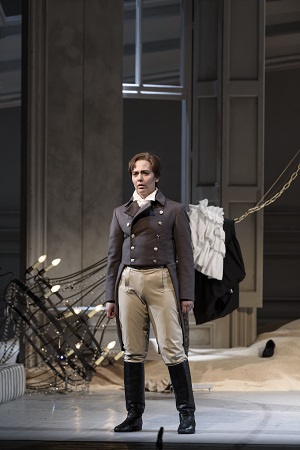 Octavian (Lucia Cervoni). Photo credit: Bill Cooper.
Octavian (Lucia Cervoni). Photo credit: Bill Cooper.
Sorrow pervades the final scene of the Act, almost painfully entwining with the beauty of Strauss’s score. When Octavian laments that his beloved is changed from the one he knew, the Marschallin is distracted by the ghost that only she can see. We thus feel compassion for the petulant Quin-Quin who kicks the bed in frustration and bewails, ‘Can I no longer kiss you until you gasp for air?’, as the sands of time trickle from the ceiling in two fragile golden streams. The Marschallin’s sudden realisation that she has brusquely sent away her young lover without even giving him a kiss is heart-breaking, but when the footmen are too late to call the young count back and perpetuate the enchantment of present desire, she allows the spell to break. The filter of sand has ceased. The illumination falls upon the seated elderly figure: this is the reality that in the closing moments the Marschallin tenderly accepts and embraces.
Fuchs’ sensitive crafting of the sentiment of this opening Act is utterly convincing, and it is aided by the characterisation of the central lovers. Lucia Cervoni’s Octavian is naïve and impetuous but genuinely devoted; her mezzo is wonderfully firm and clean, full of youthful freshness. Handsome in a red-trimmed grey frock, Octavian bursts with an adolescent swagger - collar turned up, sword stabbing the floor between his legs - which is softened by Cervoni’s warm lyricism.
Evans is initially a more playful Marschallin than is sometimes the case, and as they frisk spiritedly, and Octavian adopts his Mariandel disguise, the scene seemed imbued with the light-hearted impishness of Cherubino and the Countess in Act 2 of Figaro. But the fullness and rich layers of Evans’ soprano hint at a burgeoning maturity, one which overtakes her Marschallin when she least expects it. When she gives her Quin-Quin the silver rose, Evans’ soprano is a gleaming, soft thread, as beautifully scented as the rose itself. Telling of her night-time wandering around the Feldmarschal’s chateau, to turn off the clocks, Evans soprano lowers, and slows, with quiet melancholy and resignation.
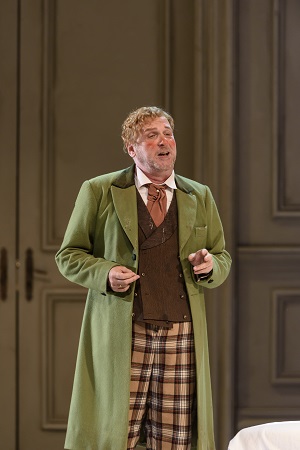 Baron Ochs (Brindley Sherratt. Photo credit: Bill Cooper.
Baron Ochs (Brindley Sherratt. Photo credit: Bill Cooper.
The arrival of Brindley Sherratt’s tartan-trousered Baron Ochs prevents sentiment turning to sentimentality in this opening act. Heralded by hints of pink and green light which fleck the bedroom walls - indicative of his crudely rouged cheeks and lime-green coat - this Ochs is a bore, a boor and a bear, lurching lecherously with a dirty grin, but Sherratt never turns him into a clown. Ochs is full of beans, but though Sherratt’s bass does not offer soft warmth to alleviate the overconfidence and brashness, the voice is immensely strong, his lines are finely crafted, the diction superb, and that this Ochs will so obviously endure disappointments and humiliations ensures our indulgence of his faults.
A row of gilded chairs guarded by mustard-liveried retainers transforms the private bedroom to Faninel’s public reception room at the start of Act 2. The grand entrance doors are replaced by fireplace from whose grate tumble the unstoppable sands of time, piling ever higher. Louise Alder’s Sophie can barely contain her excitement, almost hyperventilating with glee as she prances and preens in anticipation of the pomp and honour to come.
Bespectacled and clutching a book to her breast, Alder’s Sophie put me in mind of Cecily from Wilde’s The Importance of Being Earnest - another impassioned ingénue, eager to cast aside her ‘horrid German lessons’ for dalliance with the dashing ‘Ernest’. And her companion Marianne Leitmetzerin, sung with vigour and colour by Angharad Morgan, was a veritable Miss Prism, reprimanding her over-zealous charge but gushing animatedly as she espied the rose-bearer’s arrival - dressed in silver from top to toe - as if she were gleaning racy material for a three-volume novel.
The presentation of the rose was exquisite: I don’t think I’ve ever heard it better sung. Conductor Tomáš Hanus seemed to set off a little fast at first, leaving Cervoni behind, but in fact the flowing pace perfectly suited the escalating emotional pitch. I struggle to find a word to describe Alder’s glorious vocal ascents: they did not soar, float or climb, rather her soprano seemed suddenly to inhabit a sublime peak as if it had been there for eternity and we, in our mundanity, had simply not heard its transcendent song. Alder can swell or retreat from the fullest glow to the most delicate thread with stunning ease, and as so often in this production it was the juxtaposition of dramatic exuberance with musical serenity that spoke so powerfully. The conversation between the would-be bride and the Rosenkavalier which follows was funny and earth-bound: these were real people, stumbling for the ‘right’ words, bearing their hearts on their sleeves.
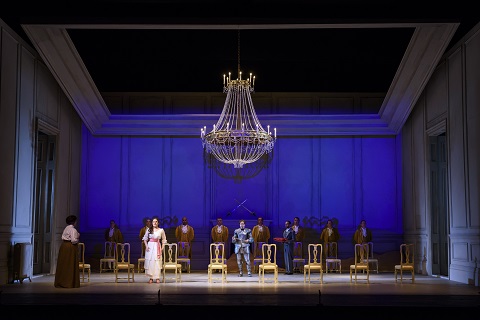 Act 2: Company. Photo credit: Bill Cooper.
Act 2: Company. Photo credit: Bill Cooper.
The scene was a perfect foil for Ochs’ ill-mannered arrival. The loutishness of Lerchenau and his coarse retinue was perfectly judged, the waltzes tinged with just the right touch of loucheness, Ochs’ puffed-up pomposity balanced with pouting injured pride. Even Madeleine Shaw’s lascivious Annina squirmed in his embrace, as she and Peter Van Hulle’s vicious Valzacchi stirred up trouble.
But, at the close, believing that Mariandel was eagerly awaiting his answer about a nocturnal assignation, the reinvigorated Ochs’ final reprise - with him, no night can be too long - was superbly judged. The final phrase lingered just long enough for us to feel pity for his delusion, so soon to be deflated but, Sherratt suggested, never to be fully expunged. Sleazy lecher he may be, but Sherratt made this Ochs utterly compelling. Adrian Clarke’s Herr von Faninal was equally convincing, as lyrical in affection for his daughter as he was in, first, bewilderment, then anger.
Fuchs and Turner swept us through the drama of the final act with an equally sure hand. The damage wrought by the inexorable accumulation of sand is used to convey the transfer from civilised chateau to unsavoury tavern: the ceiling sags, all that remains of the walls are the towering door frames - relics of former glory like Ozymandias’ ‘vast and trunkless legs of stone’ and crumbling pedestal. The scenes of Ochs’ humiliation are crowded but well-choreographed, with Valzacchi and Annina cavorting about with commedia-like charm.
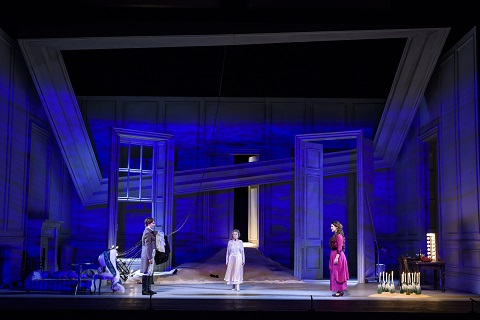 Octavian (Lucia Cervoni), The Old Marschallin (Margaret Baiton), Sophie (Louise Alder). Photo credit: Bill Cooper.
Octavian (Lucia Cervoni), The Old Marschallin (Margaret Baiton), Sophie (Louise Alder). Photo credit: Bill Cooper.
The final trio did not disappoint as Alder, Cervoni and Evans surged through the phrases with strength and sublimity, accompanied - as throughout - by the sensuous, sympathetic playing of the WNO Orchestra. The Marschallin’s dignified retreat was balanced by the courtly return of her future self; unseen by the young lovers, she watched their embraces and listened to their exquisite pianissimo interweavings with genteel acquiescence.
Fuchs’ final coup is masterly. It’s becoming common for directors to seek an alternative to the convention that the opera’s capricious coda should depict the mischievous re-appearance of the Marschallin’s page Mahomed, in search of Sophie’s lost handkerchief. At the ROH last December , for example, Robert Carsen slid back the walls and revealed a haunting vision of the bloody fields of WW1, a row of ghostly soldiers, headed by the Feldmarschall, shrouded in ashen mist.
Fuchs offers us a more comforting acceptance. Mohammed, himself exhibiting the grey progress of age, shuffled with the aid of a walking stick, but with slow grace, towards the seated Marschallin, bearing a silver salver. Her regality undimmed by time, she accepted the china tea cup with a forgiving smile. A small gesture, but one which drew us all - poignantly, consolingly - into the Marschallin’s recognition and reconciliation.
Claire Seymour
Richard Strauss: Der Rosenkavalier
The Marschallin - Rebecca Evans, Octavian - Lucia Cervoni, Sophie - Louise Alder, Baron Ochs - Brindley Sherratt, Herr Faninal - Adrian Clarke, Valzacchi - Peter Van Hulle, Annina - Madeleine Shaw, Marianne Leitmetzerin - Angharad Morgan, Mohammed - Kayed Mohamed-Mason, Major-Domo to the Marschallin - Adam Music, Major-Domo to Faninal - Gareth Dafydd Morris, Milliner - Emma Mary Llewellyn, Animal Seller - Michael Clifton-Thompson, Lawyer - Alastair Moore, Italian Singer - Paul Charles Clarke, Landlord - Michael Clifton-Thompson, Commissar of Police - Matthew Hargreaves, Boots - Laurence Cole, Leopold (Ochs’ illegitimate son) - George Newton-Fitzgerald, Old Marschallin - Margaret Baiton, Footmen - Simon Crosby Buttle/Stephen Wells/Joe Roche/Laurence Cole), Waiters - Simon Crosby Buttle/Howard Kirk/Philip Lloyd-Evans/Alastair Moore, Noble Orphans - Anitra Blaxhall/Louise Ratcliffe/Helene Jarmany, Maids/Footmen - WNO Chorus.
Director - Olivia Fuchs, Conductor - Tomáš Hanus, Designer - Niki Turner, Lighting designer - Ian Jones, Orchestra of WNO.
Birmingham Hippodrome; Saturday 1st July 2017.
image=http://www.operatoday.com/wno_der_rosenkavalier_-_rebecca_evans_the_marschallin_margaret_baiton_the_old_marschallin_photo_credit_bill_cooper_1110.jpg image_description=Der Rosenkavalier, Welsh National Opera at the Birmingham Hippodrome product=yes product_title=Der Rosenkavalier, Welsh National Opera at the Birmingham Hippodrome product_by=A review by Claire Seymour product_id=Above: Marschallin (Rebecca Evans), Old Marschallin (Margaret Baiton)Photo credit: Bill Cooper
July 1, 2017
A French double-bill at the Royal College of Music
Neil Warmington’s simple designs, illuminated by the mauve glow of Ben Ormerod’s lighting, emphasised the artifice and duality of Poulenc’s quasi-comic strip capers. A proscenium within the Britten Theatre’s own proscenium set the action at one remove; a door-opening at the rear led to nowhere in particular. The snakes of Gauloises smoke wafting above the café table, where two flaneurs supped Bordeaux, suggested a Parisian locale, but the graffiti, Paris ou Zanizibar?, injected a note of doubt and disconnection. Indeed, a disreputable duo, Lacouf and Presto - sung by Thomas Erlank and Timothy Edlin, respectively, with vaudevillian charm - have a fatal argument about their location, their deaths prompting a grand chorale epitaph which here was majestically melodious and morose.
Apollinaire’s zany tale is designed to defy logic. A French housewife, Thérèse, is bored of her duties as a woman and wife, and expresses her defiance by relieving herself of the emblem of her oppression, her breasts, which have turned into balloons and are swiftly punctured. She grows a beard, transforms herself into a man and, empowered by her new masculinity, sets out to conquer the world as ‘Tirésias’. In bewilderment and outrage, her husband, Le Mari, determines to effect his own sexual reversal, dons a floral frock and fathoms out how to spawn his own brood - all 40,000 of them … in a single day. He hits the headlines and the successful careers of his offspring bring him a tidy fortune.
Things turn sour, though, when a Parisian reporter tries to swindle him and a gendarme accuses his children of being the cause of famine among the people of Zanzibar. The intervention of a Fortune Teller adds to the zany mix: she foresees the death of the gendarme, then promptly fulfils her own prophecy by strangling him. It’s Tirésias in disguise, seeking reconciliation with her Husband. The ‘happy’ conclusion prompts a chorus for the people of Zanzibar calling upon the audience to go forth and multiply.
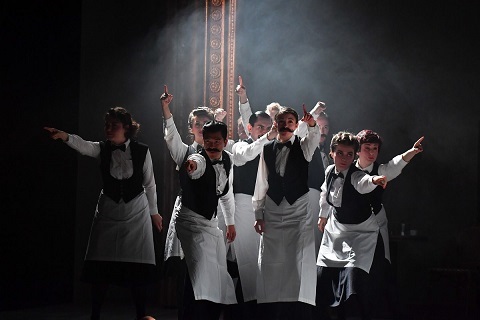 Les mamelles de Tirésias, Ensemble.
Les mamelles de Tirésias, Ensemble.
It must have been good propaganda for the post-war French government hoping to extol the virtues of large families and convince the populace that it was their patriotic obligation to increase the birth-rate. Indeed, the three-part overture - a parody of the Baroque - began ‘outside the frame’, with Kieran Rayner’s orotund Theatre Director stage reminding us of our demographic duties in times of war.
The score is a good choice for a student ensemble for the piece does not require voices of heroic stature but it does need an adaptable cast who can capture the youthful exuberance and deceptive lightness of the drama. It also needs a sterling Thérèse to initiate the absurdities and sustain the (in)credibility of the ensuing preposterousness, and in Harriet Eyley, the RCM were blessed with a fine singing actress who projected imposingly but with a vocal warmth which assuaged some of Thérèse’s feisty unreasonableness. The challenging coloratura was sung with penetrating precision and a sparkle of panache.
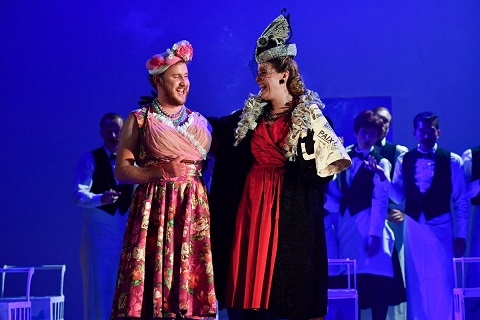 Julien Van Mellaerts (Le Mari), Eleanor Penfold (Elegant Lady).
Julien Van Mellaerts (Le Mari), Eleanor Penfold (Elegant Lady).
As Le Mari, New Zealander Julien Van Mellaerts displayed the characteristic ‘open, engaging tone’ and ‘muscularity and vitality’ that I’d enjoyed at the Kathleen Ferrier Award Final earlier this year. Van Mellarts delighted in the grotesqueries and improbabilities, and the brightness and power of baritone enabled Le Mari to hold his own against his wife’s feminist proselytising. His natural flair for comedy was shared by those in the secondary, largely generic roles, with James Atkinson perfecting the gendarme’s gesticulations and Benedict Hymas capturing the reporter’s rapaciousness.
Michael Rosewell conducted a clean and accurate rendition of Poulenc’s explosive score, which charmed in the lyrical episodes but needed a bit more drive and rhythmic bite to convince in the brassy burlesque.
As director Stephen Unwin twirled his cast through the chaotic sequence of scenes, some of the choreography was a little rough and ready, but the gentle clumsiness had its own charm and this production captured Poulenc’s delightful irreverence - the composer relished the response to the premiere, reporting that “a part of the audience brings the house down with enthusiasm but the Puccini fans in the gods are outraged”.
This was a colourful and exuberant performance, but some of the opéra bouffe’s restlessness remained elusive. For, beneath the frivolous inconsequentiality there’s a lingering spirit of melancholy. Apollinaire had recreated a war-torn Montmartre, in which desire and destitution balanced on a knife-edge; writing in the post-WW2 years, Poulenc too evokes the calamitous recent past beneath the comic absurdities. The score’s historic allusions - to Offenbach, Ravel, Chabrier, even to the original incidental music by Germaine Albert-Birot which had accompanied Apollinaire’s play - somehow seem to deepen the nostalgic despondence, despite their frothy musical articulation.
The ‘action’ of Chabrier’s one-act, three-hander, Une éducation manqué, takes place on the wedding night of an ingénue bride and her fresh-faced groom whose education unfortunately has been defective - for his tutor-mentor, Pausanias, has taught him everything from theology to trigonometry but has neglected the finer ‘arts’ of nuptial etiquette.
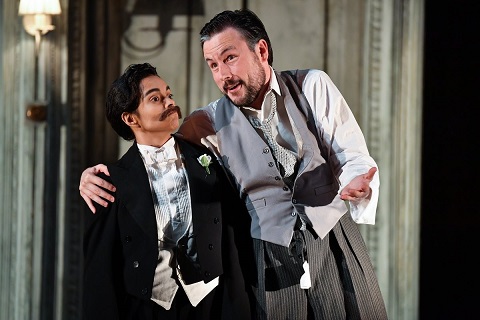 Julieth Lozano (Gontran) and Kieran Rayner (Pausanias).
Julieth Lozano (Gontran) and Kieran Rayner (Pausanias).
It’s a slight piece but not without a musical elegance which was matched by Warmington’s simple chateaux-chic style, complete with a central window-seat from which the frustrated groom could gaze at the moon and reflect with mournful grace on the mysterious of marital engagement. There wasn’t much of a frisson between Julieth Lozano’s Gontran de Boismassif and his bride, Hélène de la Cerisaie, sung by Rosanna Cooper, which contributed to the deadening deadlock of the drama, but Cooper’s mezzo bloomed richly and Lozano exhibited vocal vivacity and a lively stage presence. Kieran Rayner took the role of the hapless tutor and his tricky patter number with his mentee was deftly delivered.
When a storm broke out, the artless newlyweds proved more threatened by the thunderous crashes than thoughts of sexual initiation. As they sought comfort in each other’s arms, one couldn’t help but have a twinge of nostalgia for carefree days of adolescent love.
Claire Seymour
Chabrier, Une éducation manqué: Gontran - Julieth Lozano, Héléne - Rosanna Cooper, Pausanias - Kieran Rayner.
Poulenc, Les mamelles de Tirésias: Theatre Director - Kieran Rayner, Thérèse/Tirésias - Harriet Eyley, Husband - Julien Van Mellaerts, Monsieur Lacouf - Thomas Erlank, Monsieur Presto - Timothy Edlin, Gendarme - James Atkinson, Newspaper Vendor - Ashlyn Tymms, Reporter - Benedict Hymas, Son - Stephen Mills, Elegant Lady - Eleanor Penfold, Woman - Laura Hocking, Bearded Gentleman - Conall O’Neill, Chorus (Isabelle Atkinson, Alice Bell, Jacob Bettinelli, Dominic Bevan, Laura Hocking, Barbara Jop, Stephen Mills, Conall O’Neill, Eleanor Penfold, Davidona Pittock).
image=http://www.operatoday.com/Poulenc%204.jpg image_description=Les mamelles de Tirésias, Royal College of Music product=yes product_title=Les mamelles de Tirésias, Royal College of Music product_by=A review by Claire Seymour product_id=Above: Harriet Eyley (Thérèse)